
Londen (Engeland) 2015
#birds #engeland #england #foto #fotografie #londen #london #nature #natuur #photo #photography #vogels
Originally posted at: https://blog.ernste.net/2022/04/25/roodborstje-2/
9 Likes
1 Shares

Londen (Engeland) 2015
#birds #engeland #england #foto #fotografie #londen #london #nature #natuur #photo #photography #vogels
Originally posted at: https://blog.ernste.net/2022/04/25/roodborstje-2/
Seit 1952 ist Queen Elizabeth II. eine britische Institution und meistert mit Würde und Ausdauer alle Krisen - politischer oder auch familiärer Art. Ihren 96. Geburtstag feiert sie im kleinen Kreis.#QueenElizabethII #Queen #Royals #70Thronjubiläum #britischesKönigreich #Commonwealth #England #Königin #Elizabeth #Jubiläum
Queen Elizabeth II. wird 96 | DW | 21.04.2022
 St Michaels Mount, Cornwall - Aerial
St Michaels Mount, Cornwall - Aerial
by Darren&Ness
St Michael's Mount (Cornish: Karrek Loos yn Koos, meaning "hoar rock in woodland") is a tidal island in Mount's Bay, Cornwall, England, United Kingdom. The island is a civil parish and is linked to the town of Marazion by a causeway of granite setts, passable between mid-tide and low water. It is managed by the National Trust, and the castle and chapel have been the home of the St Aubyn family since approximately 1650.
Historically, St Michael's Mount was a Cornish counterpart of Mont-Saint-Michel in Normandy, France (with which it shares the same tidal island characteristics and the same conical shape, though it is much larger, at 57 acres [23 ha], than Mont St Michel which covers 17 acres [6.9 ha]).
Pictured: ‘Seafire’ war plane flies again 49 years after being hauled out of scrapyard
Pictured: ‘Seafire’ war plane flies again 49 years after being hauled out of scrapyard
The aircraft, discontinued in 1953, was found in a derelict state in Warrington and restored to its former glory
By Will Bolton 6 April 2022 • 6:56pm
The Seafire MKXVII was flown at RNAS Yeovilton, Somerset on Tuesday
The Seafire MKXVII soars above Somerset on Tuesday Credit: JAY WILLIAMSA Seafire war plane has taken to the skies again, 49 years after being hauled out of a scrapyard in a derelict state.
The Seafire MKXVII was flown at RNAS Yeovilton, Somerset, on Tuesday after it became the latest addition to the Navy Wings Heritage Centre.
The aircraft is the Royal Navy version of the Spitfire and this is the only airworthy MkXVII and one of only two flying Seafires in the world.
The Seafire was discontinued in 1953 and this particular model was scrapped around the same time.
The Seafire was flown at RNAS Yeovilton, Somerset Credit: JAY WILLIAMS
It was not until 1973, almost 20 years later, that it was re-discovered in a derelict state in a scrapyard in Warrington by Peter Arnold, a Spitfire historian.
In 2001, the plane was purchased by Tim Manna, a former US Navy pilot, and restored to full flying condition by Kennet Aviation at North Weald.
In November 2021, Navy Wings, which works to preserve Britain’s naval aviation heritage, bought the aircraft.
Vor über zwanzig Jahren floh der Kosovo-Albaner Zeqirja Zeka mit seiner ukrainischen Frau Jana und ihren Kindern vor dem Kosovo-Krieg. Jetzt sind Janas Mutter und ihre Geschwister auf der Flucht - vor Putins Invasion.#Ukraine #Kosovo #Russland #Krieg #Flucht #England #Großbritannien
Der zweite Krieg der kosovarisch-ukrainischen Familie Zeka-Michailenko | DW | 22.03.2022
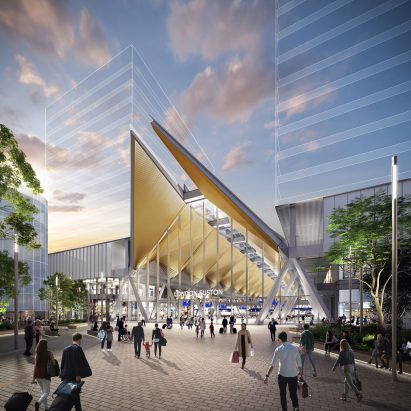
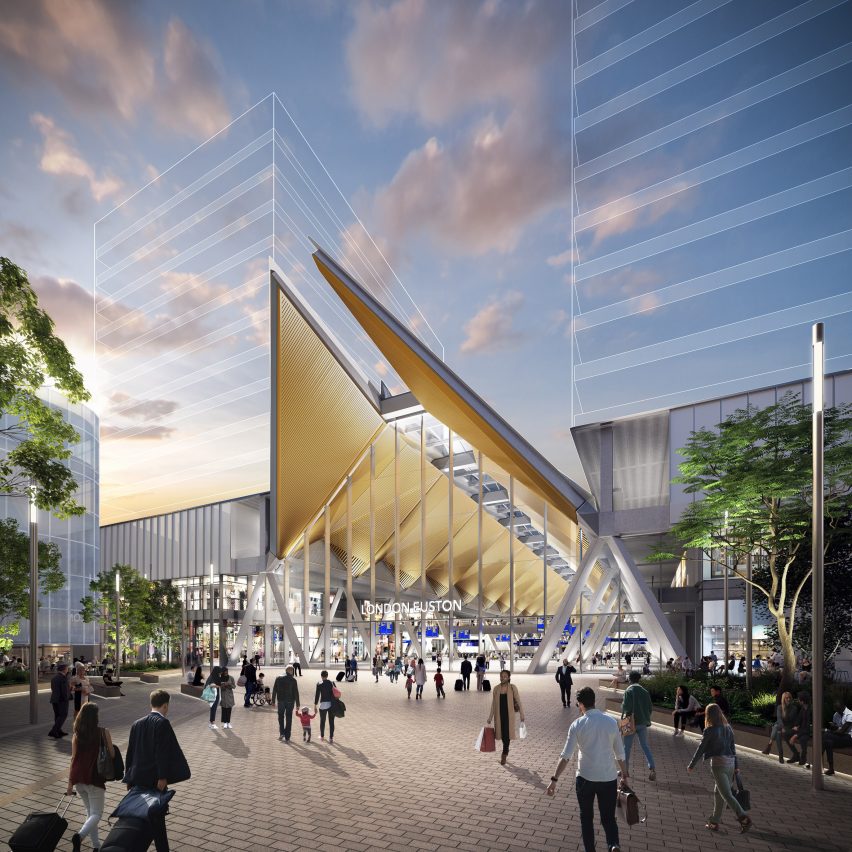
Architecture firm Grimshaw has designed a "bold geometric roof" in its latest plans to bring HS2 high-speed railway to London's Euston station.
Grimshaw is partnering with engineering firms Arup and WSP on the overhaul of Euston, which will transform the railway station into a major high-speed railway terminus.
Set over three levels, the expanded station will feature the largest station concourse in the UK and will be served by up to 17 high-speed trains per hour.
The designs have significantly changed from visuals released in 2018. The new addition of a folded, angular roof is intended to give the station a distinct identity while also allowing natural light to flood the interior.
Roof components will be prefabricated off-site and installed using modular construction technologies, to help reduce carbon emissions, lower costs and minimise disruption to the existing railway service.
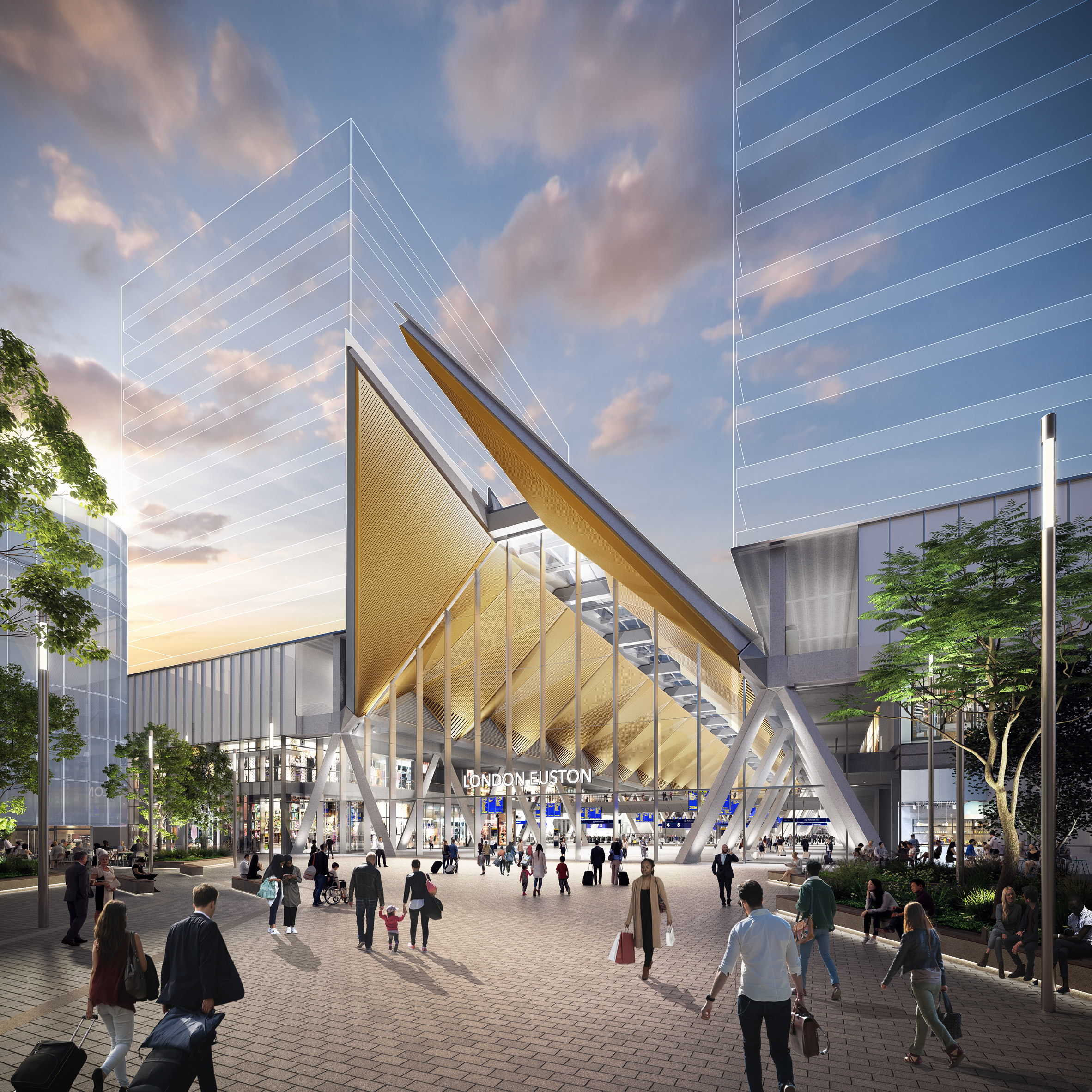 Grimshaw's latest design features a "bold geometric roof"
Grimshaw's latest design features a "bold geometric roof"
The HS2 train platforms will be set below ground level, freeing up the station hall to become a 300-metre-long public concourse that links with public plazas and gardens to both the north and the south.
Retail spaces will be provided on both the ground and first floors.
"The scale of the new HS2 London Euston station means we have the opportunity to create a new truly public civic space for London, a place that responds to transport and passenger needs and becomes part of the existing urban fabric and community," said Declan McCafferty, partner at Grimshaw.
"The 300-metre long station hall sits at the heart of this approach, creating a space that is permeable, accessible and open and connects to the local streets and neighbourhoods through green, pedestrian-oriented spaces."
Major gateway to north and midlands
The works will position Euston as a major gateway to destinations in the midlands and the north.
The HS2 station will feature 10 subsurface platforms, while the existing Network Rail station will remain in operation.
[ 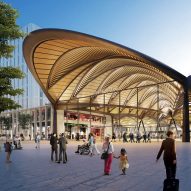
There will also be a new London Underground ticket hall connecting both Euston and Euston Square Tube stations, providing links to the Northern, Victoria, Circle, Hammersmith and City and Metropolitan Lines.
Entrances will be located on the north, south and west sides of the station, and will be linked to new cycle routes and 2,000 cycle parking spaces.
Euston Square Gardens will be upgraded and a new public green space will be created to the north. Housing provision is also included within the plans.
Opportunity for "a new piece of the city"
"HS2's London Euston station is one of the most complex parts of the HS2 route, situated in a densely populated residential area and adjacent to a busy operational railway," said Laurence Whitbourn, Euston area client director at HS2.
"HS2 Ltd is absolutely committed to getting Euston right, engaging with the local community and stakeholders as we continue to progress our designs," he continued.
"With the arrival of HS2, Euston is fast becoming one of the largest transport-led regeneration projects of the 21st century. Across a site of over 60 acres we have the unique opportunity to work with stakeholders and partners to create a new piece of the city creating thousands of jobs, new homes and areas of green public space."
Building work will be carried out by MDJV, a partnership between contractors Mace and Dragados.
The station will be built in a single phase to reduce the length of the construction period. The target is to achieve a BREEAM outstanding sustainability rating.
Public consultation begins
The project will go through an 18-month period of public consultation before it progresses.
"The arrival of HS2 at Euston provides a once in a lifetime opportunity to create an iconic destination in the area, that will help us build back better by growing not just the economy of London but that of the UK," said Andrew Stephenson, the government's HS2 minister.
[ 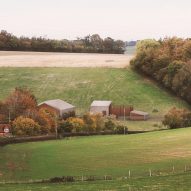
](https://www.dezeen.com/2021/02/08/hs2-ventilation-shaft-chalfont-st-giles-chilterns-grimshaw/)
"This station will not only benefit the local community by enabling the comprehensive redevelopment of the area but will serve as a transport super hub acting as a gateway to the midlands and the north – enabling us to deliver better railways across the nation sooner than under previous plans," he said.
Once complete, HS2 will provide high-speed connections between the UK's four biggest cities, London, Birmingham, Manchester and Leeds. It will also connect the towns of Crewe and Wigan.
Other structures being created for the network include the Water Orton viaducts, designed by Weston Williamson + Partners to sit above a "community-led orchard", and a ventilation shaft disguised as a barn, designed by Grimshaw.
The post Grimshaw's latest design for London Euston HS2 station revealed appeared first on Dezeen.
#all #architecture #news #infrastructure #london #grimshawarchitects #uk #england #highspeedtwohs2
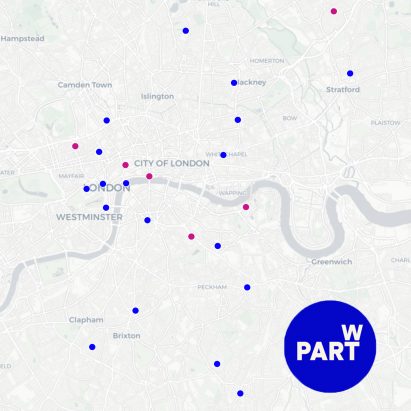
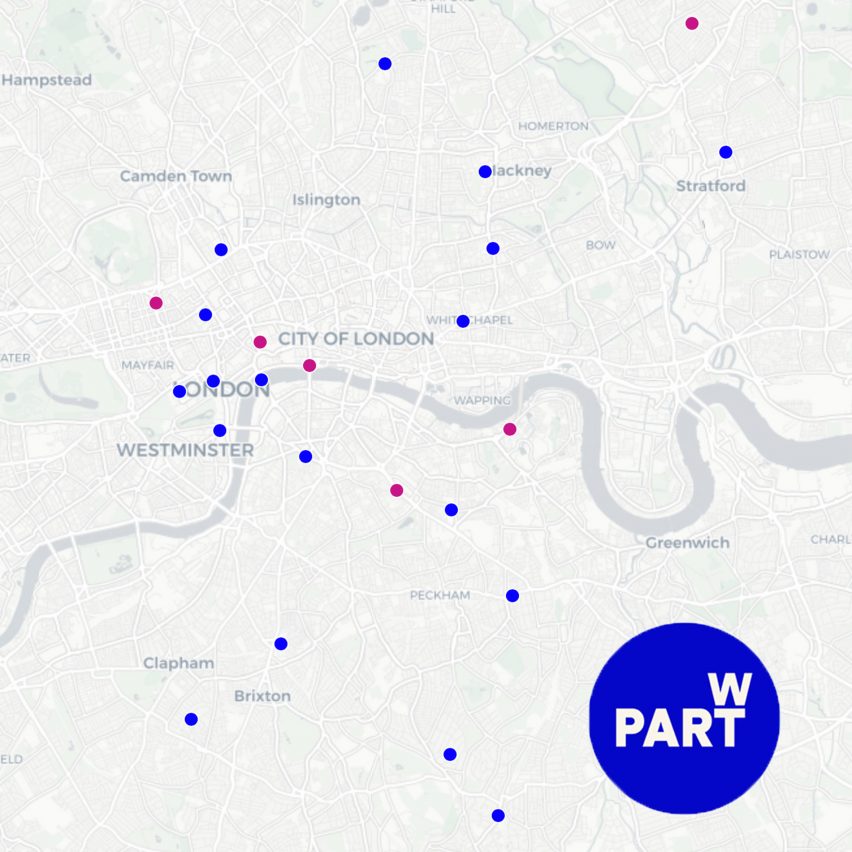
To coincide with International Women's Day architecture collective Part W has launched a campaign to populate a map titled Women's Work: London.
Part W will be crowdsourcing suggestions to add to Women's Work: London over the next month, with the physical map set to be released later this year.
The group launched the map project to help draw attention to the numerous buildings designed and created by women in the city.
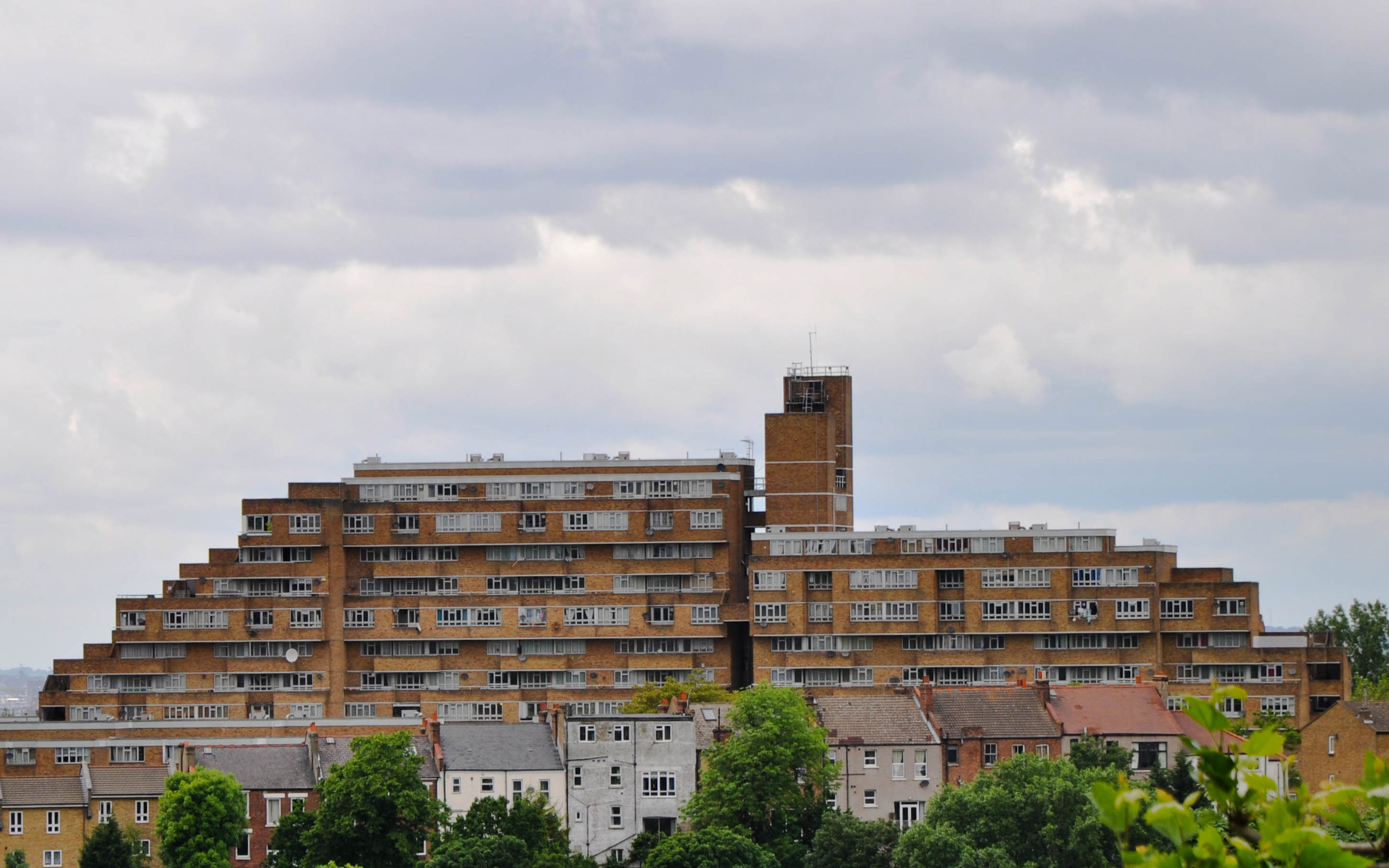 Top: Part W is mapping projects in London created by women. Above: Dawson's Heights, designed by Kate Macintosh, will be included
Top: Part W is mapping projects in London created by women. Above: Dawson's Heights, designed by Kate Macintosh, will be included
"For too long the work of women in design has been undervalued and the contribution of women has not been accounted for in mapping studies, written texts and in studies that promote role model examples of who designs our cities," said Part W founder Zoë Berman.
"We aim to draw attention to built projects by women that have not gained the recognition they deserve," she told Dezeen.
The project will build on a map highlighting 20 buildings in London created by women, which was made for the How We Live Now: Reimagining Spaces with Matrix Feminist Design Co-operative exhibition at the Barbican last year.
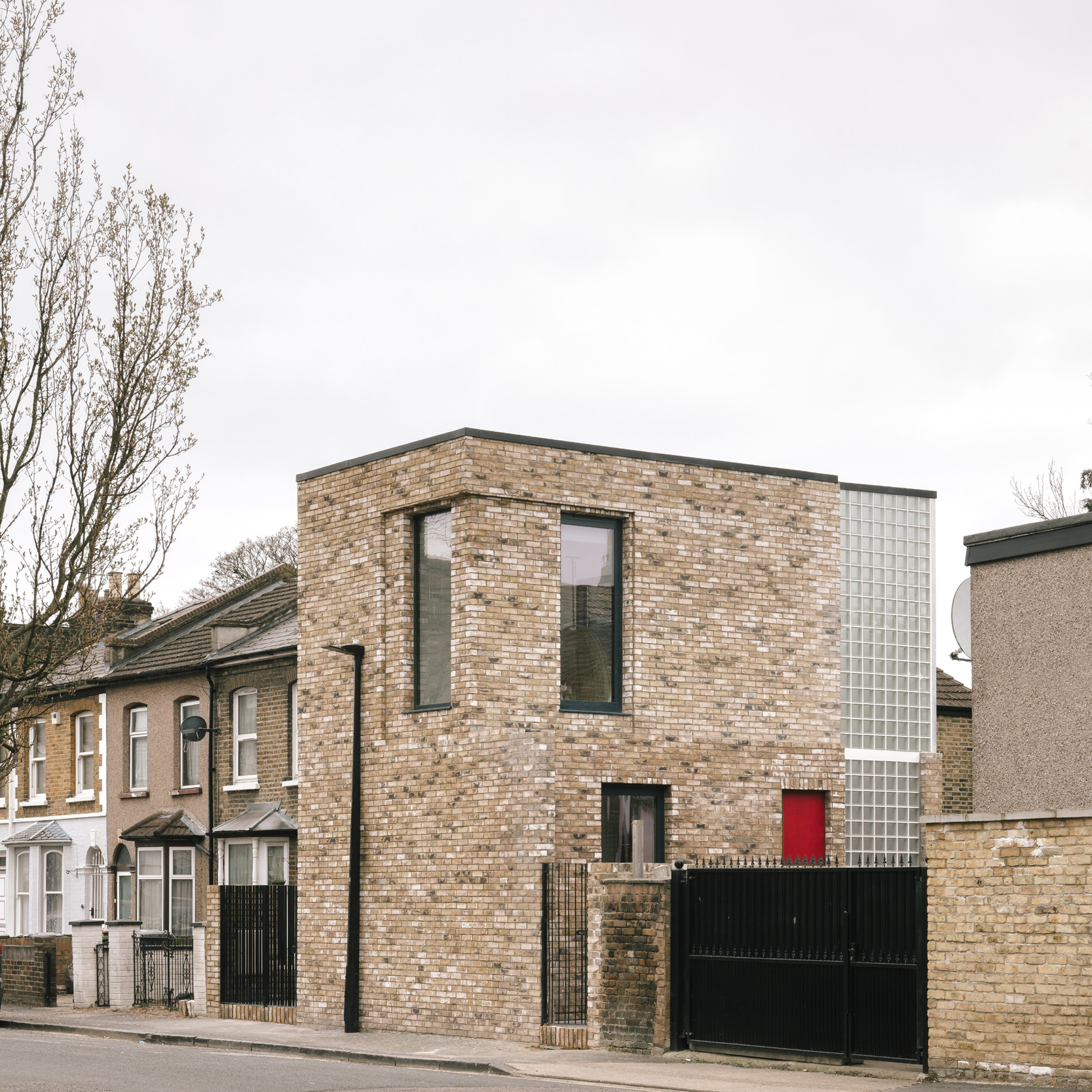 Maryland House by Remi Connolly-Taylor will also be included
Maryland House by Remi Connolly-Taylor will also be included
Part W hopes that the expanded map will be the first of many created to highlight women-led projects across the UK.
"This map continues work we've already begun recording built projects by diverse women in London – our aspiration is to achieve funding and support from others that allow Part W to expand this work UK-wide and beyond," explained Berman.
[ 
](https://www.dezeen.com/2021/03/08/international-womens-day-architects-designers/)
The map was designed to encourage individuals, school groups and higher education groups to explore the city and discuss its architecture.
"The final crowdsourced map will be an opportunity to get outside, go and visit these spaces in person and learn more about how women have shaped the city around us," said Part W chair Alice Brownfield.
"The map will highlight lesser-known stories of women's significant contribution to the city around us, and spark conversations about who is (and is not) involved, represented and recognised in the production of our built environment."
Part W was founded by Berman of London-based Studio Berman in 2019 when it crowdsourced suggestions to create an all-female alternative to the RIBA Royal Gold Medal winners list.
The post Part W creating map "to draw attention to built projects by women" in London appeared first on Dezeen.
#all #architecture #news #london #uk #england #maps #womeninarchitectureanddesign #internationalwomensday #partw

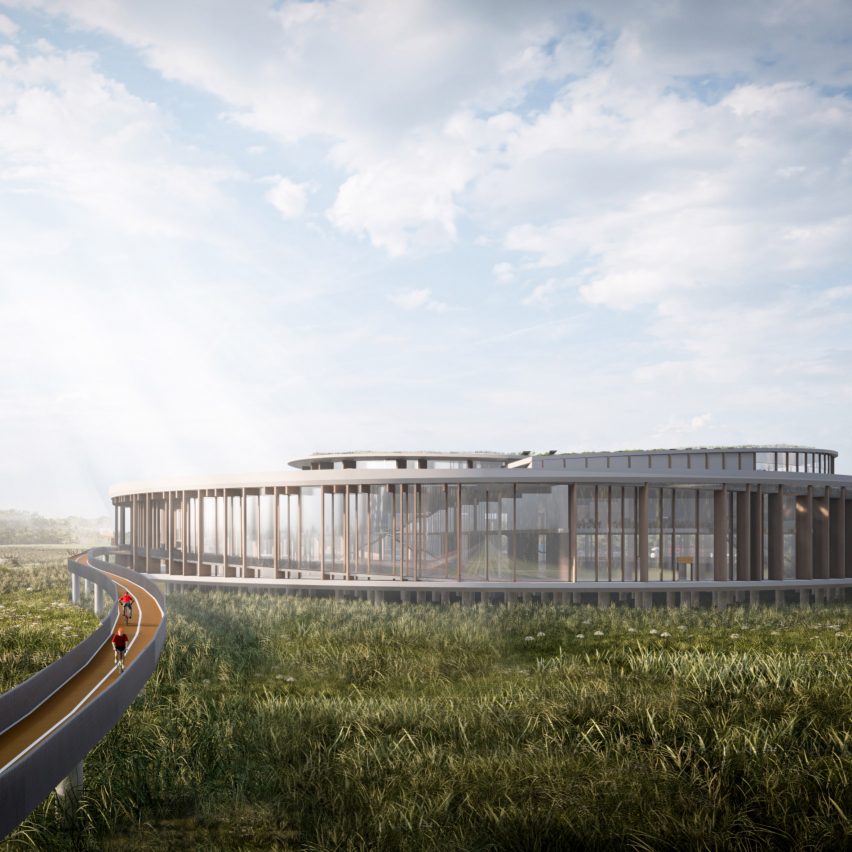
British bicycle manufacturer Brompton has unveiled plans to build a carbon-neutral headquarters and factory building designed by architects Hollaway Studio in Ashford, Kent.
Envisioned by Brompton as a "factory of the future", the facility will sit within an unused wetlands area that will be rewilded to become a nature reserve as part of the plans.
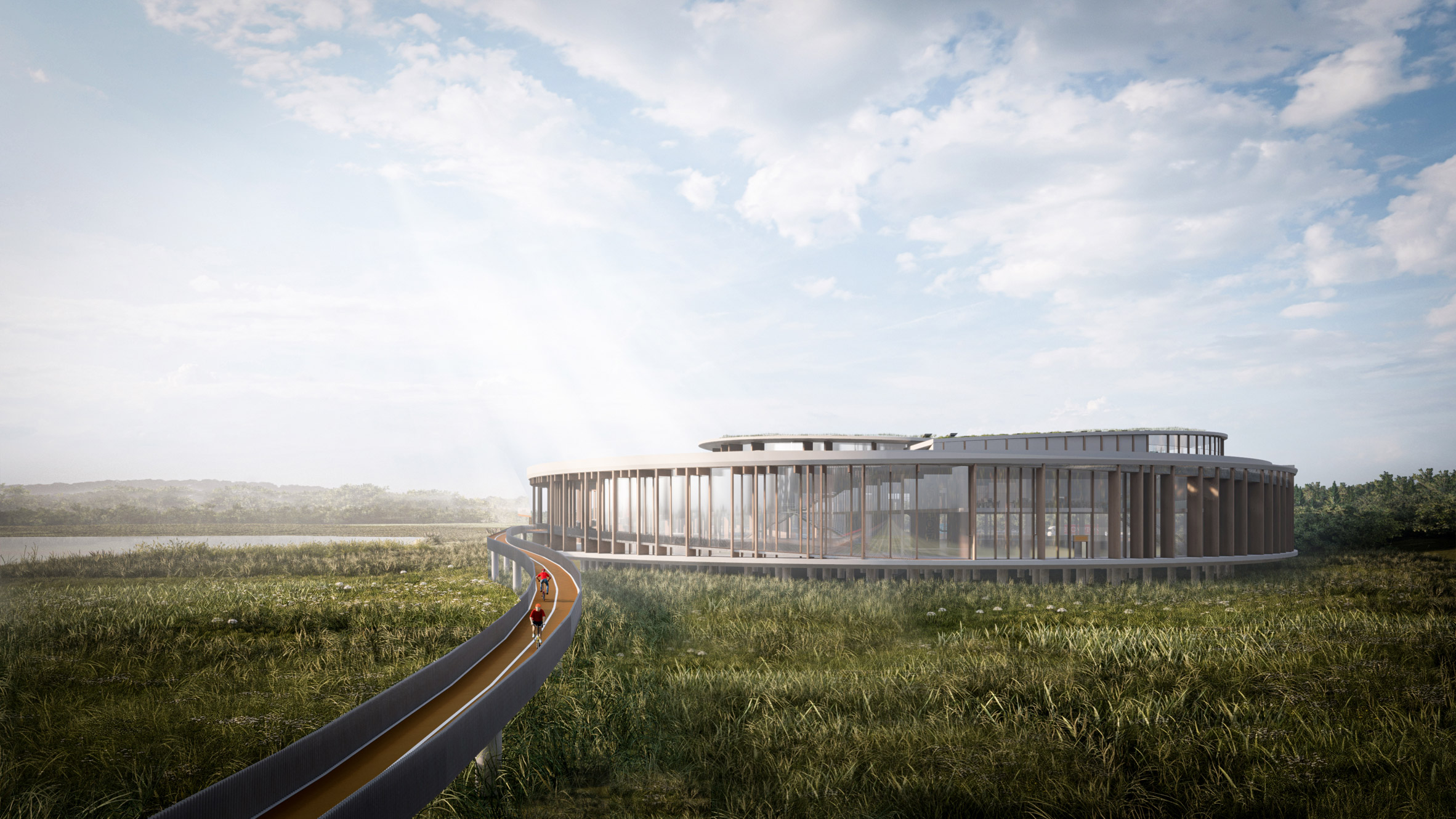 An elevated ramp will create dedicated cycle access
An elevated ramp will create dedicated cycle access
Planned for 2027, the building will boast production facilities that are open to the public and dedicated bike access via a cycle ramp elevated above the wetlands.
The ambition is for the building to be carbon-neutral but also provide state-of-the-art facilities for Brompton to reach its target of producing 200,000 bikes per year.
 The site will be rewilded to become a nature reserve
The site will be rewilded to become a nature reserve
Sustainability was the driving force behind Hollaway Studio's design.
The building is designed to optimise natural daylight and ventilation, harness wind and solar energy, and to draw heat from the ground through its foundation piles.
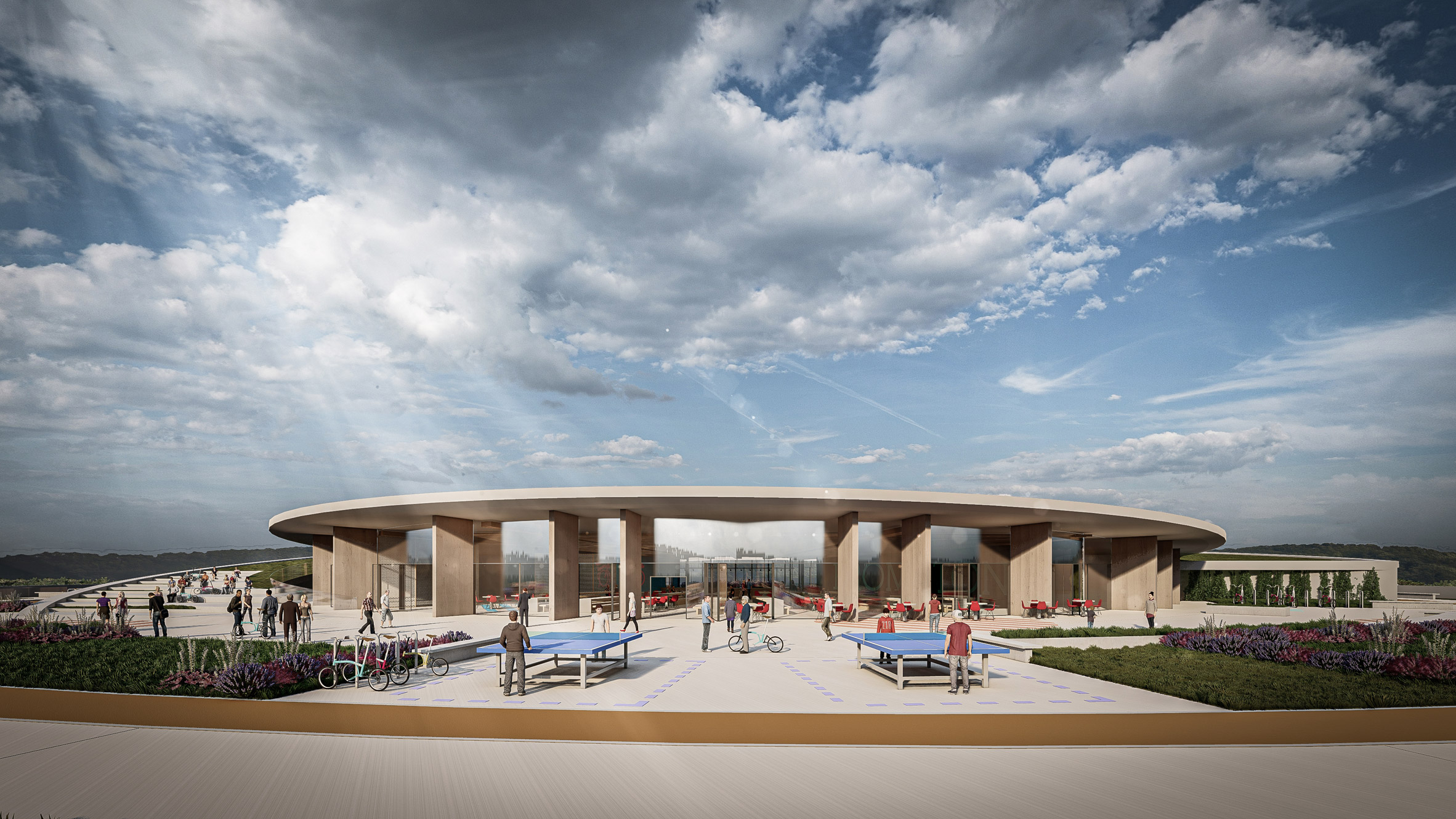 A rooftop museum and canteen will open out to a large terrace and events space
A rooftop museum and canteen will open out to a large terrace and events space
The architecture studio has also pledged to source materials responsibly, assess embodied carbon and ensure the site could be adapted for other uses in the future.
"The challenge in designing for Brompton this new sustainable factory located on a 100-acre wetland site was to rethink both the concept of a factory while creating a symbiotic relationship between industry and nature," said architect and founder Guy Holloway.
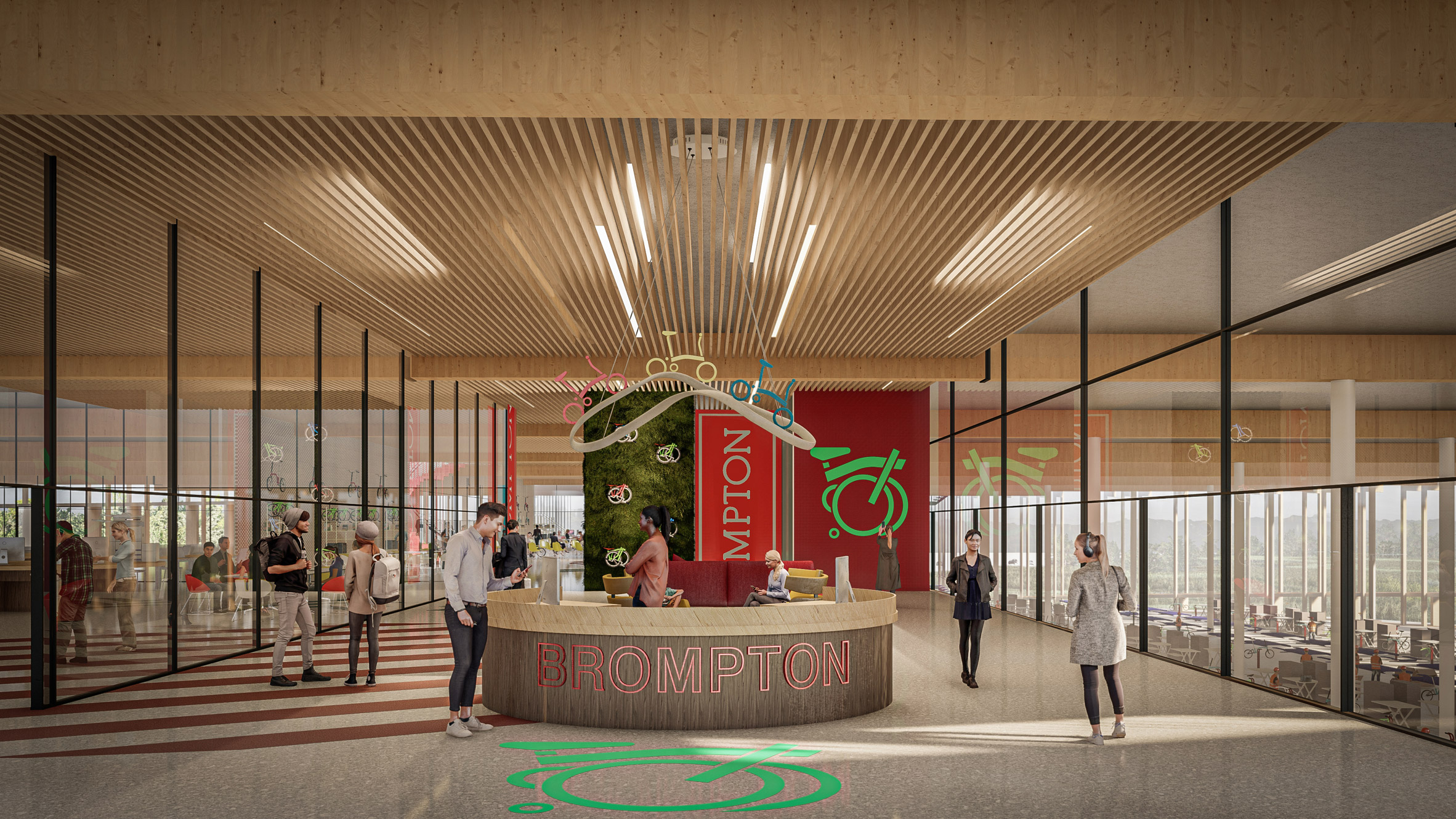 The building will serve as Brompton's headquarters and production facility
The building will serve as Brompton's headquarters and production facility
With a circular shape reminiscent of a wheel, the building will be raised up 2.2 metres above the ground to minimise its impact on the wetlands landscape and wildlife.
The building will include a Brompton Museum, events spaces and a rooftop canteen and terrace, as well as offices and production facilities for over 1,500 staff.
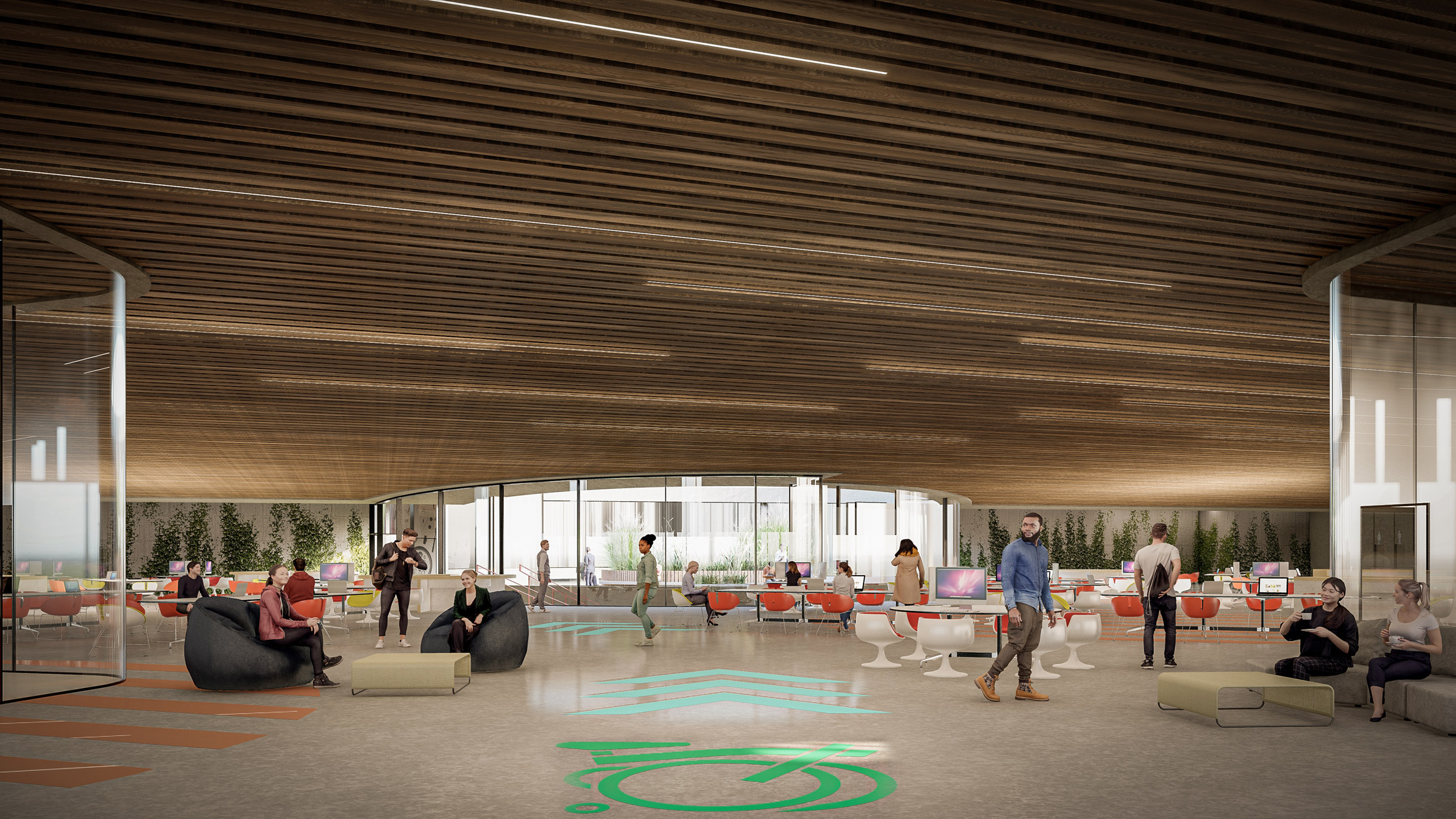 The brand hopes to have more than 1,500 staff by 2027
The brand hopes to have more than 1,500 staff by 2027
Brompton currently manufactures its pioneering folding bikes in Greenford, west London. The brand has promised to keep this facility open until at least 2030.
It is hoped the move to Ashford will allow the brand to maintain its connection to the capital, but also be within easy reach of Europe, thanks to the Eurostar railway link.
[ 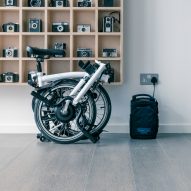
"As we face climate change, combined with poor mental and physical health in our cities, where most of the world population live, we need to adapt," said Will Butler-Adams, CEO of Brompton.
"There has been a global realisation post-pandemic that we need to change how we live in our cities, to design them around the people that live in them, not the automobile."
 The ambition is to manufacture 200,000 bikes per year
The ambition is to manufacture 200,000 bikes per year
"Brompton has a large part to play in supporting that transition, but we need to have more space to innovate and create the products of the future," he continued.
"We have a long journey ahead with the planning and development of the new site, but we're thankful for the support of Ashford Borough Council, Hollaway Studio and Quinn Estates towards achieving our combined ambition to build this revolutionary and sustainable bicycle factory of the future."
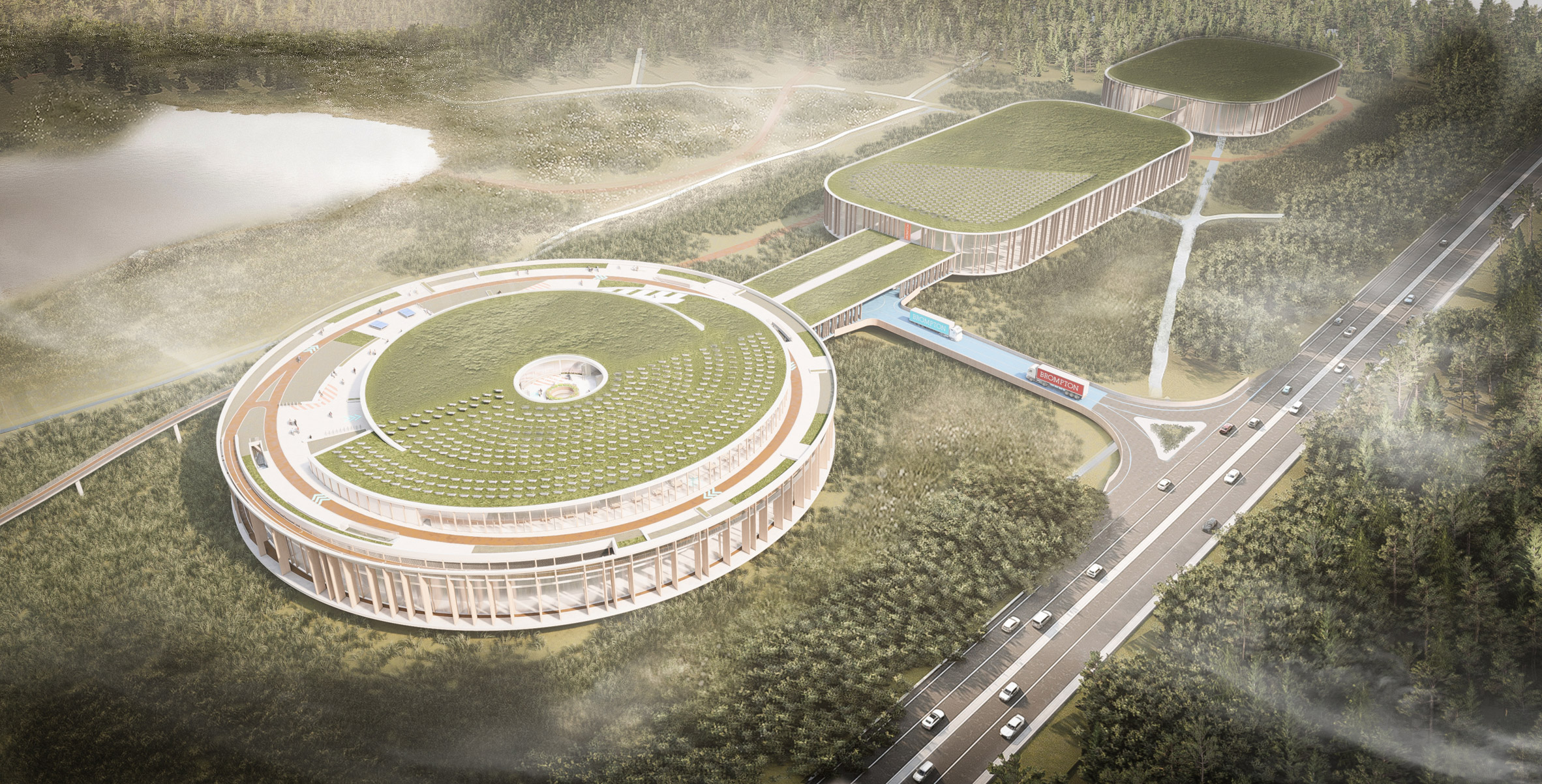 The building will be located in Ashford, Kent
The building will be located in Ashford, Kent
Hollaway Studio – formerly known as Guy Holloway Architects – has offices in London and Kent, and has worked on numerous projects in England's southeast.
The studio designed the Rocksalt restaurant in Folkestone and a row of seafront homes in Margate, and is soon to unveil the world's first multi-storey skatepark in Folkestone.
The post Hollaway Studio designs "bicycle factory of the future" for Brompton appeared first on Dezeen.
#all #architecture #industrial #news #uk #england #factories #cycling #hollawaystudio #kent
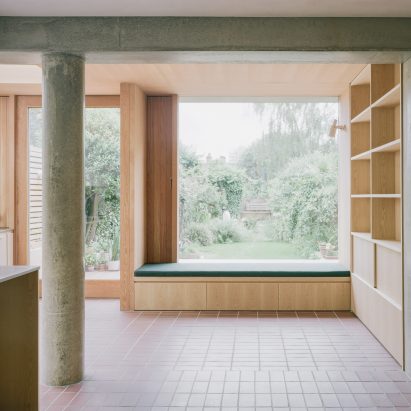
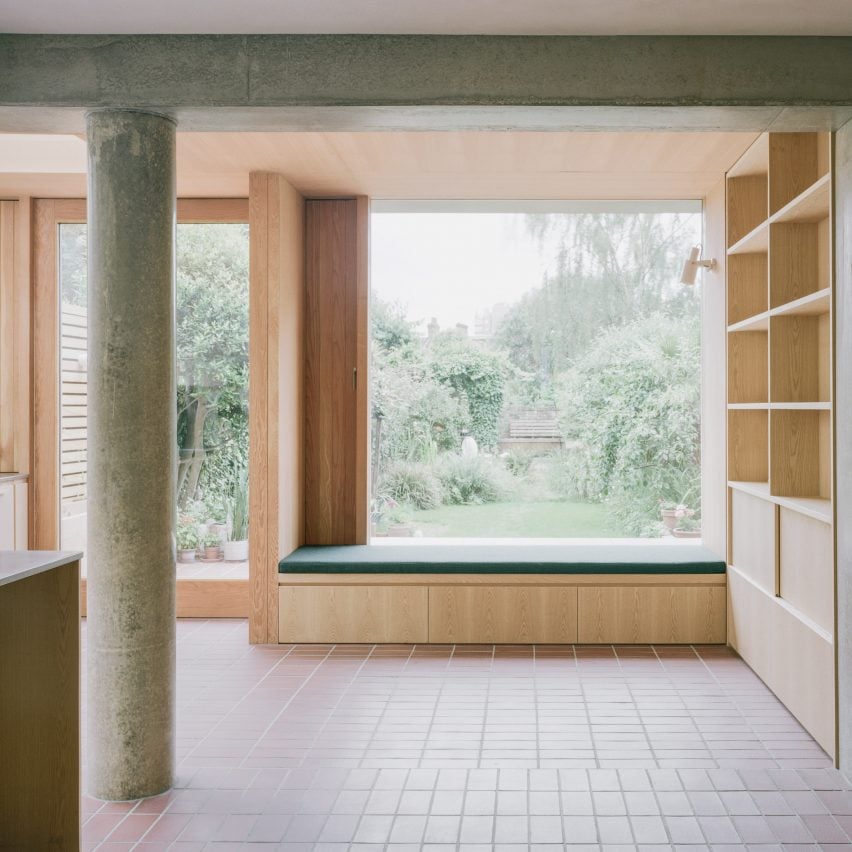
Raw concrete, burnt clay and natural wood come together in this extension to an end-of-terrace house in south London, designed by architecture studio TYPE.
Called Herne Hill House, the project involved replacing a poorly built conservatory with a robust 45-square-metre extension, giving the three-storey house a more substantial kitchen and dining room.
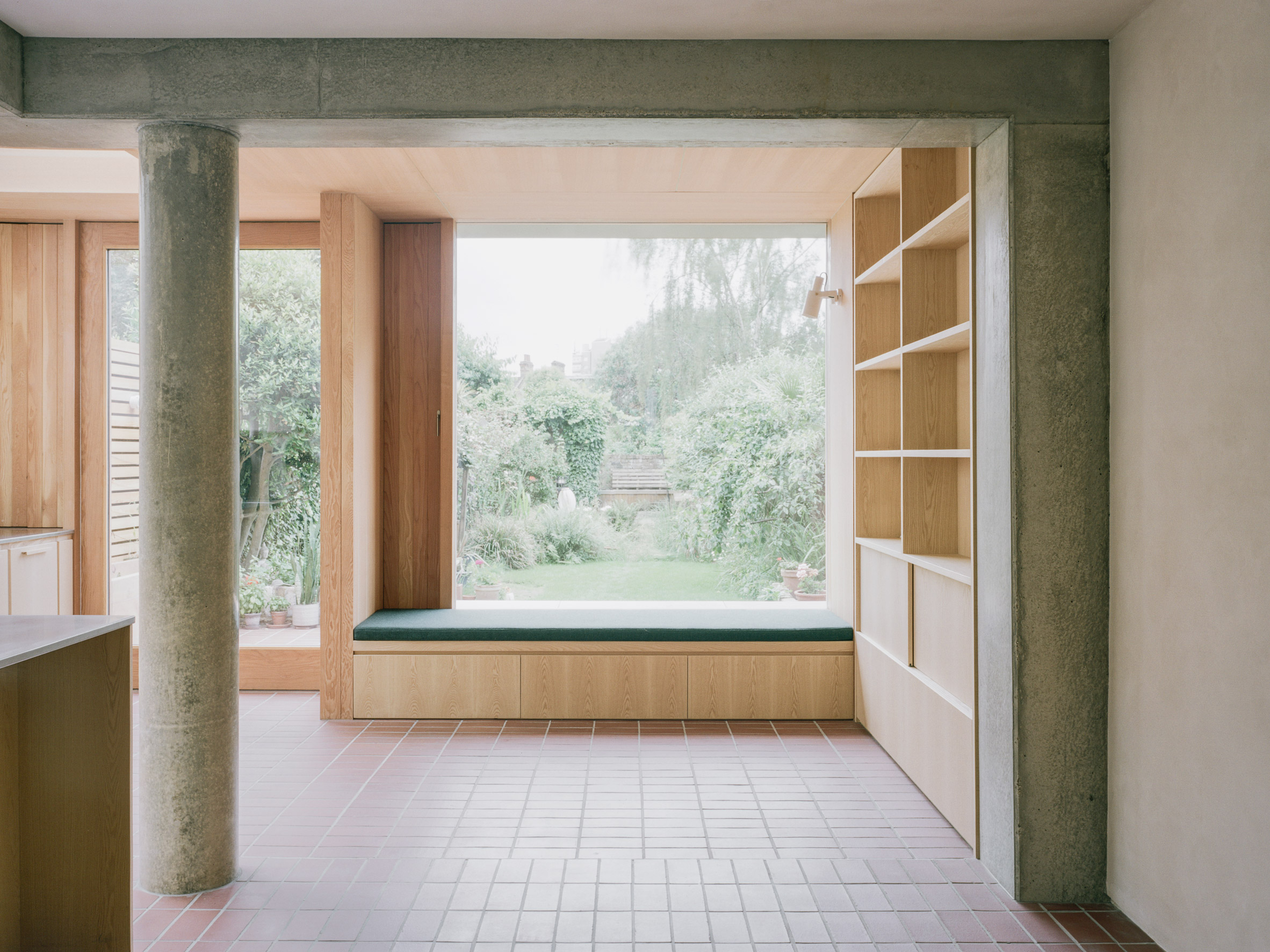 The design combines quarry tiles, exposed concrete, natural wood and lime plaster
The design combines quarry tiles, exposed concrete, natural wood and lime plaster
TYPE's design centres around simple, quality materials that can be left exposed, so they don't need external finishes.
Details include an exposed concrete structure, lime plaster walls, a floor of quarry tiles and furniture elements made from ash and Douglas fir.
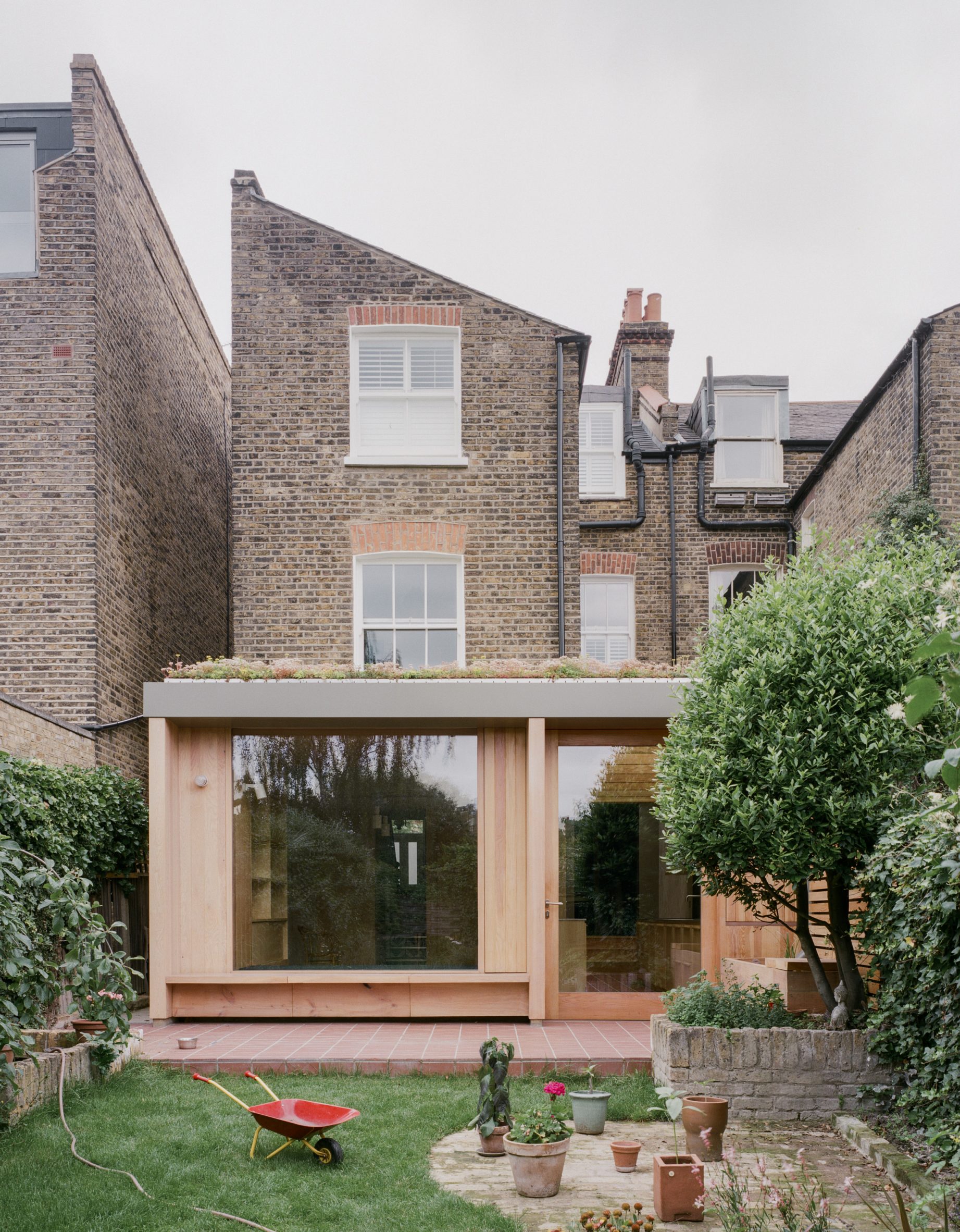 The Herne Hill House scheme extends a Victorian terrace
The Herne Hill House scheme extends a Victorian terrace
The owners – a family with young children – chose to work with TYPE after seeing photos of a project where the studio had taken a similar approach. Their aim was to create a space with natural warmth and durability.
"Using natural materials such as timber brings a warmth and lightness to the space, something which the clients had particularly liked in our previous work," said Ogi Ristic, one of the studio's four directors.
"The material palette gives the project a soft and subtle earthy tone that feels warm and inviting," he told Dezeen.
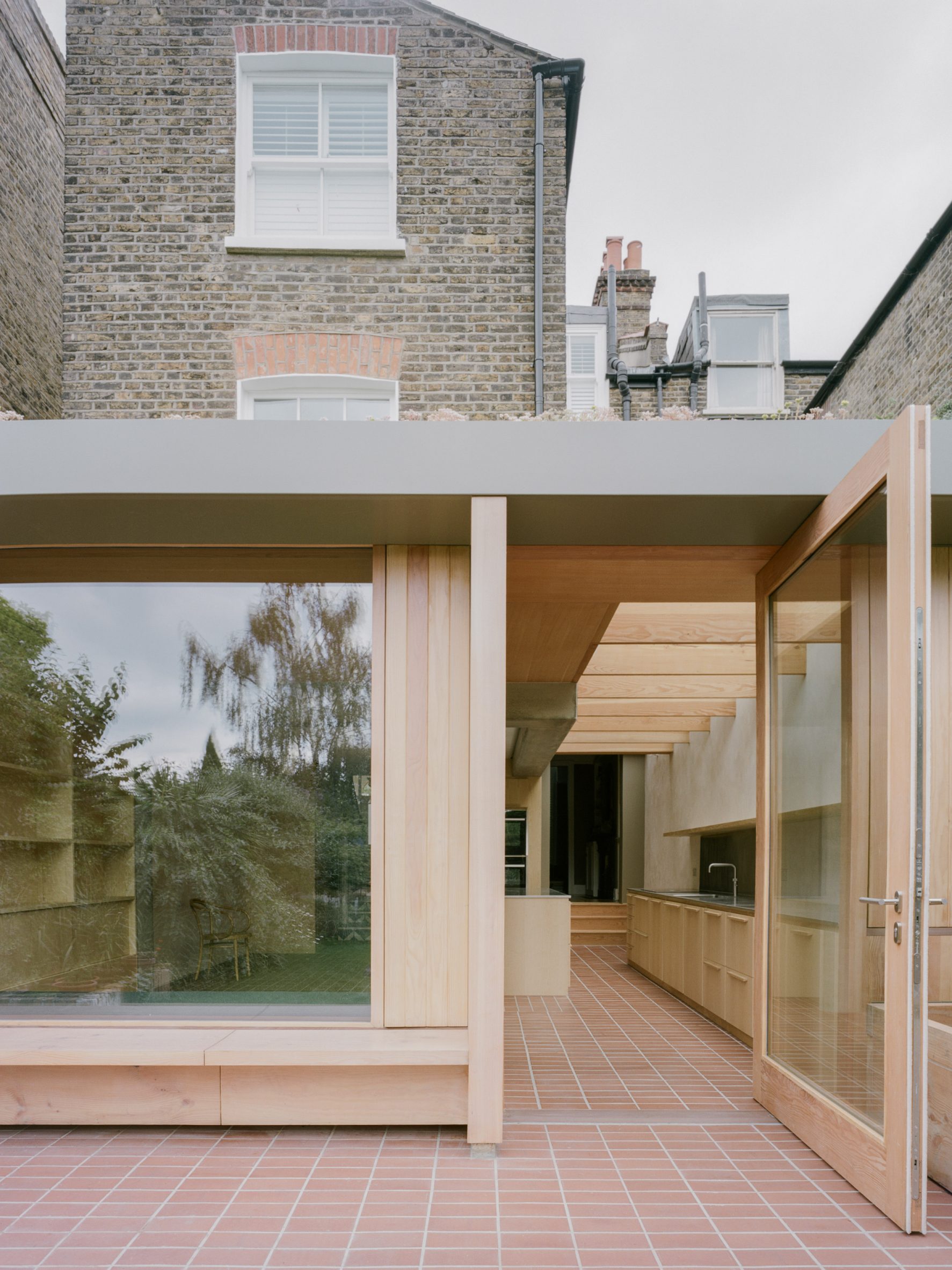 Bench seating is built into the Douglas fir facade
Bench seating is built into the Douglas fir facade
Combing a rear and side extension, the structure was treated as a series of layered components, which gives a natural hierarchy to the way that materials join one another.
The first layer is the concrete frame supporting the existing structure, which is celebrated through the addition of a cylindrical column – the only curved element in the room.
[ 
](https://www.dezeen.com/2022/01/17/wide-staircase-farleigh-road-renovation-paolo-cossu-architects/)
The second layer is the ash-lined box that forms the walls of the extension, creating a clear contrast between the new and old parts of the Victorian building.
The third layer is a three-dimensional facade built from Douglas fir, featuring a large picture window with built-in bench seats on either side, both inside and out.
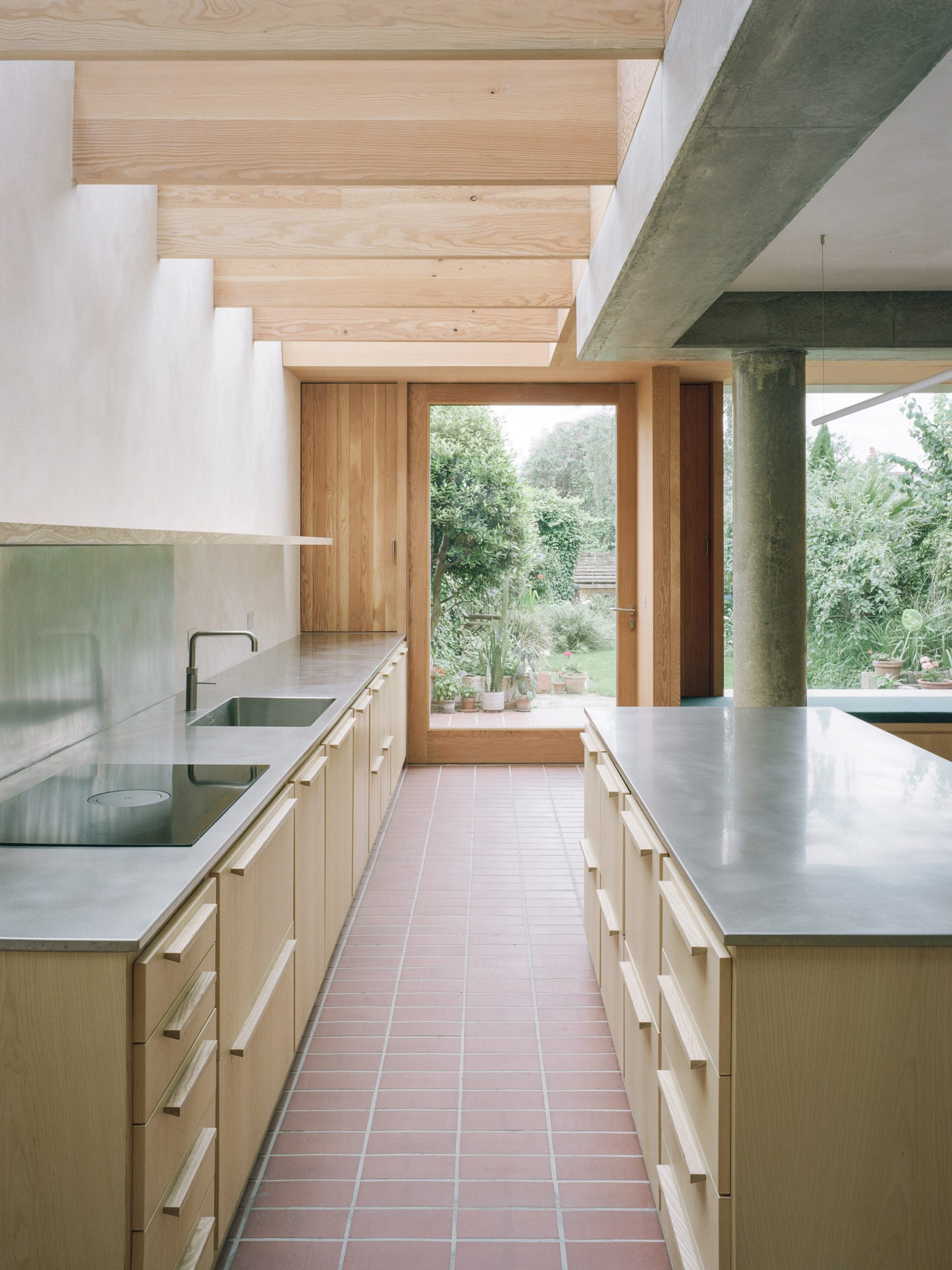 Douglas fir joists sit underneath a long skylight
Douglas fir joists sit underneath a long skylight
Herne Hill House's new layout naturally divides the space into different zones.
A kitchen and breakfast bar made from ash wood occupies the side extension, lit from above by a large skylight. Douglas fir joists slot in underneath the glass, offering a sense of depth.
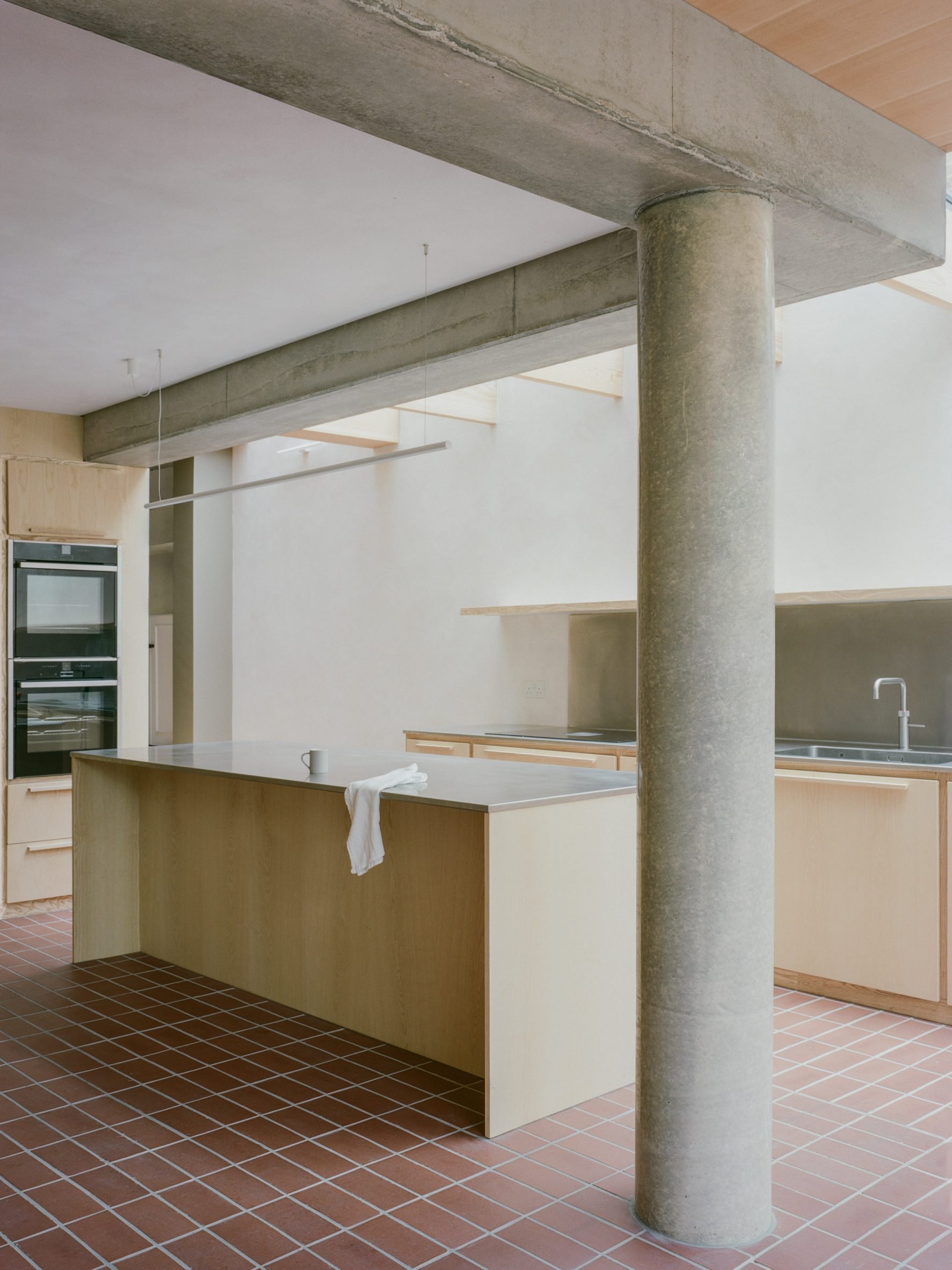 The kitchen units and breakfast bar are crafted from ash
The kitchen units and breakfast bar are crafted from ash
The space of the original kitchen becomes a dining area, while the picture window creates a natural lounge space. The bench seat is upholstered, and an adjoining bookshelf integrates a fold-out seat that can be used by the family's children.
The circulation of the space is also improved thanks to a new internal doorway connecting the kitchen with the living rooms at the front of the house, and a large pivoting door that leads out to the garden.
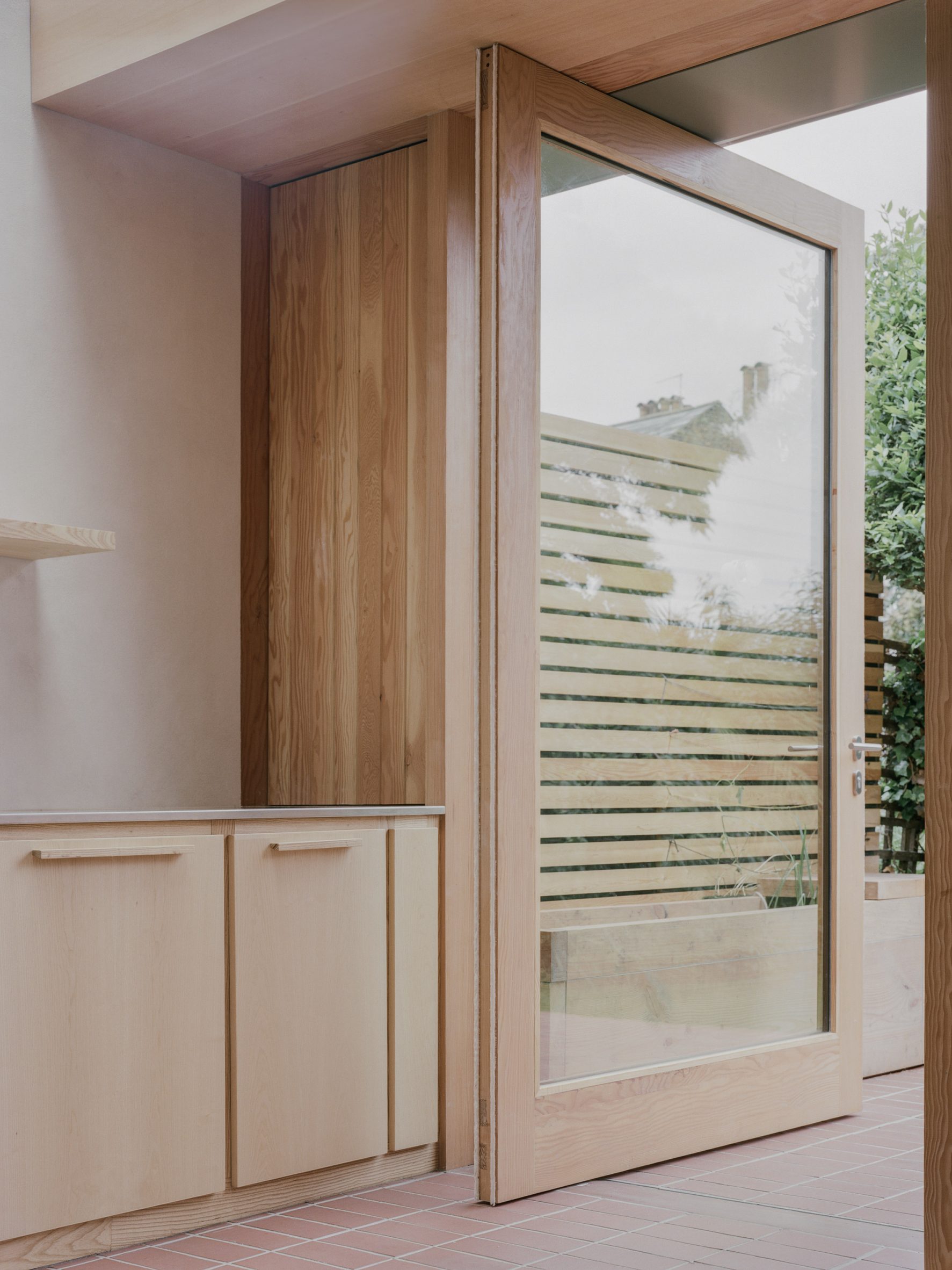 A pivoting door provides access to the garden
A pivoting door provides access to the garden
"The original kitchen was poorly laid out, which meant there was a disconnect with the dining room, living area and garden," said Ristic.
"The biggest priority was to reestablish these connections through a few simple moves."
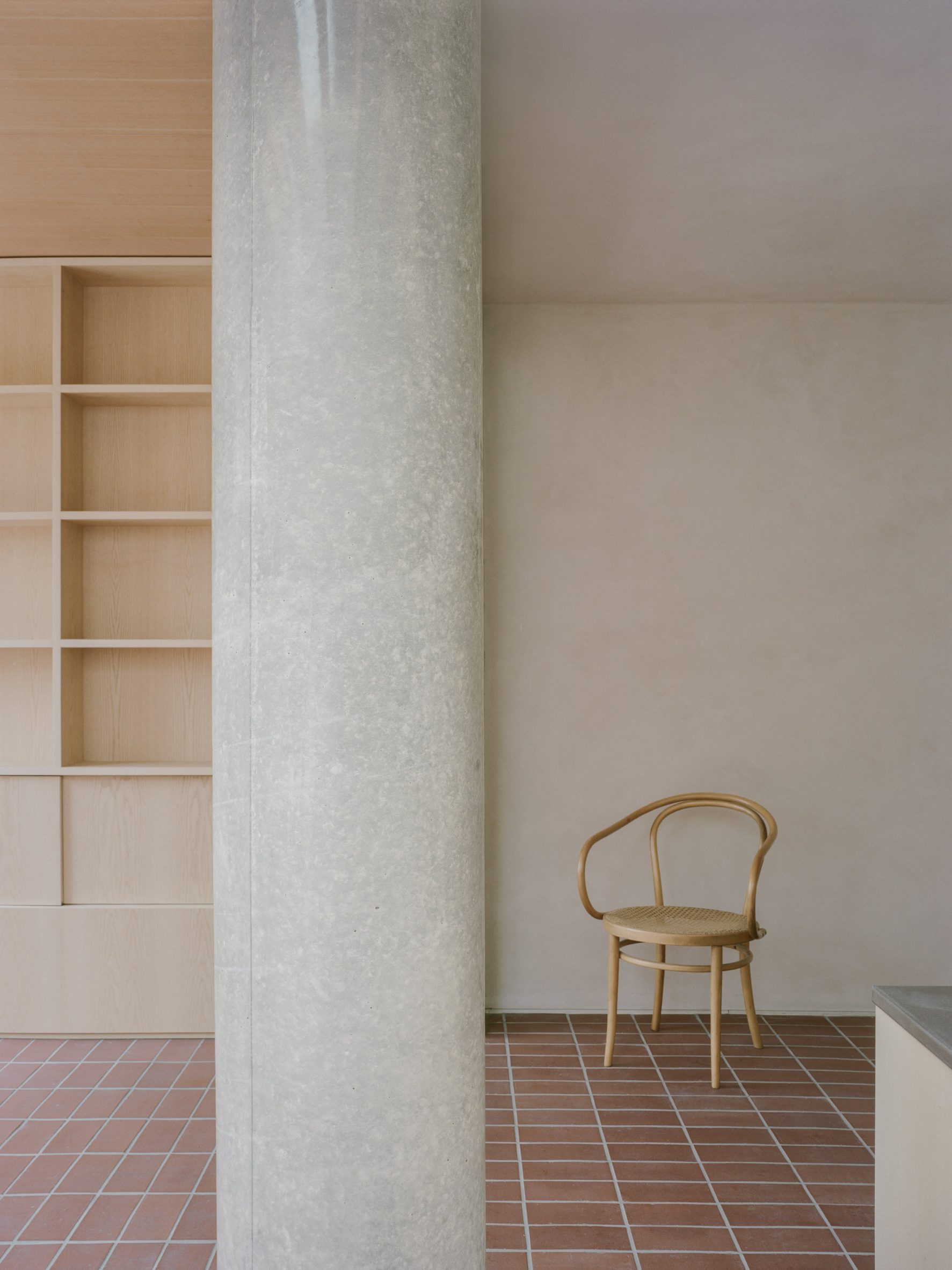 A concrete column is the only curved element in the space
A concrete column is the only curved element in the space
East London-based TYPE is led by Ristic along with partners Sam Nelson, Tom Powell and Matt Cooper.
The studio primarily works on residential renovations, conversions and extensions, with past projects including Redhill Barn, a conversion of a ruined 200-year-old stone shed in Devon.
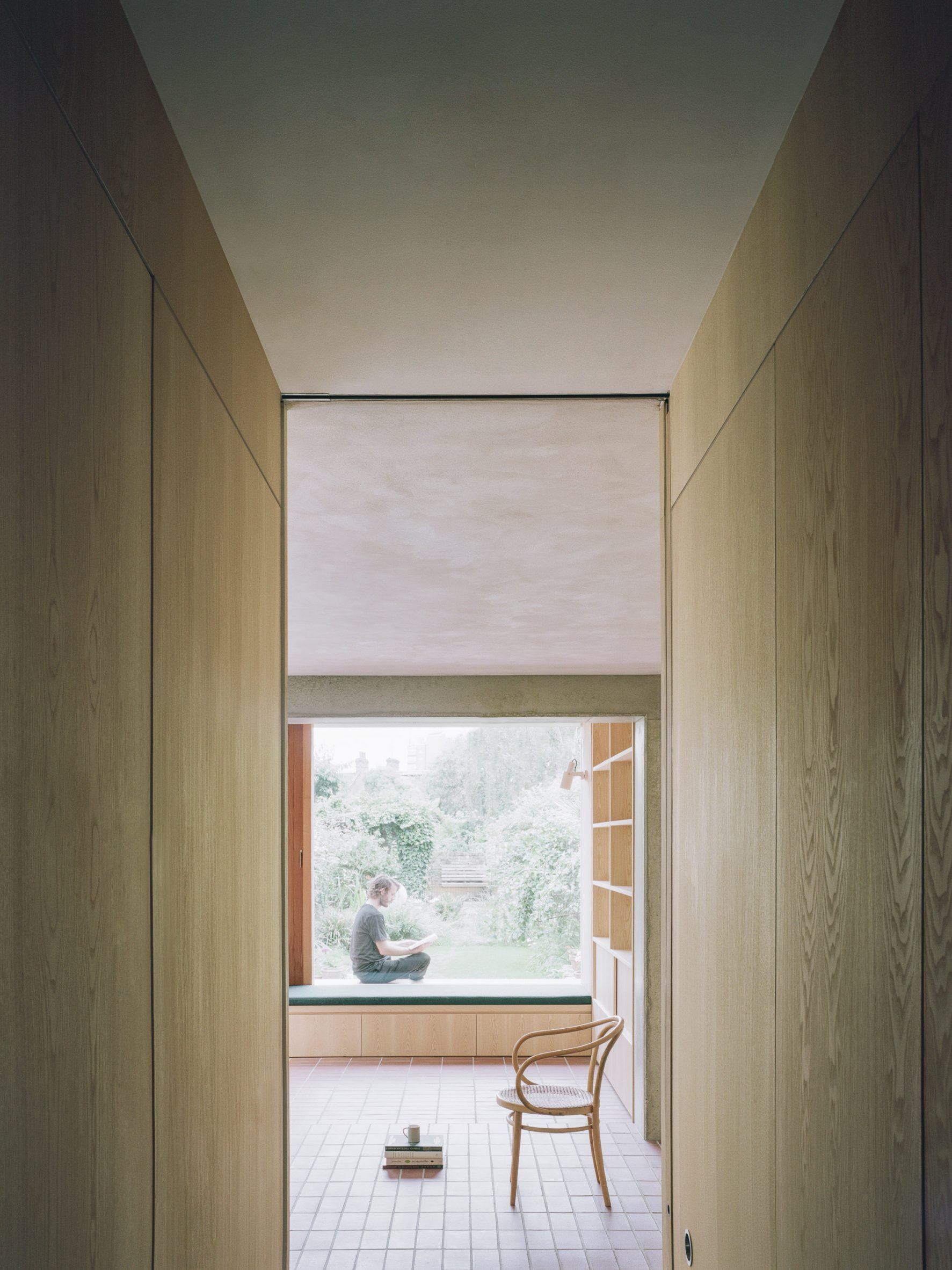 An upholstered window seat lines the picture window
An upholstered window seat lines the picture window
The studio aims to reorganise homes when possible, as Ristic advises that extensions aren't always the answer – often homes can be improved by simply improving what is there already.
"Many homes may be sufficiently large but are inefficiently laid out, making it appear that extending is the only way forward," he said.
"Our approach is always to see how far we can reorganise the home so it works better, and we can build less. This allows more to be invested in retrofitting the existing building with additional insulation, upgraded glazing and heating systems."
Photography is byLorenzo Zandri.
Project credits:
Architect: TYPE
Project architect: Ogi Ristic
Contractor: MONO Urban Space Solutions
Structural engineer: Blue Engineering
Joinery: DJG Furniture
The post TYPE combines elemental materials in Herne Hill House extension appeared first on Dezeen.
#all #architecture #residential #london #uk #england #residentialextensions #londonhouseextensions
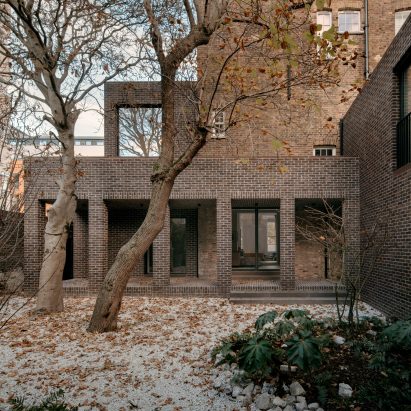
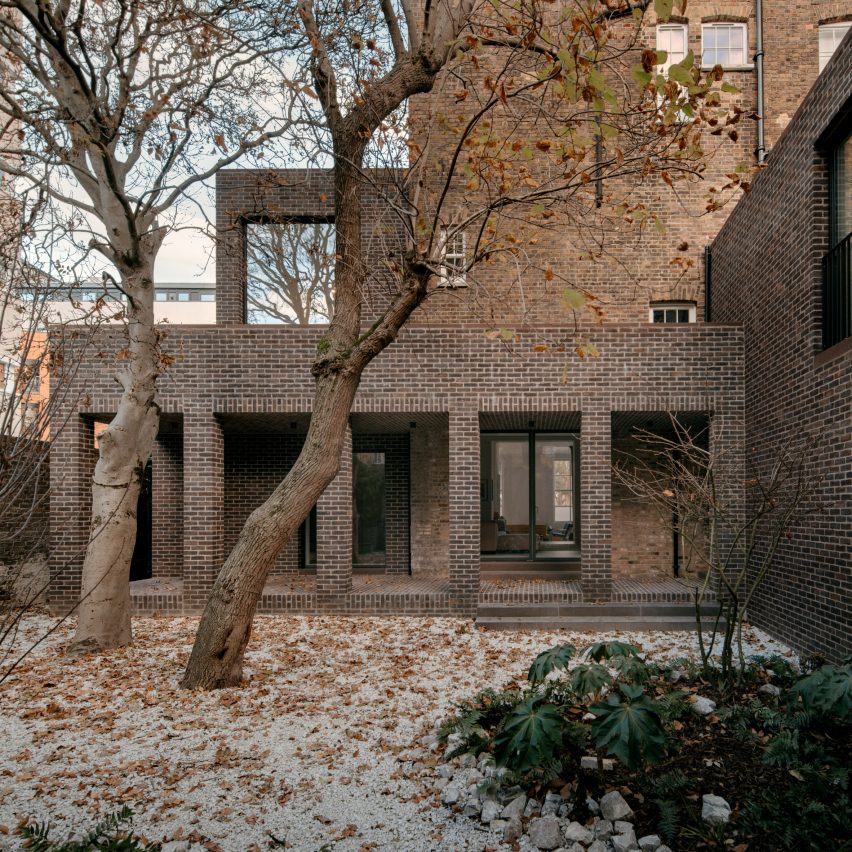
London studio Erbar Mattes has transformed a pair of apartments in a former pub in Hoxton into a duplex flat by adding a "monastic" grey-brown brick extension.
The old pub, called the Blockmakers Arms, is located in the Regent's Canal conservation area and dates back to the mid-19th century. It was converted into three flats in the 1970s.
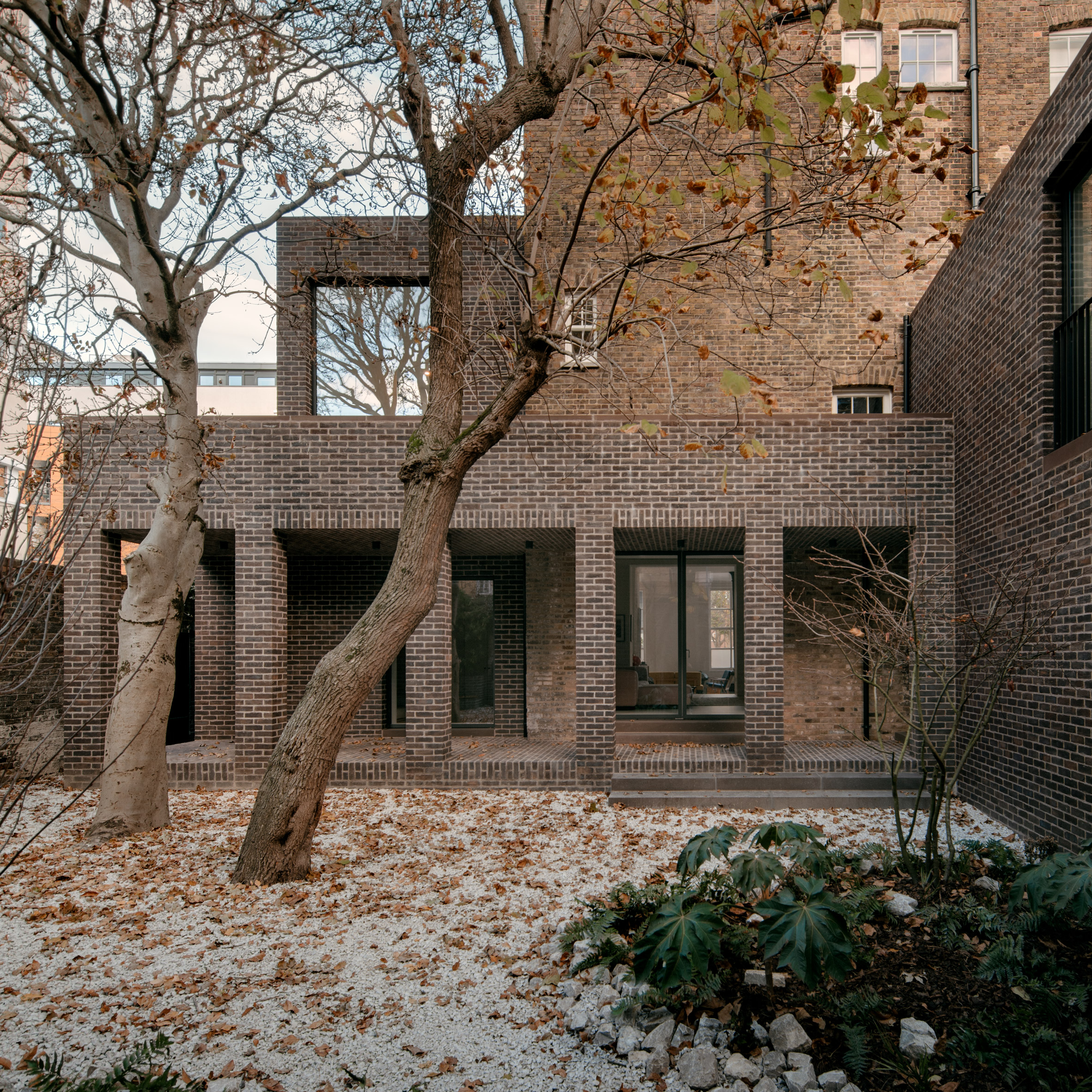 Erbar Mattes has extended a pair of apartments in a former London pub
Erbar Mattes has extended a pair of apartments in a former London pub
The owners of the ground floor flat sought extra space for their growing family and acquired the vacant first-floor dwelling with a view to creating a five-bedroom duplex.
Erbar Mattes' approach involved stripping away previous extensions that detracted from the pub's original structure and replacing an external staircase with an elevated walkway and brick loggia informed by monastery cloisters.
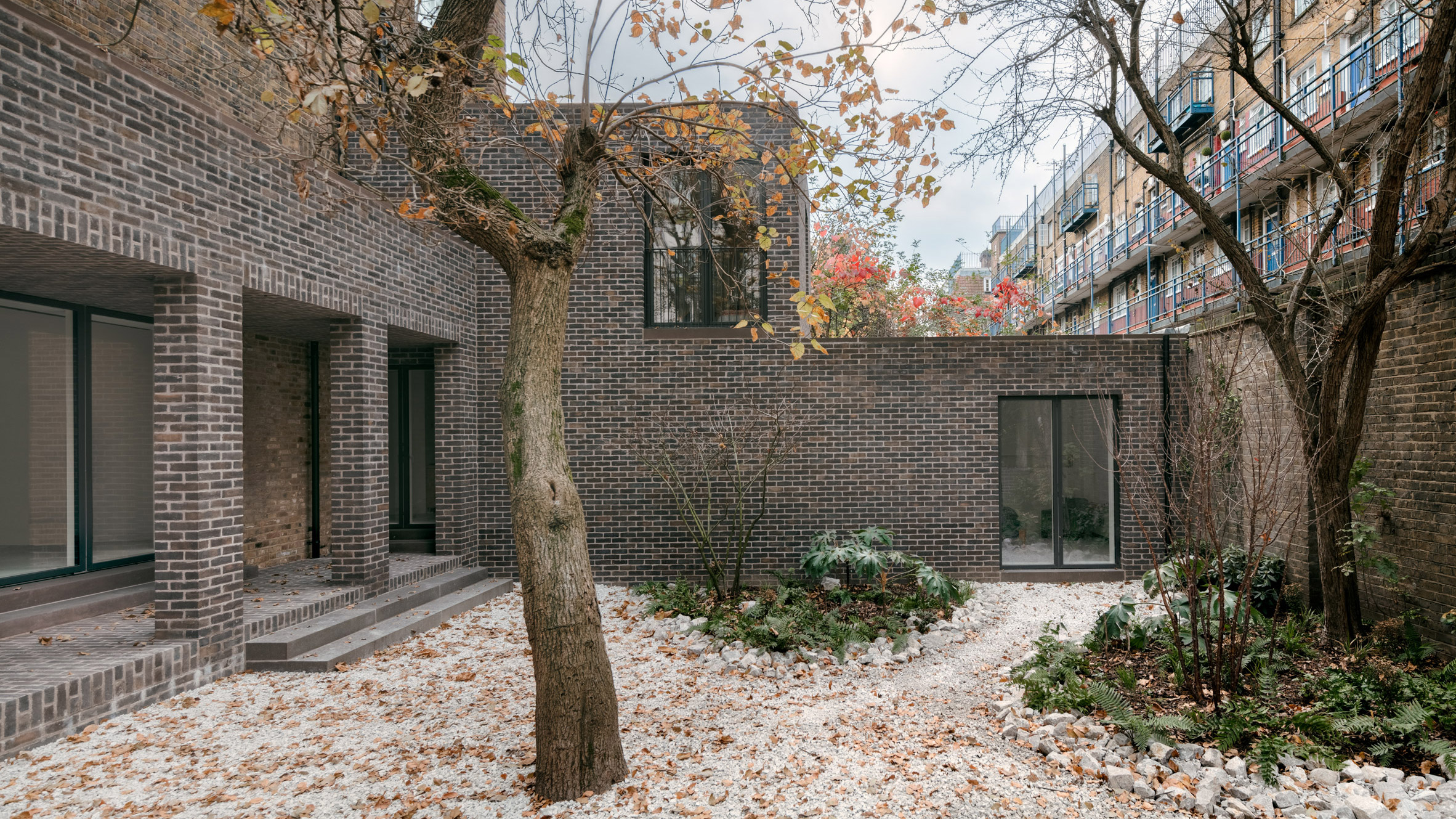 The extension incorporates a loggia
The extension incorporates a loggia
"One of the main challenges consisted of creating a larger dwelling while retaining separate access to the independent apartment on the top floor," explained the studio.
"To overcome this, the external circulation is relocated to the side elevation and a new raised walkway added to the rear."
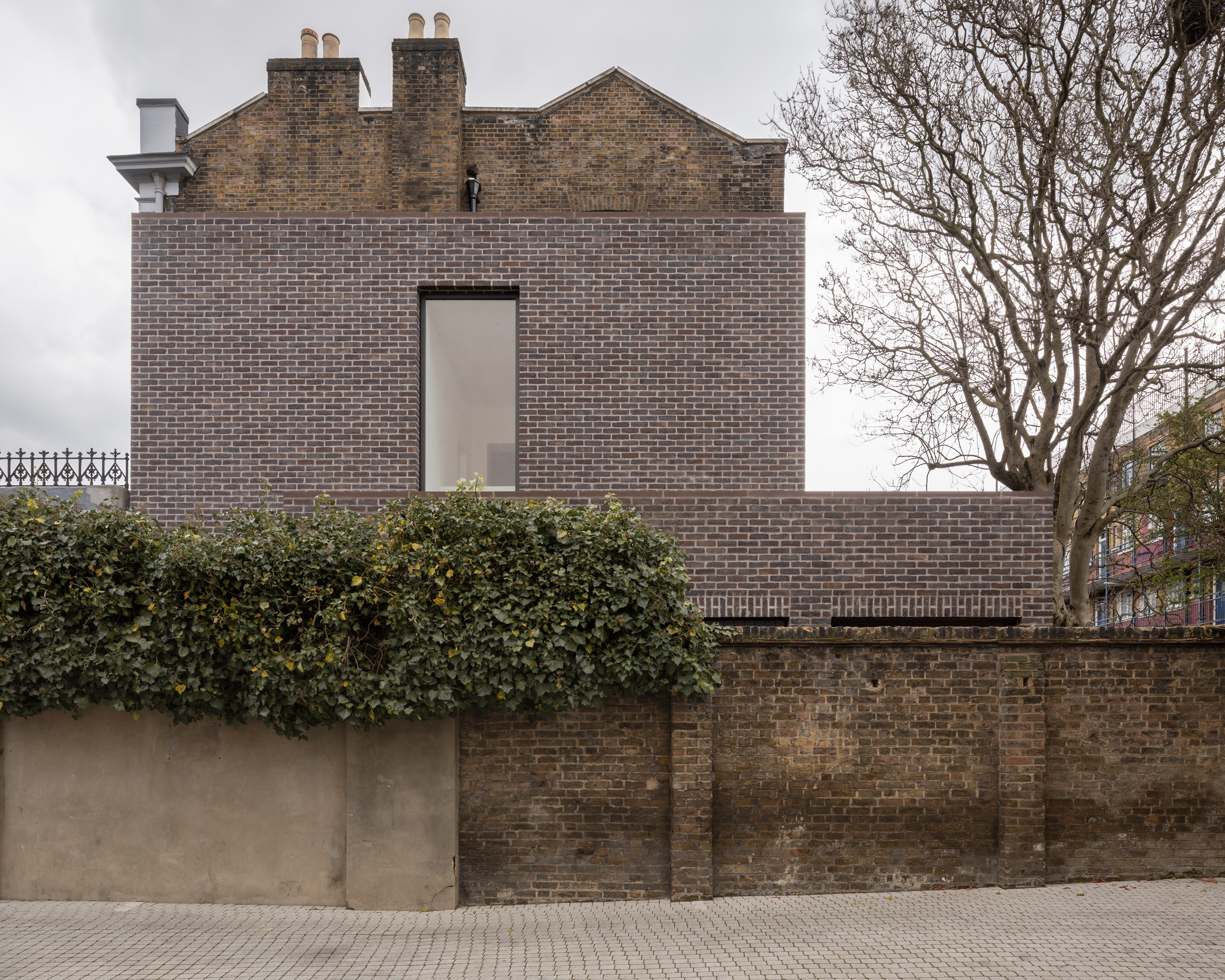 The extension has transformed two flats into a duplex
The extension has transformed two flats into a duplex
"The loggia, with its solid brick piers, draws inspiration from monastic architecture, where cloisters form a sheltered transition space between inside and outside," Erbar Mattes continued.
Replacing redundant vehicular access, this new arrangement strengthens the building's relationship with a walled courtyard at the rear, which is now overlooked by the loggia and a new brick volume.
 External circulation has been added to the side of the building
External circulation has been added to the side of the building
"The new rectilinear building volumes wrap around the side and rear elevations without detracting from the ornate front facade," said the studio.
Internally, the existing structure was reconfigured to better suit its expanded size, with plasterboard ceilings and finishes stripped back to restore the original ceiling heights and wooden panelling.
[ 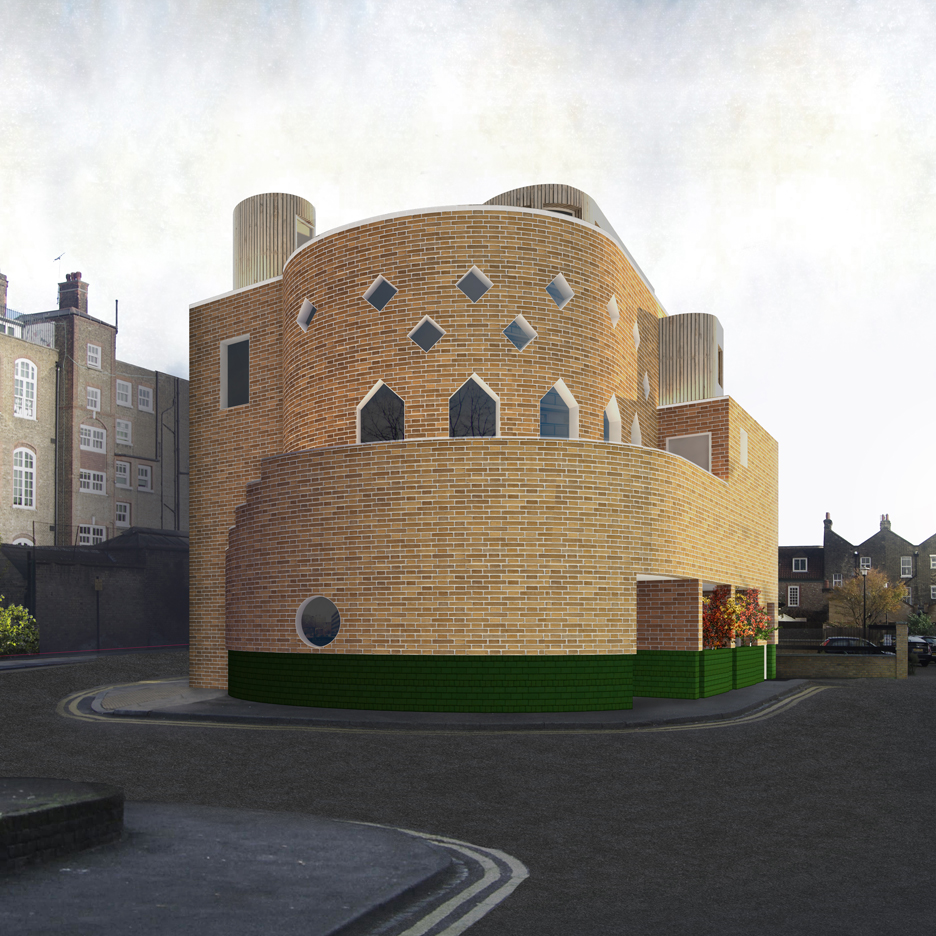
A former function room on the first floor has been repurposed to create a large main bedroom, which has access to a roof terrace on the first floor above the original entrance to the pub.
The new volumes contain a staircase which overlooks the nearby trees through a large window, as well as two further bedrooms and a bathroom.
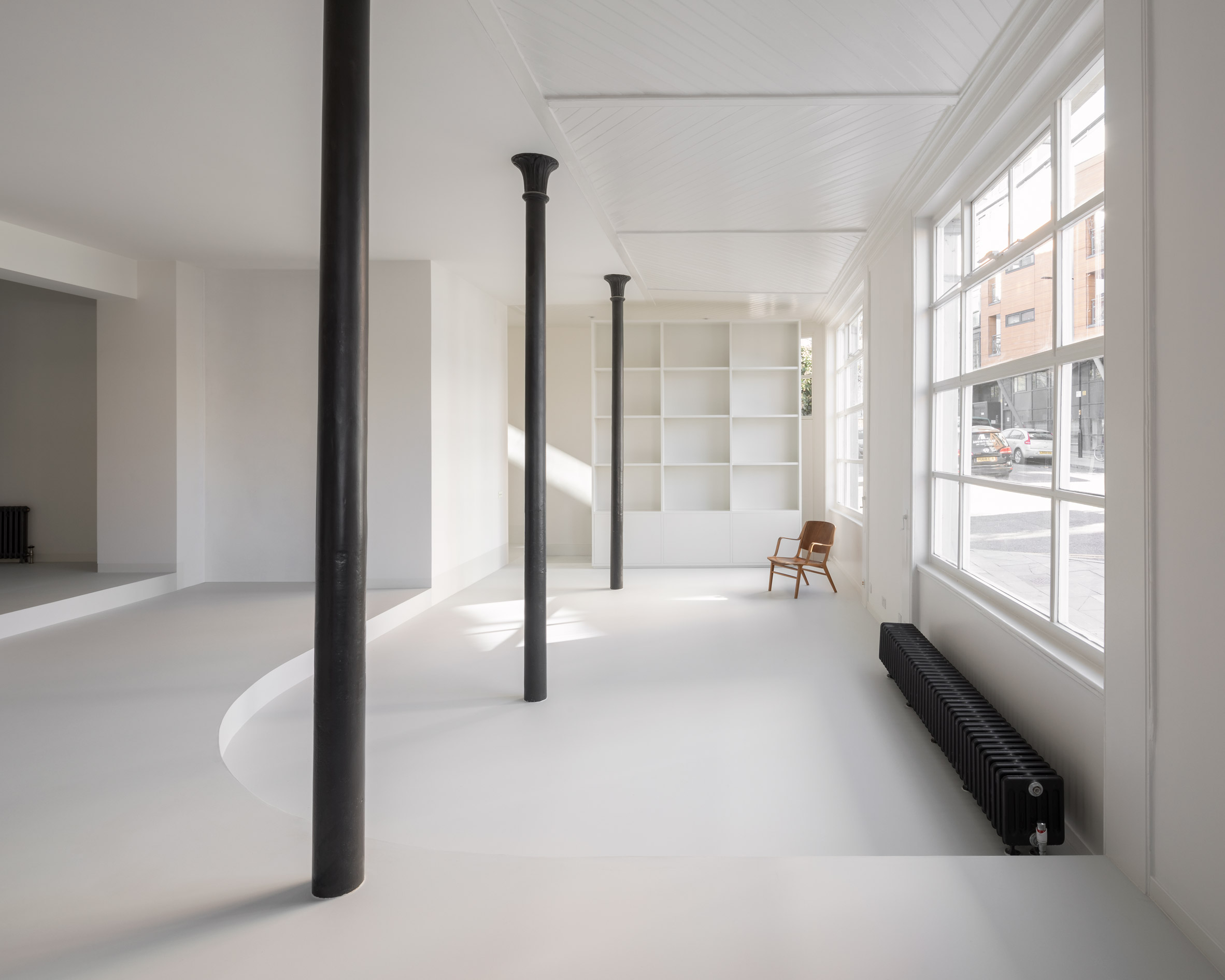 Original details of the pub have been restored internally. Photo is by Ståle Eriksen
Original details of the pub have been restored internally. Photo is by Ståle Eriksen
During the project, Erbar Mattes was also commissioned to convert the interiors of the independent second-floor apartment, which involved a similar approach of stripping back recent additions to reveal the original interior features.
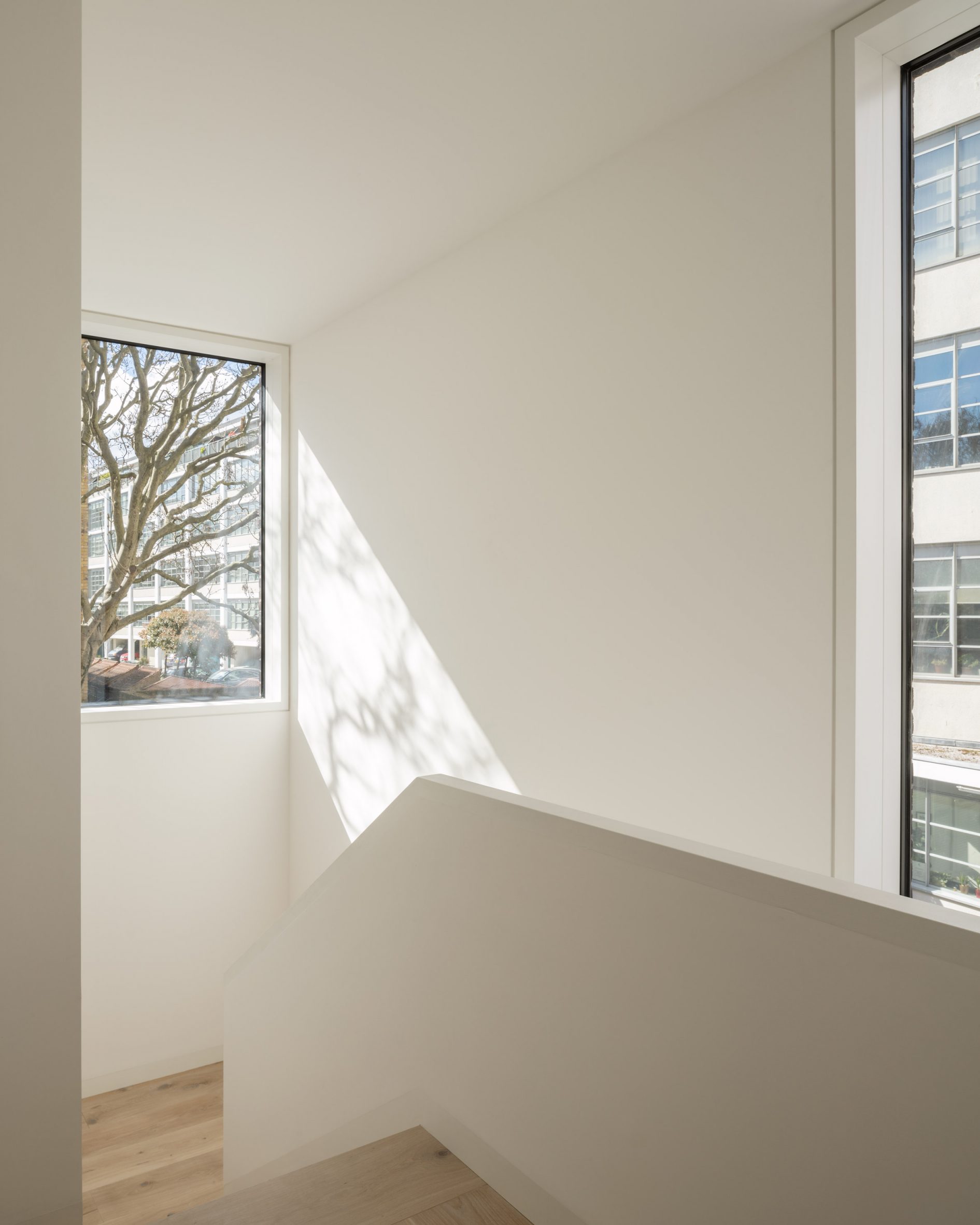 The internal staircase looks out over nearby trees. Photo is by Ståle Eriksen
The internal staircase looks out over nearby trees. Photo is by Ståle Eriksen
Erbar Mattes was founded in 2015 by Holger Mattes and Demian Erbar, who previously worked for David Chipperfield Architects.
The studio also recently extended an Edwardian house in London's Crouch End, where a bright living area built in pale brick overlooks a garden.
The photography is by Simon Menges unless stated. Ståle Eriksen
The post Erbar Mattes strips back and extends flats in former London pub appeared first on Dezeen.
#all #architecture #residential #instagram #london #apartments #uk #england #bricks #extensions #residentialextensions #londonhouses #londonhouseextensions
In den Niederlanden sind seit diesem Freitag fast alle Corona-Beschränkungen außer Kraft. So wurde der Corona-Gesundheitspass abgeschafft. Auch Bars und Nachtclubs können wieder unbeschränkt öffnen.#Niederlande #Coronavirus #COVID-19 #Lockerungen #Island #England #Deutschland #RKI #KarlLauterbach
Fast keine Corona-Restriktionen in den Niederlanden mehr | DW | 25.02.2022
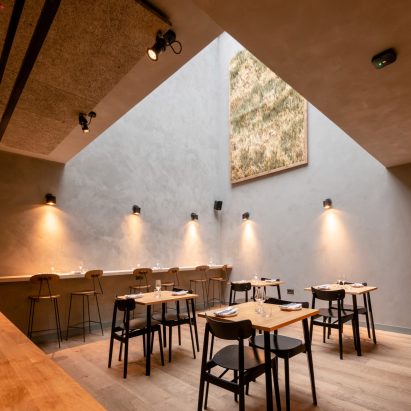
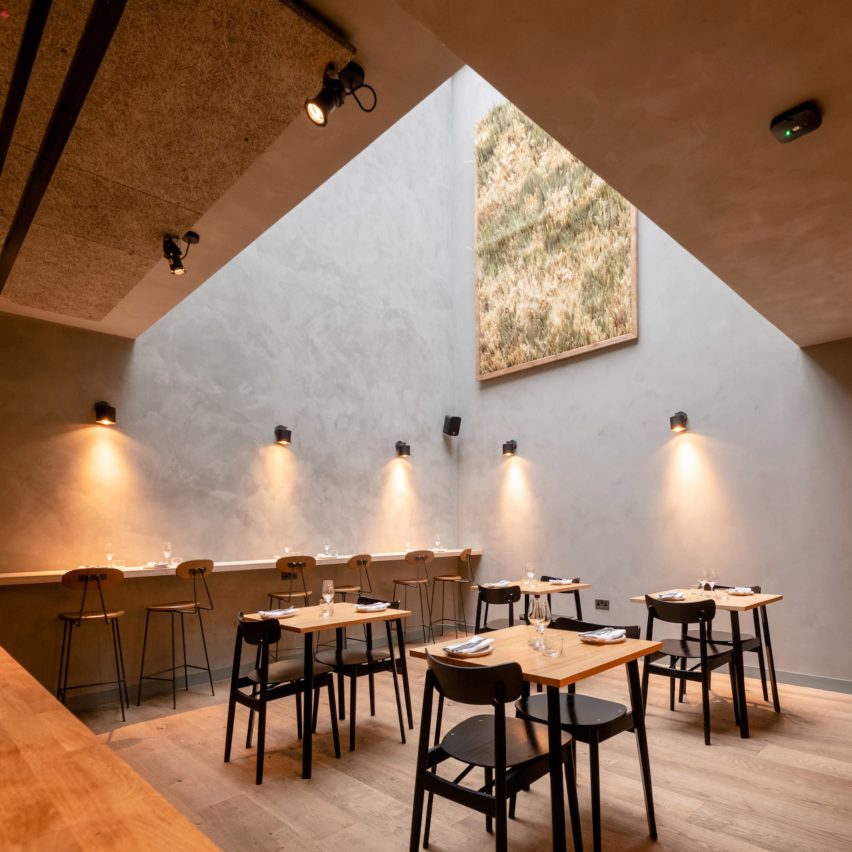
London restaurant Carousel has moved to a new venue but taken many of its old fixtures and fittings with it, thanks to an environmentally conscious approach from Rise Design Studio.
Founded seven years ago by brothers Ollie and Ed Templeton, the restaurant has moved into three converted Georgian townhouses in Fitzrovia, with dining rooms on two floors.
Rise Design Studio designed the original Carousel restaurant in Marylebone, so the architects decided to be as resourceful as possible when repeating the formula in a new location.
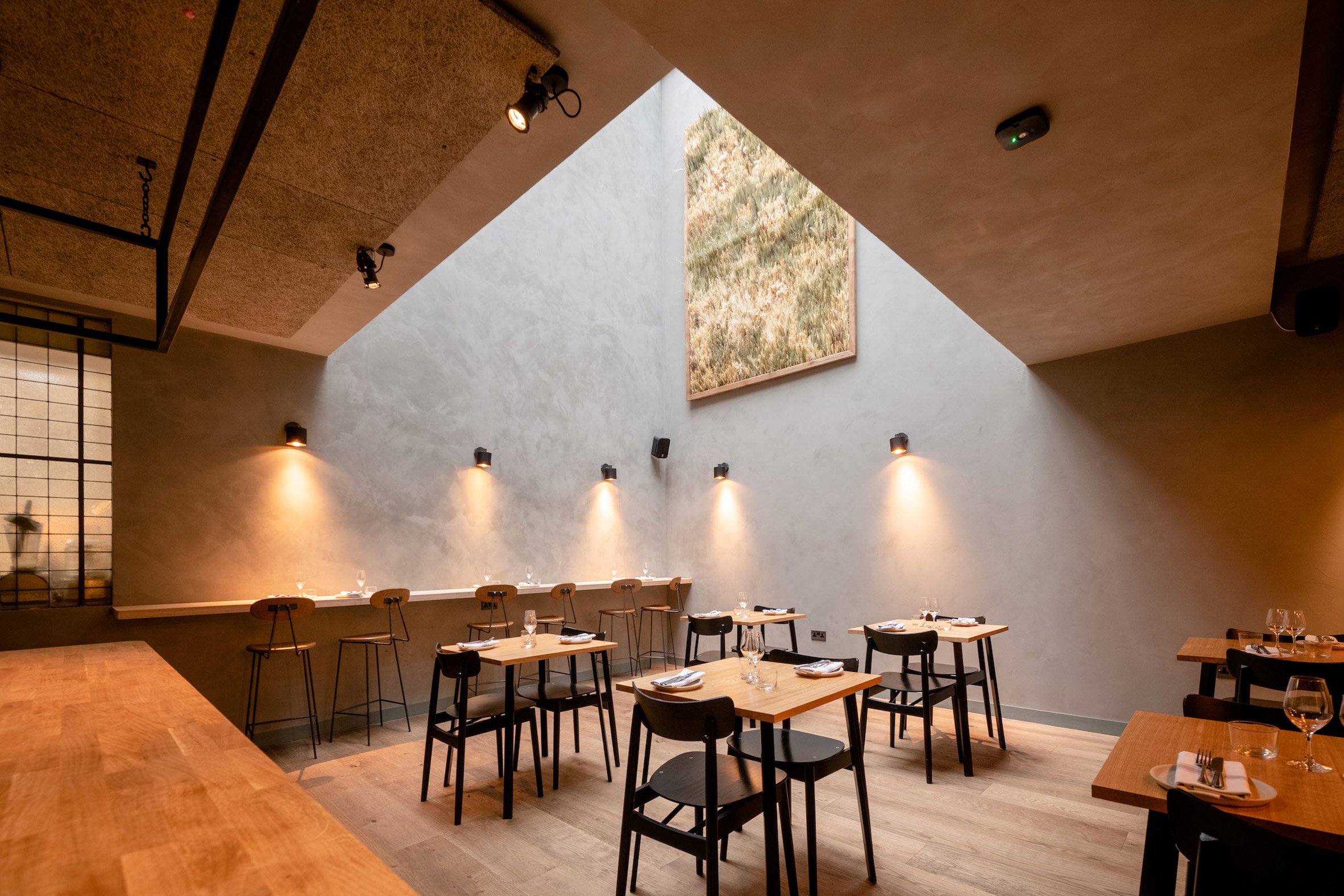 Carousel occupies three converted Georgian townhouses in Fitzrovia
Carousel occupies three converted Georgian townhouses in Fitzrovia
Several design elements from the original restaurant have been repurposed in the new location.
These include the tall metal-clad entrance door, which can now be found at the entrance to one of the dining rooms, and a copper light window that is now installed internally rather than externally. A set of Spanish wall tiles were also carefully removed and now serve as floor tiles.
These are combined with new colours and textures, from materials such as painted brickwork and terrazzo-style tiles.
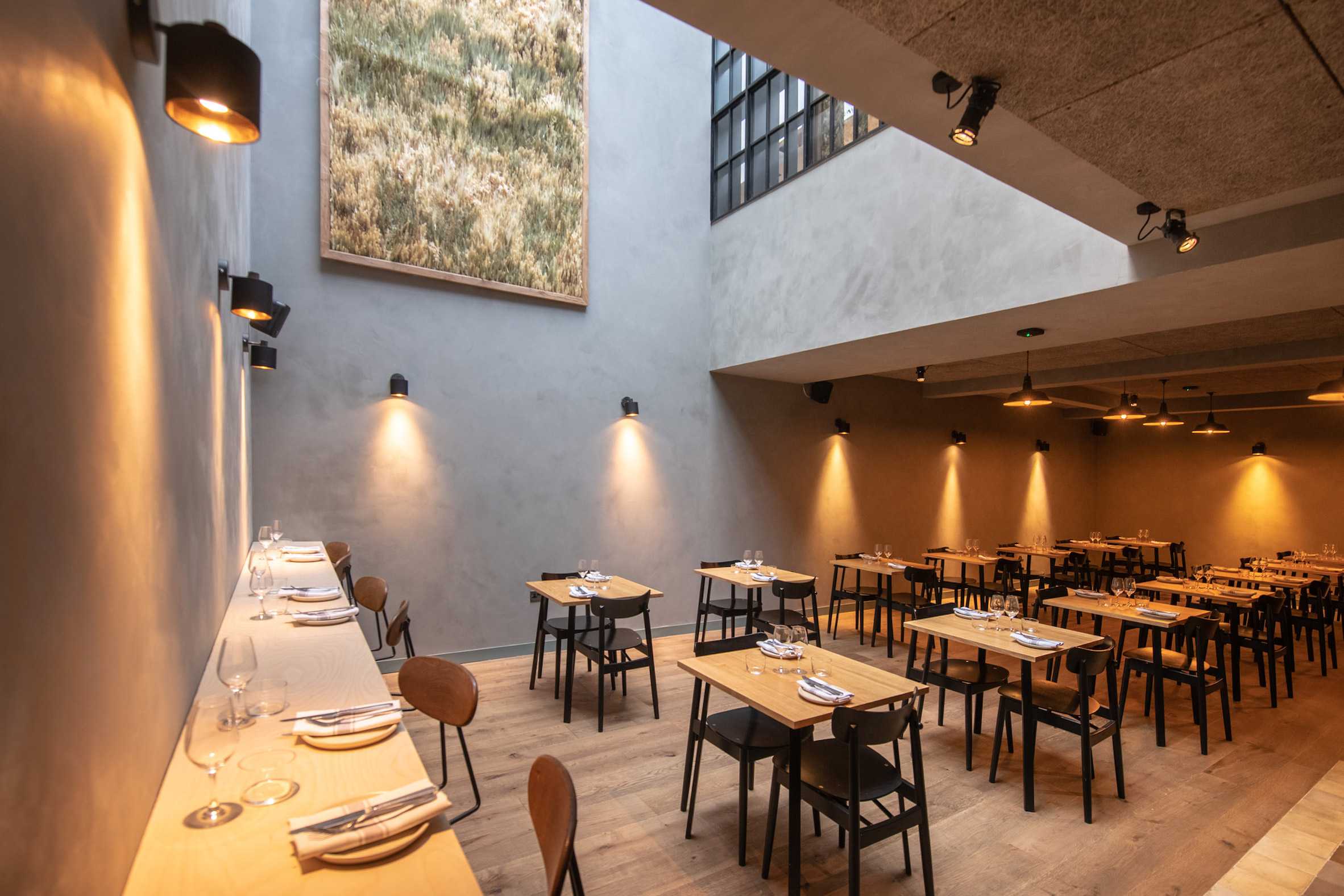 A guest kitchen and dining room is lit from above by a large skylight
A guest kitchen and dining room is lit from above by a large skylight
"Carousel 2.0 was an opportunity to create new spaces which didn't exist in the original Carousel," said Rise Design Studio director Imran Jahn. "But we also did not want to lose the feel of the original."
"We wanted to re-use and recycle," he told Dezeen. "We wanted previous customers and returning guest chefs to be reminded of Carousel 1.0, so we proposed to retain finishes, fixtures and fittings and use them again here."
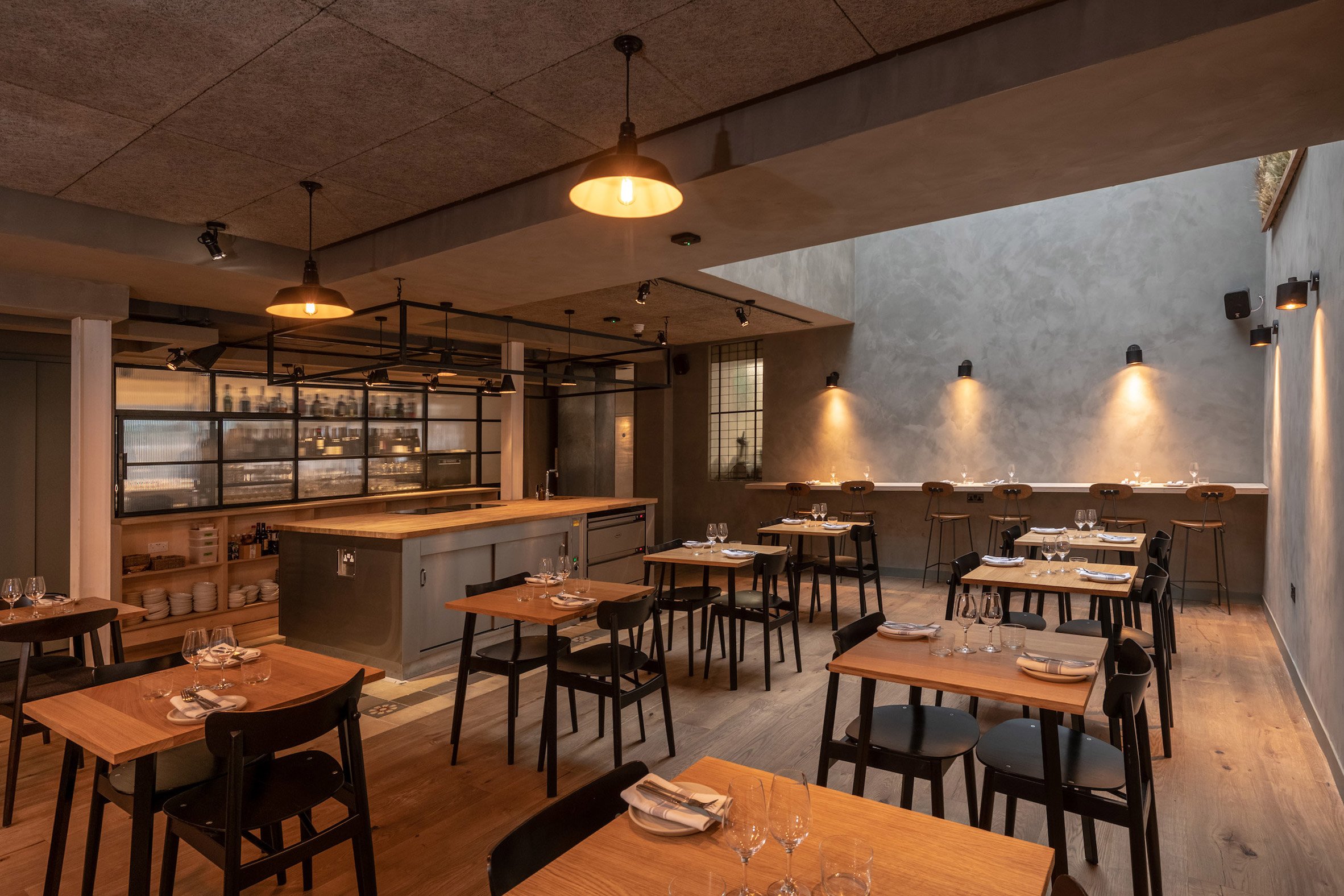 Wall tiles from the previous Carousel venue have been reused here as floor tiles
Wall tiles from the previous Carousel venue have been reused here as floor tiles
The new property gives the restaurant enough space for several dining rooms and kitchens plus, for the first time, a wine bar.
On the ground floor, the bar sits in between an all-day dining room and a space for Carousel's ever-changing roster of guest chefs. The former faces the street, while the latter is lit from above through a lightwell.
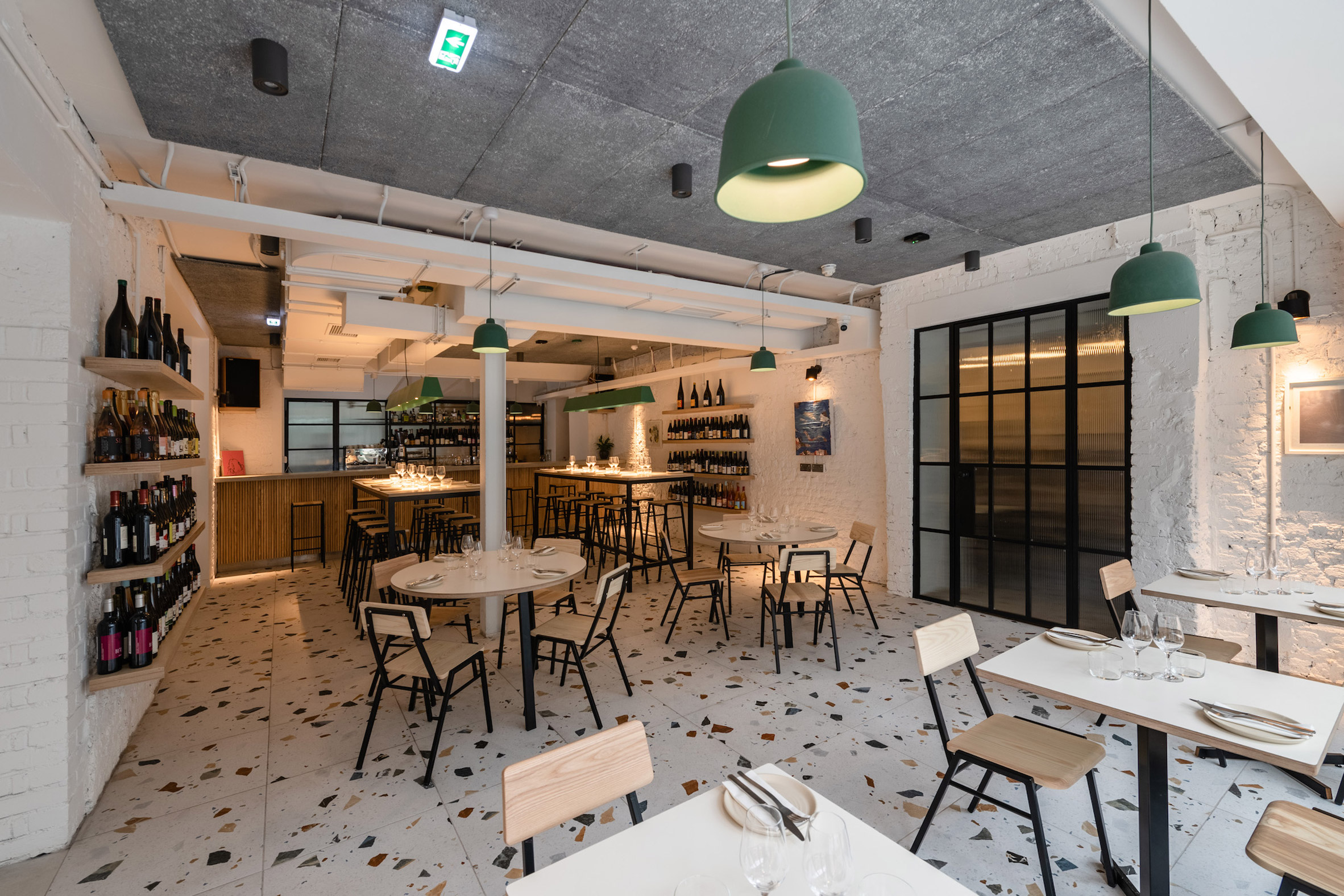 The all-day dining room features painted brickwork and terrazzo-style tiles
The all-day dining room features painted brickwork and terrazzo-style tiles
There's also a separate diner-style restaurant space intended for new dining concept launches, which is currently occupied by Goila Butter Chicken.
Upstairs, a subdividing lounge/events space leads through to a private dining room.
 A wine and cocktail bar is sandwiched between the two ground-floor spaces
A wine and cocktail bar is sandwiched between the two ground-floor spaces
"Ed and Ollie had scoped out a draft layout of the various zones they wanted to create before we were introduced to the project," said Jahn. "They needed our design expertise in interiors to help bring it all together."
A consistent element throughout the interior is the use of industrial-style Crittall screens and doors, which are infilled with fluted glass.
 Concrete counters feature slatted wooden fronts
Concrete counters feature slatted wooden fronts
Several rooms feature walls finished with a type of Nordic plaster that comes in different colours and creates a smooth, durable and multi-tonal surface. The guest kitchen is a mid-grey shade, while the private dining room is soft green.
Other details include concrete counters with wooden slatted fronts, exposed steel structural beams and formica tables.
 An events space leads through to a private dining room
An events space leads through to a private dining room
"The overall tone of the proposals brings together the distinct spaces but allows them to sit happily in their individuality," said Jahn.
"The use of Crittall screens throughout and reeded glazing provides for continuity but also an air of mystery for the viewer wanting to find out more about the partially hidden spaces within."
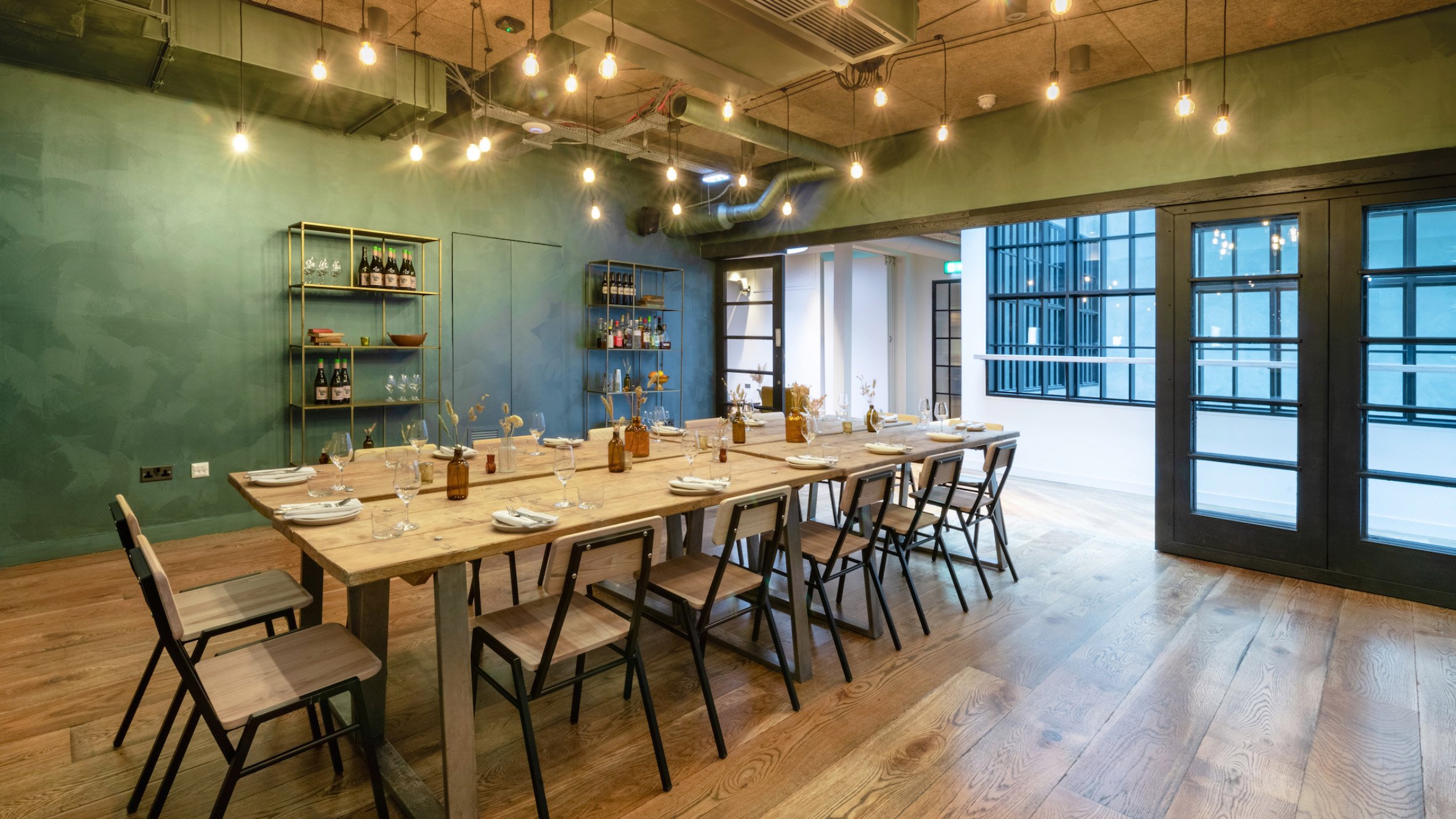 A special type of plaster gives a multi-tonal quality to the walls
A special type of plaster gives a multi-tonal quality to the walls
The new Carousel location welcomed its first diners in November 2021. The all-day menu, prepared by Ollie, includes a range of small plates including beef tartare toast, confit pumpkin with burrata and sage, and grilled mackerel flatbread.
"We've been dreaming about this move for a long time," said Ed. "We loved being a part of the Marylebone community, but we genuinely couldn't have imagined a more exciting neighbourhood, or a more fitting home, to be moving into."
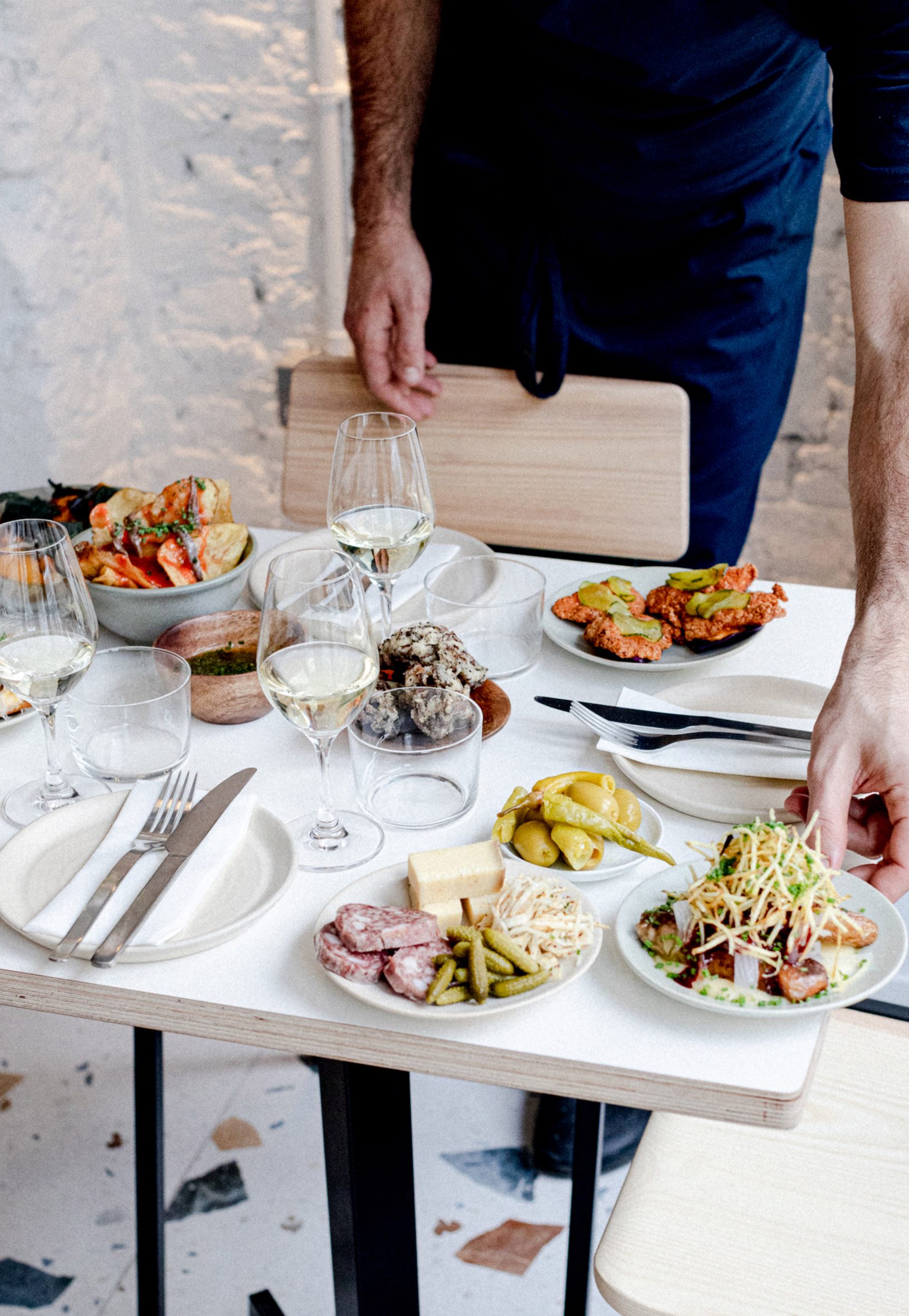 Carousel offers an all-day menu and also hosts a roster of guest chefs
Carousel offers an all-day menu and also hosts a roster of guest chefs
"You'll find all the best bits of the old Carousel in the new space, with some fun additions like the neighbourhood wine bar, where you'll finally be able to experience the kind of food that Ollie likes to cook, in an easygoing all-day setting," he added.
Other recent restaurant openings in London include Kol, a Marylebone eatery with a Mexican menu, and Maido, a sushi restaurant in St John's Wood.
Photography is byJoe Okpako. Video is by Henry Woide.
The post Rise Design Studio opts to "reuse and recycle" for Carousel restaurant interior appeared first on Dezeen.
#restaurantsandbars #all #interiors #videos #london #uk #england #restaurants #interiorsvideos #risedesignstudio
In England und Island können die Menschen sich wieder entspannt nahekommen. Sämtliche Pandemiebeschränkungen werden aufgehoben. Andere Länder haben einen genauen Fahrplan, wann die Restriktionen enden sollen.#Corona #Europa #Lockerungen #England #Island #Slowakei #Italien #Österreich #Deutschland
Europa setzt auf Wegfall der Corona-Regeln | DW | 24.02.2022

no gurantee of completeness! licence is: PUBLIC DOMAIN
How to prepare – civilian survival guide in the case of war or conflict (english, spanish, deutsch, russian, chinese) 2022v1 (16x Pointes) – Cómo prepararse: guía de supervivencia civil en caso de guerra o conflicto (Spanish) – Überlebensleitfaden für Zivilisten im Falle von Krieg oder Konflikt – Comment se préparer – guide de survie civile en cas de guerre ou de conflit (French) – 準備方法-戦争または紛争の場合の民間生存ガイド(Japanese)2022v1(16xポイント)。 – 준비 방법-전쟁 또는 분쟁 (Korean) – Как подготовиться – руководство по выживанию гражданских лиц в случае войны или конфликта (Russian) – Як підготуватися – цивільний посібник з виживання у випадку війни чи конфлікту (Ukrainian) – 如何准备-战争或冲突情况下的平民生存指南(Chinese/Taiwanese)
How to prepare – civilian survival guide in the case of war or conflict (english) 2022v1 (16x Pointes)
1) stock up your supplies on food that can be stored for long (flour, rice, corn & bandage & medicine, put them in plastic boxes in a dry locked room to prevent mouse and mold from destroying it)
2) fuel up your car and other storage of gasoline
3) withdraw money in cash (a visa credit card might be usefull on travel to pay, but in a crisis zone plastics and ATMs might not work (need electricity + internet)
4) Do not wear military clothing
You can’t put on anything camouflage color. If you think that this greenish clothes will make you less visible in the grass or under the trees – the opposite is true. In no case should you be mistaken for the military.
5) Do not wear expensive, bright things
Putting on the most expensive thing in the wardrobe, you can carry it with you, but you will endanger yourself. Marauders and robbers during hostilities primarily pay attention to expensive equipment, clothing, and jewelry.
6) Do not hide under a tall building to hide from bullets
These buildings are visible and can be a guideline for shooting. It is advisable to avoid places that are economically attractive for raiders: gas stations, grocery stores, shopping centers. Where are they hiding?
7) Blood type on the sleeve.
It is important to have either a token with a blood group number with you, or write a blood group in your passport on any page – this will significantly increase the chances of salvation. Children also need to hang the “amulet” on their wrist or neck with a blood group.
8) Do not run from the military
It is necessary to carry out the orders of any people in camouflage uniforms, even if you do not understand what kind of troops it is. For the simple reason that they are armed. Do not argue, the military can consider you provocateurs, scouts, anyone.
9) Do not move at night
Some hope that in the dark it is easier to cross the border or get to the right place. This is not so: at night they shoot indiscriminately. Any suspicious noise can be mistaken for the actions of the enemy and open fire to kill.
10) be your own doctor: If you don’t know how to do it, learn how to provide first aid. In large cities, this is taught in special courses, there are also many benefits on the Internet: both textual and video format.
11) No photos and videos, not even worth watching.
Do not follow the shootout from the window. Do not get close to the windows during active hostilities – this way several people died simply by leaving to film rocket fire.
12) Communication is important in order to receive messages about the situation around and communicate with relatives. Therefore, prepare the radio on batteries, power banks, mobile chargers that can work from the car socket. Write important phone numbers on the paper sheet.
13) Have walkie-talkie houses with a range of at least 1-2 kilometers, one walkie-talkie per family member and keep them charged.
TV, Internet and cellular communications – die very quickly (mobile phone towers have only battery for 30min)
On the radio, most likely, fixated radio messages with standard instructions will go.
14) Remember that calm, preparedness and thoughtfulness of the actions of the civilian population is already effective resistance to the enemy.
Panic destroys more people than bullets and rockets.
15) An alarm & emergency suitcase or how to be partially prepared for what you cannot be prepared for.
16) I see a man in a state of shock. What to do?
“Come, take his hand. Physical contact is a basic, very important thing, ”says psychologist Alexander Gershanov.
According to him, it is important to “return” a person to reality, to distract from stress.
“After physical contact, we can switch to what a person sees around him. In such cases, I ask him:
“You see me?”-” Yes. ” “I’m wearing glasses?“
A stupid question, but a person switches: “Well, yes, with glasses”
If stress does not pass for a long time, you can see old photos, remember stories.
It is important, as far as possible, to regain the sense of the normality of life, to show its continuity.
So that a person does not live only stress.
Psychological trauma can be prevented – if everyone knows in advance what exactly he should do in an emergency.
Then anxiety will be replaced by a sense of business that needs to be done.
“For example, I came across one family with an old grandmother. During the shelling, she did not have time to run out of the apartment, so she simply moved to her safest place. And she had a task: responsibility for the cat. She called her, searched, made sure that she did not run out into the corridor. And that’s right” says Gershanov.
And how to deal with all this yourself?
Here is a list of tips from Alexander Gershanov :
• Calmness, preparedness and thoughtfulness of the actions of the civilian population is already effective resistance to the enemy.
• Learn what exactly you will do in a freelance situation. Understanding the algorithm of actions is the best defense against panic.
• Do not stop doing ordinary things: brush your teeth, work, clean the house. For convenience, you can even write on a piece of paper a list of cases that you need to do in the morning or evening.
• Do not sit in front of news feeds: it only makes stress. You should go to information resources no more than once an hour: faster, the situation usually does not change.
• Do not deny yourself pleasures even during the war. Enjoyment from life should not cause guilt – on the contrary, it gives you strength.
• If you want to join the defense of the country, but you don’t know how to fight, help the army. At least send a message to a friend of the military.
• meet neighbors and act together, this can help psychologically. There are also high chances that you are making better use of the resources available to all of you.
Cómo prepararse: guía de supervivencia civil en caso de guerra o conflicto (Spanish) 2022v1 (16x Pointes)
1) almacene sus suministros en alimentos que puedan almacenarse durante mucho tiempo (harina, arroz, maíz y vendaje y medicamentos, colóquelos en cajas de plástico en una habitación seca y cerrada para evitar que el ratón y el moho lo destruyan)
2) alimentar su automóvil y otro almacenamiento de gasolina
3) retirar dinero en efectivo (una tarjeta de crédito de visa puede ser útil para viajar para pagar, pero en una zona de crisis los plásticos y cajeros automáticos podrían no funcionar (necesita electricidad + internet)
4) No use ropa militar
No puedes poner nada de color camuflaje. Si crees que esta ropa verdosa te hará menos visible en la hierba o debajo de los árboles, lo contrario es cierto. En ningún caso debe confundirse con el ejército.
5) No use cosas caras y brillantes
Poniéndose lo más caro en el armario, puede llevarlo consigo, pero se pondrá en peligro. Los merodeadores y ladrones durante las hostilidades prestan atención principalmente a equipos, ropa y joyas caras.
6) No te escondas debajo de un edificio alto para esconderte de las balas
Estos edificios son visibles y pueden ser una guía para disparar. Es aconsejable evitar lugares que sean económicamente atractivos para los invasores: estaciones de servicio, supermercados, centros comerciales. ¿Dónde se esconden??
7) Tipo de sangre en la manga.
Es importante tener una ficha con un número de grupo sanguíneo con usted o escribir un grupo sanguíneo en su pasaporte en cualquier página; esto aumentará significativamente las posibilidades de salvación. Los niños también necesitan colgar el “amuleto” en su muñeca o cuello con un grupo sanguíneo.
8) No huyas del ejército
Es necesario llevar a cabo las órdenes de cualquier persona con uniformes de camuflaje, incluso si no comprende qué tipo de tropas es. Por la sencilla razón de que están armados. No discutas, los militares pueden considerarte provocadores, exploradores, cualquiera.
9) No te muevas de noche
Algunos esperan que en la oscuridad sea más fácil cruzar la frontera o llegar al lugar correcto. Esto no es así: por la noche disparan indiscriminadamente. Cualquier ruido sospechoso puede confundirse con las acciones del enemigo y abrir fuego para matar.
10) sea su propio médico: si no sabe cómo hacerlo, aprenda a proporcionar primeros auxilios. En las grandes ciudades, esto se enseña en cursos especiales, también hay muchos beneficios en Internet: tanto en formato textual como de video.
11) No hay fotos ni videos, ni siquiera vale la pena verlos.
No sigas el tiroteo desde la ventana. No se acerque a las ventanas durante las hostilidades activas: varias personas murieron simplemente al salir para filmar el lanzamiento de cohetes.
12) La comunicación es importante para recibir mensajes sobre la situación y comunicarse con los familiares. Por lo tanto, prepare la radio con baterías, bancos de energía, cargadores móviles que puedan funcionar desde la toma del automóvil. Escriba números de teléfono importantes en la hoja de papel.
13) Tener casas de walkie-talkie con un alcance de al menos 1-2 kilómetros, un walkie-talkie por miembro de la familia y mantenerlos a cargo.
TV, Internet y comunicaciones celulares: mueren muy rápidamente (las torres de telefonía móvil solo tienen batería durante 30 minutos)
En la radio, lo más probable es que se envíen mensajes de radio fijos con instrucciones estándar.
14) Recuerde que la calma, la preparación y la consideración de las acciones de la población civil ya son una resistencia efectiva al enemigo.
El pánico destruye a más personas que las balas y los cohetes.
15) Una maleta alarmante o cómo estar parcialmente preparado para lo que no puede estar preparado.
16) Veo a un hombre en estado de shock. Qué hacer?
“Ven, toma su mano. El contacto físico es algo básico y muy importante ”, dice el psicólogo Alexander Gershanov.
Según él, es importante “devolver” a una persona a la realidad, distraer del estrés.
“Después del contacto físico, podemos cambiar a lo que una persona ve a su alrededor. En tales casos, le pregunto:
“Me ves?”-” Si. “” Estoy usando anteojos?”
Una pregunta estúpida, pero una persona cambia: “Bueno, sí, con gafas”
Si el estrés no pasa por mucho tiempo, puede ver fotos antiguas, recordar historias.
Es importante, en la medida de lo posible, recuperar el sentido de la normalidad de la vida, mostrar su continuidad.
Para que una persona no viva solo el estrés.
Se puede prevenir el trauma psicológico: si todos saben de antemano qué debe hacer exactamente en caso de emergencia.
Entonces la ansiedad será reemplazada por un sentido de negocio que debe hacerse.
“Por ejemplo, me encontré con una familia con una abuela. Durante el bombardeo, no tuvo tiempo de salir corriendo del departamento, por lo que simplemente se mudó a su lugar más seguro. Y ella tenía una tarea: la responsabilidad del gato. La llamó, buscó, se aseguró de no correr hacia el pasillo. Y eso es correcto “, dice Gershanov.
Y cómo lidiar con todo esto usted mismo?
Aquí hay una lista de consejos de Alexander Gershanov:
• La calma, la preparación y la consideración de las acciones de la población civil ya es una resistencia efectiva al enemigo.
• Aprenda qué hará exactamente en una situación independiente. Comprender el algoritmo de acciones es la mejor defensa contra el pánico.
• No deje de hacer cosas comunes: cepillarse los dientes, trabajar, limpiar la casa. Por conveniencia, incluso puede escribir en un trozo de papel una lista de casos que debe hacer por la mañana o por la noche.
• No se siente frente a las noticias: solo hace estrés. Debe ir a los recursos de información no más de una vez por hora: más rápido, la situación generalmente no cambia.
• No te niegues placeres incluso durante la guerra. El disfrute de la vida no debe causar culpa, por el contrario, le da fuerza.
• Si quieres unirte a la defensa del país, pero no sabes cómo luchar, ayuda al ejército. Al menos envía un mensaje a un amigo del ejército.
• conocer vecinos y actuar juntos, esto puede ayudar psicológicamente. También hay grandes posibilidades de que esté haciendo un mejor uso de los recursos disponibles para todos ustedes.
How to Survival – Überlebensleitfaden für Zivilisten
im Falle von Krieg oder Konflikt
(Deutsch) 2022v1(16x Punkte).odt
1) Lagern Sie Ihre Vorräte mit lang haltbaren Lebensmitteln (Mehl, Nudeln, Reis, Konserven, Hirse, Mais) Verbandsmaterial und Medikamenten an (in verschliessbaren Plastikboxen trocken lagern gegen Mäuse, idealerweise in einem verschlossenen Raum)
2) Tanken Sie Ihr Auto und ErsatzKanister mit Benzin voll
3) Geld in bar abheben (eine Visakreditkarte ist möglicherweise auf Reisen zur Bezahlung nützlich, aber in einer Krisenzone funktionieren Plastikkarten und Geldautomaten möglicherweise nicht (benötigen Sie Strom + Internet))
4) Tragen Sie KEINE Militärkleidung, nichts mit Tarnfarbe oder Grün oder Braun.
In keinem Fall sollten Sie mit dem Militär verwechselt werden.
5) Tragen Sie keine teure, auffalende Kleidung
Wenn Sie das teuerste Ding im Kleiderschrank anziehen, können Sie es bei sich tragen, aber Sie werden sich selbst gefährden. Rumtreiber und Räuber achten während der Feindseligkeiten hauptsächlich auf teure Ausrüstung, Kleidung und Schmuck.
6) Nicht unter hohen Gebäuden verstecken
Diese Gebäude sind gut sichtbar und können als Richtlinie für Bombardierungen genutzt werden.
Es ist ratsam, Orte zu meiden, die für Angreifer wirtschaftlich attraktiv sind: Tankstellen, Lebensmittelgeschäfte, Einkaufszentren. Wo verstecken sie sich?
7) Blutgruppen Typ sollte am Ärmel und Ausweis erkennbar sein
– Blutgruppe in Reisepass schreiben
– Kinder Amulett mit Blutgruppe an Handgelenk oder Hals hängen
– dies erhöht die Wahrscheinlichkeit einer schnellen Behandlung enorm
8) nicht vom Militär weg laufen, provozieren oder streiten
Es ist notwendig, die Befehle von Personen in Tarnuniformen zu beachten, auch wenn Sie nicht verstehen, um welche Art von Truppen es sich handelt, aus dem einfachen Grund, weil diese bewaffnet sind.
9) Bewegen Sie sich Nachts nicht
Einige hoffen, dass es im Dunkeln einfacher ist, die Grenze zu überqueren oder an den richtigen Ort zu gelangen.
Das ist nicht so: Nachts wird auf alles wahllos geschossen was sich bewegt.
Jedes verdächtige Geräusch kann mit den Handlungen des Feindes verwechselt werden und das Feuer zum Töten eröffnet werden.
10) Seien Sie Ihr eigener Arzt: Wenn Sie nicht wissen, wie es geht, lernen Sie, wie Sie Erste Hilfe leisten.
In Großstädten wird dies in speziellen Kursen unterrichtet, es gibt auch viele Vorteile im Internet: sowohl im Text- als auch im Videoformat.
11) Keine Gaffen von Bomben, Granaten, Militär
Verfolgen Sie die Gefechte KEINESFALLS aus dem Fenster, gehen Sie während aktiver Feindseligkeiten nicht in die Nähe der Fenster / Balkon – viele Menschen sind so gestorben.
12) Kommunikation ist wichtig, um Nachrichten über die Situation zu erhalten und mit Verwandten zu kommunizieren.
Bereiten Sie daher ein 12V betreib bares Radio mit Batterien vor, Laden Sie ihre Akkus / Powerbanks und mobilen Geräte. Schreiben Sie wichtige Telefonnummern auf Papier oder drucken diese aus.
13) Besorgen Sie sich Funkgeräte / Walkie-Talkies mit einer Reichweite von mindestens 2 km,
ein Funkgerät pro Familienmitglied und halten Sie sich gegenseitig auf dem Laufenden.
TV, Internet und Mobilfunk – können schon bald ausfallen oder gestört sein (Mobilfunk kann gejammed / gestört werden, Mobiltelefontürme haben nur wenige Minuten Strom aus Akkus und brauchen auch Internet um zu funktionieren)
14) Denken Sie daran, Ruhe, Bereitschaft und vorsichtig geplante Aktionen der Zivilbevölkerung bereits ein wirksamer Widerstand gegen den Feind sind.
Panik zerstört mehr Menschen als Kugeln und Raketen.
15) Ein fertig gepackter Alarm- oder Notfall-Koffer mit ihrem Ausweis / wichtigen Urkunden + Dokumenten + Familienfotos wäre wichtig.
16) Was tun, wenn ein Mensch im Schockzustand verharrt?
„Komm, nimm meine Hand. Körperlicher Kontakt ist eine grundlegende, sehr wichtige Sache “, sagt der Psychologe Alexander Gershanov.
Ihm zufolge ist es wichtig, eine Person in die Realität zurückzubringen, um vom Stress abzulenken.
„Nach physischem Kontakt können wir zu dem wechseln, was eine Person um sich herum sieht. In solchen Fällen frage ich ihn:
„Du siehst mich?”-” Ja. ”
„Trage ich eine Brille?”
Eine dumme Frage, aber eine Person wechselt von der Schock Erfahrung zu einem anderen Thema:
Wenn der Stress lange anhält, können Sie alte Fotos sich ansehen und sich an Geschichten erinnern.
Es ist so weit wie möglich wichtig, das Gefühl für die Normalität des Lebens wiederzugewinnen und seine Kontinuität auf zu zeigen.
Damit eine Person nicht nur im Stress lebt.
Psychologische Traumata können verhindert werden – wenn jeder im Voraus weiß, was genau im Notfall zu tun ist.
Dann wird Angst durch ein Geschäftiges treiben ersetzt, das erledigt werden muss.
„Zum Beispiel bin ich mit einer alten Großmutter auf eine Familie gestoßen. Während des Beschusses hatte sie keine Zeit, die Wohnung zu verlassen, also zog Sie sich einfach an ihren sichersten Ort im Haus zurück und widmete sich der Aufgabe sich um ihre Katze zu kümmern.”
“Sie rief nach der Katze und stellte sicher, dass die Katze sicher ist, Futter und Trinken hat“, sagt Gershanov.
Und wie soll man selbst damit umgeht?
Hier ist eine Liste von Tipps von Alexander Gershanov :
• Ruhe, Bereitschaft und achtsame Planung der Aktionen der Zivilbevölkerung sind bereits ein wirksamer Widerstand gegen den Feind.
• Planen Sie, was genau Sie in welcher Situation machen werden. Handlungsabläufe einstudieren ist ist die beste Verteidigung gegen Panik.
• Hören Sie nicht auf, gewöhnliche Dinge zu tun: Zähne putzen, arbeiten, das Haus putzen. Der Einfachheit halber können Sie sogar eine Liste von Fällen auf ein Blatt Papier schreiben, die Sie morgens oder abends ausführen müssen.
• Setzen Sie sich nicht non-stop den Nachrichten aus: Es macht nur Stress. Sie sollten nicht mehr als einmal pro Stunde die Informationsressourcen abfragen: schneller ändert sich die Situation normalerweise nicht.
• Verweigere Sie sich auch während des Krieges keine Freuden. Genuss aus dem Leben (Kaffee, Schokolade) gibt Ihnen Kraft.
• Wenn Sie sich der Verteidigung des Landes anschließen möchten, aber nicht wissen, wie Sie kämpfen sollen, helfen Sie der Armee. Senden Sie zumindest eine Nachricht an einen Freund des Militärs.
• Treffen Sie ihre Nachbarn und reden Sie miteinadner wie man am besten zusammenarbeiten kann, dies kann psychisch helfen.
Es besteht auch eine hohe Wahrscheinlichkeit, dass Sie Vertrauen auf bauen und die Ihnen allen zur Verfügung stehenden Ressourcen besser nutzen.
Comment se préparer – guide de survie civile en cas de guerre ou de conflit (French) 2022v1 (16x pointes)
1) stockez vos fournitures sur des aliments qui peuvent être stockés pendant longtemps (farine, riz, maïs et pansement et médicaments, mettez-les dans des boîtes en plastique dans une pièce fermée à sec pour empêcher la souris et le moule de les détruire)
2) alimentez votre voiture et autres entreposages d’essence
3) retirer de l’argent en espèces (une carte de crédit visa peut être utile sur les voyages à payer, mais dans une zone de crise, les plastiques et les distributeurs automatiques de billets peuvent ne pas fonctionner (besoin d’électricité + Internet)
4) Ne portez pas de vêtements militaires
Vous ne pouvez rien mettre de couleur camouflage. Si vous pensez que ces vêtements verdâtres vous rendront moins visible dans l’herbe ou sous les arbres – l’inverse est vrai. En aucun cas, vous ne devez être confondu avec l’armée.
5) Ne portez pas de choses chères et lumineuses
En mettant la chose la plus chère dans la garde-robe, vous pouvez la porter avec vous, mais vous vous mettrez en danger. Les maraudeurs et les voleurs pendant les hostilités prêtent principalement attention à l’équipement coûteux, aux vêtements et aux bijoux.
6) Ne vous cachez pas sous un grand bâtiment pour vous cacher des balles
Ces bâtiments sont visibles et peuvent être une ligne directrice pour le tournage. Il est conseillé d’éviter les endroits économiquement attractifs pour les pillards: stations-service, épiceries, centres commerciaux. Où se cachent-ils??
7) Type de sang sur la manche.
Il est important d’avoir un jeton avec un numéro de groupe sanguin avec vous, ou d’écrire un groupe sanguin dans votre passeport sur n’importe quelle page – cela augmentera considérablement les chances de salut. Les enfants doivent également accrocher «l’amulette» au poignet ou au cou avec un groupe sanguin.
8) Ne fuyez pas les militaires
Il est nécessaire de réaliser les ordres de toute personne en uniforme de camouflage, même si vous ne comprenez pas de quel type de troupes il s’agit. Pour la simple raison qu’ils sont armés. Ne discutez pas, les militaires peuvent vous considérer comme des provocateurs, des scouts, n’importe qui.
9) Ne bougez pas la nuit
Certains espèrent que dans l’obscurité, il est plus facile de traverser la frontière ou d’arriver au bon endroit. Ce n’est pas le cas: la nuit, ils tirent sans discernement. Tout bruit suspect peut être confondu avec les actions de l’ennemi et ouvrir le feu pour tuer.
10) soyez votre propre médecin: si vous ne savez pas comment le faire, apprenez à fournir les premiers soins. Dans les grandes villes, cela est enseigné dans des cours spéciaux, il existe également de nombreux avantages sur Internet: à la fois textuel et vidéo.
11) Pas de photos et de vidéos, ça ne vaut même pas la peine d’être regardé.
Ne suivez pas la fusillade depuis la fenêtre. Ne vous approchez pas des fenêtres pendant les hostilités actives – plusieurs personnes sont mortes simplement en partant filmer des tirs de roquettes.
12) La communication est importante pour recevoir des messages sur la situation autour et communiquer avec des proches. Préparez donc la radio sur piles, banques d’alimentation, chargeurs mobiles pouvant fonctionner à partir de la prise de voiture. Écrivez des numéros de téléphone importants sur la feuille de papier.
13) Avoir des maisons de talkie-walkie d’une portée d’au moins 1 à 2 kilomètres, un talkie-walkie par membre de la famille et les garder chargés.
TV, Internet et communications cellulaires – meurent très rapidement (les tours de téléphonie mobile n’ont qu’une batterie de 30 minutes)
À la radio, très probablement, des messages radio réparés avec des instructions standard disparaîtront.
14) N’oubliez pas que le calme, la préparation et la réflexion sur les actions de la population civile constituent déjà une résistance efficace à l’ennemi.
La panique détruit plus de gens que les balles et les roquettes.
15) Une valise alarmante ou comment être partiellement préparé à ce à quoi vous ne pouvez pas vous préparer.
16) Je vois un homme en état de choc. Que faire?
«Viens, prends sa main. Le contact physique est une chose fondamentale, très importante », explique le psychologue Alexander Gershanov.
Selon lui, il est important de «retourner» une personne à la réalité, pour se distraire du stress.
«Après un contact physique, nous pouvons passer à ce qu’une personne voit autour de lui. Dans de tels cas, je lui demande :
“Tu me vois?”-” Oui. “” Je porte des lunettes?”
Une question stupide, mais une personne change: “Eh bien, oui, avec des lunettes”
Si le stress ne passe pas longtemps, vous pouvez voir de vieilles photos, vous souvenir d’histoires.
Il est important, dans la mesure du possible, de retrouver le sens de la normalité de la vie, de montrer sa continuité.
Pour qu’une personne ne vive pas seulement le stress.
Un traumatisme psychologique peut être évité – si tout le monde sait à l’avance ce qu’il doit faire exactement en cas d’urgence.
L’anxiété sera alors remplacée par un sens des affaires qui doit être fait.
«Par exemple, je suis tombé sur une famille avec une vieille grand-mère. Pendant le bombardement, elle n’a pas eu le temps de sortir de l’appartement, alors elle a simplement déménagé dans son endroit le plus sûr. Et elle avait une tâche: la responsabilité du chat. Elle l’a appelée, fouillée, s’est assurée qu’elle ne s’enfuyait pas dans le couloir. Et c’est vrai », explique Gershanov.
Et comment gérer tout cela vous-même?
Voici une liste de conseils d’Alexander Gershanov:
• L’apaisement, la préparation et la réflexion sur les actions de la population civile sont déjà une résistance efficace à l’ennemi.
• Apprenez exactement ce que vous ferez dans une situation indépendante. Comprendre l’algorithme des actions est la meilleure défense contre la panique.
• N’arrêtez pas de faire des choses ordinaires: brossez-vous les dents, travaillez, nettoyez la maison. Pour plus de commodité, vous pouvez même écrire sur un morceau de papier une liste de cas que vous devez faire le matin ou le soir.
• Ne vous asseyez pas devant les flux d’actualités: cela ne fait que du stress. Vous ne devez pas aller aux ressources d’information plus d’une fois par heure: plus vite, la situation ne change généralement pas.
• Ne vous refusez pas les plaisirs même pendant la guerre. Le plaisir de la vie ne doit pas provoquer de culpabilité – au contraire, il vous donne de la force.
• Si vous voulez rejoindre la défense du pays, mais que vous ne savez pas comment vous battre, aidez l’armée. Envoyez au moins un message à un ami de l’armée.
• rencontrer des voisins et agir ensemble, cela peut aider psychologiquement. Il y a également de fortes chances que vous fassiez un meilleur usage des ressources dont vous disposez tous.
準備方法-戦争または紛争の場合の民間生存ガイド(Japanese)2022v1(16xポイント)。
1)長期間保管できる食品に物資を蓄えます(小麦粉、米、トウモロコシ、包帯、薬、乾いた鍵のかかった部屋のプラスチック製の箱に入れて、ネズミやカビが破壊しないようにします)。
2)車やその他のガソリン貯蔵庫に燃料を供給します。
3)現金でお金を引き出す(ビザのクレジットカードは旅行で支払うのに役立つかもしれませんが、危機地帯ではプラスチックとATMが機能しない可能性があります(電気+インターネットが必要)。
4)軍服を着ないでください。
迷彩色を着ることはできません。. この緑がかった服は、芝生や木の下に見えなくなると思うなら、その逆です。. 決してあなたが軍隊と間違われるべきではありません。.
5)高価で明るいものを着用しないでください。
ワードローブで最も高価なものを着て、あなたはそれをあなたと一緒に運ぶことができますが、あなたは自分を危険にさらすでしょう。. 敵対行為中の略奪者と強盗は、主に高価な機器、衣服、宝石に注意を払います。.
6)弾丸から隠すために高い建物の下に隠れてはいけません。
これらの建物は表示され、撮影のガイドラインにすることができます。. 襲撃者にとって経済的に魅力的な場所、ガソリンスタンド、食料品店、ショッピングセンターは避けることをお勧めします。. 彼らはどこに隠れていますか。?
7)スリーブの血液型。.
血液型番号のトークンを用意するか、パスポートの血液型を任意のページに書き込むことが重要です。これにより、救いの可能性が大幅に高まります。. 子供はまた、「お守り」を血液型で手首または首に掛ける必要があります。.
8)軍から逃げないでください。
どんな部隊なのかわからなくても、迷彩服を着た人の命令を出す必要があります。. 彼らが武装しているという単純な理由のため。. 議論しないでください、軍はあなたの挑発者、スカウト、誰でも考えることができます。.
9)夜移動しないでください。
暗闇の中で国境を越えたり、正しい場所に行ったりする方が簡単であることを望んでいる人もいます。. これはそうではありません:彼らは夜に無差別に撃ちます。. 疑わしいノイズは、敵の行動と間違えられ、殺すために発砲する可能性があります。.
10)自分の医者になる:どうすればよいかわからない場合は、応急処置の方法を学んでください。. 大都市では、これは特別コースで教えられており、インターネット上には多くの利点があります。テキスト形式とビデオ形式の両方です。.
11)写真やビデオはなく、見る価値すらありません。.
窓から銃撃戦を追跡しないでください。. 活発な敵対行為の最中に窓に近づかないでください-同じイスラエルでは、ロケット弾を撮影するために去るだけで数人が亡くなりました。.
12)周りの状況についてのメッセージを受け取り、親戚とコミュニケーションをとるためには、コミュニケーションが重要です。. したがって、バッテリー、パワーバンク、自動車ソケットから動作するモバイル充電器にラジオを準備します。. 紙の上に重要な電話番号を書いてください。.
13)少なくとも1〜2 kmの範囲のトランシーバーの家を持ち、家族ごとに1人のトランシーバーを持ち、それらを充電し続けます。.
テレビ、インターネット、携帯電話の通信-非常に迅速に停止します(携帯電話の塔には30分のバッテリーしかありません)。
ラジオでは、おそらく、標準的な指示が記載された固定ラジオメッセージが表示されます。.
14)民間人の行動の穏やかさ、準備、そして思慮深さは、すでに敵に対する効果的な抵抗であることを覚えておいてください。.
パニックは弾丸やロケットよりも多くの人々を破壊します。.
15)警戒すべきスーツケース、または準備できないものに対して部分的に準備する方法。.
16)ショック状態の男性を見ます。. 何をすべきか。?
「さあ、彼の手を取りなさい。. 身体的接触は基本的で非常に重要なことだと心理学者のアレクサンダー・ゲルシャノフは言う。.
彼によると、ストレスから注意をそらすために、人を現実に「戻す」ことが重要です。.
「物理的に接触した後、私たちは人が彼の周りを見ているものに切り替えることができます。. そのような場合、私は彼に尋ねます:。
“あなたは私を見ます。?”-“はい。. 「私は眼鏡をかけています。?”。
愚かな質問ですが、人は「まあ、はい、眼鏡をかけています」と切り替えます。
ストレスが長続きしない場合は、古い写真を見たり、物語を覚えたりできます。.
可能な限り、生命の正常性の感覚を取り戻し、その継続性を示すことが重要です。.
人がストレスだけを生きないように。.
心理的トラウマを防ぐことができます-誰もが事前に彼が緊急時に何をすべきかを知っているなら。.
その後、不安は、実行する必要があるビジネス感覚に置き換えられます。.
「たとえば、私は古い祖母と一緒に1つの家族に出会いました。. 砲撃の間、彼女はアパートを使い果たす時間がないので、彼女は単に彼女の最も安全な場所に移動しました。. そして彼女には、猫の責任という仕事がありました。. 彼女は彼女に電話し、捜索し、廊下に逃げ出さないようにした。. そして、そうです」とGershanovは言います。.
そして、これらすべてを自分で処理する方法。?
以下は、Alexander Gershanovからのヒントのリストです。
•民間人の行動の冷静さ、準備、思慮深さは、すでに敵に対する効果的な抵抗です。.
•フリーランスの状況で正確に何をするかを学びます。. アクションのアルゴリズムを理解することは、パニックに対する最善の防御策です。.
•普通のことをやめないでください。歯を磨き、仕事をし、家を掃除してください。. 便 ⁇ 上、朝または夕方に必要なケースのリストを紙に書くこともできます。.
•ニュースフィードの前に座らないでください。ストレスになるだけです。. 1時間に1回だけ情報リソースに行く必要があります。速くても、状況は通常変わりません。.
•戦争中でも自分の喜びを否定しないでください。. 人生からの楽しみは罪悪感を引き起こすべきではありません-逆に、それはあなたに力を与えます。.
•国の防衛に参加したいが、戦う方法がわからない場合は、軍を助けてください。. 少なくとも軍の友人にメッセージを送ってください。.
•隣人と出会い、一緒に行動する。これは心理的に役立ちます。. また、すべての人が利用できるリソースをより有効に活用する可能性も高いです。.
준비 방법-전쟁 또는 분쟁 (Korean) 2022v1 (16x 포인트)의 경우 민간 생존 가이드
1) 오랫동안 보관할 수있는 음식 (밀가루, 쌀, 옥수수 및 붕대 및 약)에 소모품을 비축하고 마른 방에 플라스틱 상자에 넣어 마우스와 곰팡이가 파괴되지 않도록하십시오
2) 자동차 및 기타 휘발유 저장에 연료를 공급하십시오
3) 현금으로 돈을 인출하십시오 (비자 신용 카드는 여행 할 때 유용 할 수 있지만 위기 지역에서는 플라스틱과 ATM이 작동하지 않을 수 있습니다 (전기 + 인터넷 필요)
4) 군사 복을 입지 마십시오
위장 색상을 입을 수 없습니다. 이 초록색 옷이 잔디 나 나무 아래에서 덜 눈에 띄게 할 것이라고 생각한다면 그 반대입니다. 어떤 경우에도 당신은 군대로 착각해서는 안됩니다.
5) 비싸고 밝은 것을 입지 마십시오
옷장에서 가장 비싼 물건을 입으면 가지고 다닐 수 있지만 위험에 처하게됩니다. 적대 행위 중 약탈자와 강도는 주로 비싼 장비, 의류 및 보석류에주의를 기울입니다.
6) 총알에서 숨기려면 고층 빌딩 아래에 숨지 마십시오
이 건물들은 눈에 띄며 촬영 지침이 될 수 있습니다. 주유소, 식료품 점, 쇼핑 센터 등 해적에게 경제적으로 매력적인 곳을 피하는 것이 좋습니다. 그들은 어디에 숨어 있습니까??
7) 소매에 혈액형.
혈액 그룹 번호가 적힌 토큰을 가지고 있거나 여권에 혈액 그룹을 작성하는 것이 중요합니다. 이는 구원의 기회를 크게 증가시킵니다. 아이들은 또한 혈액 그룹과 함께 손목이나 목에“아뮬렛”을 걸어야합니다.
8) 군대에서 도망 치지 마십시오
어떤 종류의 군대인지 이해하지 못하더라도 위장복을 입은 사람들의 명령을 수행해야합니다. 그들이 무장 한 단순한 이유 때문입니다. 군대는 당신을 도발 자, 스카우트, 다른 사람으로 간주 할 수 있다고 주장하지 마십시오.
9) 밤에 움직이지 마십시오
어떤 사람들은 어둠 속에서 국경을 넘거나 올바른 장소에 가기가 더 쉽기를 바랍니다. 밤에는 무차별 적으로 촬영합니다. 의심스러운 소음은 적의 행동으로 오인되고 사격으로 사살 될 수 있습니다.
10) 자신의 의사가 되십시오 : 어떻게해야할지 모른다면 응급 처치를 제공하는 방법을 배우십시오. 대도시에서는 특별 과정에서 진행되며 인터넷에는 텍스트 및 비디오 형식과 같은 많은 이점이 있습니다.
11) 사진과 비디오가 없으며 시청할 가치조차 없습니다.
창에서 총격전을 따르지 마십시오. 적대 행위 중에 창문에 가까이 가지 마십시오. 같은 이스라엘에서는 로켓 발사로 떠나 여러 사람이 사망했습니다.
12) 주변 상황에 대한 메시지를 받고 친척과 의사 소통하기 위해서는 의사 소통이 중요합니다. 따라서 자동차 소켓에서 작동 할 수있는 배터리, 전원 뱅크, 모바일 충전기의 라디오를 준비하십시오. 종이 시트에 중요한 전화 번호를 쓰십시오.
13) 가족당 1-2km 이상의 워키 토키 하우스를 보유하고 있으며, 가족당 1 개의 워키 토키를 소지하고 요금을 부과합니다.
TV, 인터넷 및 셀룰러 통신-매우 빠르게 죽습니다 (휴대 전화 타워에는 30 분 동안 배터리 만 있음)
라디오에서는 표준 지침이 포함 된 고정 된 라디오 메시지가 나타납니다.
14) 민간인의 행동에 대한 침착하고 준비와 사려 깊음은 이미 적에게 효과적인 저항이라는 것을 기억하십시오.
공황은 총알과 로켓보다 더 많은 사람들을 파괴합니다.
15) 놀라운 여행 가방 또는 준비 할 수없는 것을 부분적으로 준비하는 방법.
16) 충격을받은 사람이 보입니다. 해야 할 일?
“와서 손을 잡아라. 심리학자 알렉산더 게르 샤 노프 (Alexander Gershanov)는“물리적 접촉은 기본적이고 매우 중요한 것”이라고 말했다.
그에 따르면, 사람을 현실로 되돌리고 스트레스를 피하는 것이 중요합니다.
“물리적 접촉 후, 우리는 사람이 주변에서 보는 것으로 바꿀 수 있습니다. 그런 경우 나는 그에게 묻습니다
“당신은 나를 참조하십시오?”-“네. “”안경을 쓰고 있어요?”
어리석은 질문이지만 사람은“글쎄, 안경으로”스위치합니다
스트레스가 오랫동안 지나치지 않으면 오래된 사진을보고 이야기를 기억할 수 있습니다.
삶의 정상 성을 되찾고 그 연속성을 보여주는 것이 가능한 한 중요합니다.
사람이 스트레스 만 살지 않도록.
심리적 외상을 예방할 수 있습니다. 모든 사람이 응급 상황에서 정확히 무엇을해야하는지 미리 알고 있다면.
그러면 불안은 수행해야 할 비즈니스 감각으로 대체 될 것입니다.
“예를 들어, 나는 할머니와 함께 한 가족을 만났습니다. 포격하는 동안 그녀는 아파트에서 도망 갈 시간이 없었기 때문에 가장 안전한 곳으로 이사했습니다. 그리고 그녀는 임무를 가졌습니다 : 고양이에 대한 책임. 그녀는 전화를 걸어 복도로 도망 가지 않았는지 확인했다. 맞습니다.”Gershanov가 말합니다.
그리고이 모든 것을 스스로 다루는 방법?
Alexander Gershanov의 팁 목록은 다음과 같습니다
• 민간인의 행동에 대한 평온, 준비 및 사려 깊음은 이미 적에게 효과적인 저항입니다.
• 프리랜서 상황에서 정확히 무엇을할지 배우십시오. 행동 알고리즘을 이해하는 것이 공황에 대한 최선의 방어입니다.
• 평범한 일을 멈추지 마십시오. 양치질, 일, 집 청소. 편의를 위해 아침이나 저녁에해야 할 경우 목록을 종이에 쓸 수도 있습니다.
• 뉴스 피드 앞에 앉아 있지 마십시오. 스트레스 만 발생합니다. 한 시간에 한 번 이상 정보 리소스로 이동해야합니다. 더 빨리 상황은 일반적으로 변하지 않습니다.
• 전쟁 중에도 즐거움을 부정하지 마십시오. 인생의 즐거움은 죄책감을 유발해서는 안됩니다. 반대로, 그것은 당신에게 힘을줍니다.
• 국가 방어에 참여하고 싶지만 싸우는 방법을 모른다면 군대를 도와주세요. 적어도 군대의 친구에게 메시지를 보내십시오.
• 이웃을 만나고 함께 행동하면 심리적으로 도움이 될 수 있습니다. 또한 모든 사람이 이용할 수있는 리소스를 더 잘 활용할 가능성이 높습니다.
Как подготовиться – руководство по выживанию гражданских лиц в случае войны или конфликта (Russian) 2022v1 (16x Pointes)
1) запастись своими запасами на продуктах питания, которые можно хранить долго (мука, рис, кукуруза, повязка и лекарства, положите их в пластиковые коробки в сухой запертой комнате, чтобы мышь и плесень не могли их уничтожить)
2) заправить свой автомобиль и другие запасы бензина
3) снимать деньги наличными (визовая кредитная карта может быть полезна для оплаты поездки, но в кризисной зоне пластмассы и банкоматы могут не работать (нужна электричество + интернет)
4) Не носите военную одежду
Вы не можете надеть что-нибудь камуфляжное. Если вы думаете, что эта зеленоватая одежда сделает вас менее заметными в траве или под деревьями – все наоборот. Ни в коем случае нельзя принимать вас за военных.
5) Не носите дорогие, яркие вещи
Надевая самую дорогую вещь в гардеробе, вы можете носить ее с собой, но вы подвергнете опасности себя. Мародеры и грабители во время военных действий в первую очередь обращают внимание на дорогостоящее оборудование, одежду и украшения.
6) Не прячься под высоким зданием, чтобы спрятаться от пуль
Эти здания видны и могут быть ориентиром для стрельбы. Желательно избегать мест, которые экономически привлекательны для рейдеров: заправочные станции, продуктовые магазины, торговые центры. Где они прячутся?
7) Тип крови на рукаве.
Важно иметь с собой либо жетон с номером группы крови, либо написать группу крови в своем паспорте на любой странице – это значительно увеличит шансы на спасение. Детям также нужно повесить «амулет» на запястье или шею группой крови.
8) Не убегай от военных
Необходимо выполнять приказы любых людей в камуфляжной форме, даже если вы не понимаете, что это за войска. По той простой причине, что они вооружены. Не спорьте, военные могут считать вас провокаторами, разведчиками, кем угодно.
9) Не двигайся ночью
Некоторые надеются, что в темноте легче пересечь границу или добраться до нужного места. Это не так: ночью они стреляют без разбора. Любой подозрительный шум можно принять за действия врага и открыть огонь для убийства.
10) будьте собственным врачом: если вы не знаете, как это сделать, научитесь оказывать первую помощь. В крупных городах этому преподают на специальных курсах, в Интернете также есть много преимуществ: как текстовый, так и видео формат.
11) Нет фотографий и видео, даже не стоит смотреть.
Не следуйте за перестрелкой из окна. Не подходите близко к окнам во время активных боевых действий – в том же Израиле несколько человек погибли, просто отправившись снимать ракетный огонь.
12) Общение важно для получения сообщений о ситуации вокруг и общения с родственниками. Поэтому подготовьте радио на батареях, банках питания, мобильных зарядных устройствах, которые могут работать из автомобильной розетки. Напишите важные номера телефонов на бумажном листе.
13) Имейте дома рации с радиусом действия не менее 1-2 километров, по одной рации на члена семьи и держите их заряженными.
ТВ, Интернет и сотовая связь – умирают очень быстро (башни мобильных телефонов имеют только аккумулятор в течение 30 минут)
На радио, скорее всего, будут зациклены радиосообщения со стандартными инструкциями.
14) Помните, что спокойствие, готовность и вдумчивость действий гражданского населения уже являются эффективным сопротивлением врагу.
Паника уничтожает больше людей, чем пули и ракеты.
15) Тревожный чемодан или как быть частично подготовленным к тому, к чему вы не можете быть готовы.
16) Я вижу человека в состоянии шока. Что делать?
«Приди, возьми его за руку. Физический контакт – это основная, очень важная вещь », – говорит психолог Александр Гершанов.
По его словам, важно «вернуть» человека в реальность, отвлечь от стресса.
«После физического контакта мы можем переключиться на то, что человек видит вокруг себя. В таких случаях я спрашиваю его:
“Вы видите меня?”-” Да. «Я ношу очки?«
Глупый вопрос, но человек переключается: «Ну, да, в очках»
Если стресс не проходит долгое время, вы можете увидеть старые фотографии, вспомнить истории.
Важно, насколько это возможно, восстановить чувство нормальности жизни, показать ее преемственность.
Так что человек живет не только стрессом.
Психологическая травма может быть предотвращена – если все заранее знают, что именно он должен делать в чрезвычайной ситуации.
Тогда беспокойство будет заменено чувством бизнеса, которое необходимо сделать.
«Например, я встретил одну семью со старой бабушкой. Во время обстрела у нее не было времени выбежать из квартиры, поэтому она просто переехала в свое самое безопасное место. И у нее была задача: ответственность за кошку. Она позвонила ей, обыскала, убедилась, что не выбежала в коридор. И это верно », – говорит Гершанов.
И как справиться со всем этим самостоятельно?
Вот список советов Александра Гершанова:
• Спокойствие, готовность и вдумчивость действий гражданского населения уже являются эффективным сопротивлением врагу.
• Узнайте, что именно вы будете делать в ситуации фрилансера. Понимание алгоритма действий – лучшая защита от паники.
• Не прекращайте делать обычные вещи: чистите зубы, работайте, убирайте дом. Для удобства вы даже можете написать на листе бумаги список дел, которые вам необходимо сделать утром или вечером.
• Не сидите перед новостными лентами: это только вызывает стресс. Вы должны обращаться к информационным ресурсам не чаще одного раза в час: быстрее ситуация обычно не меняется.
• Не отказывайте себе в удовольствиях даже во время войны. Наслаждение жизнью не должно вызывать вины – наоборот, оно дает вам силы.
• Если вы хотите присоединиться к обороне страны, но не знаете, как бороться, помогите армии. По крайней мере, отправить сообщение другу военных.
• встречаться с соседями и действовать сообща, это может помочь психологически. Есть также большие шансы, что вы лучше используете ресурсы, доступные для всех вас.
Як підготуватися – цивільний посібник з виживання у випадку війни чи конфлікту (Ukrainian) 2022v1 (16x Pointes)
1) запасіть запаси на їжу, яку можна довго зберігати (флор, рис, кукурудза та пов’язка та ліки, покладіть їх у пластикові коробки в суху замкнену кімнату, щоб запобігти руйнуванню миші та цвілі)
2) підживлюйте свій автомобіль та інше зберігання бензину
3) зняти гроші готівкою (візова кредитна картка може бути корисною для подорожі, але в кризовій зоні пластмаси та банкомати можуть не працювати (потрібна електроенергія + Інтернет)
4) Не носіть військовий одяг
Ви не можете надіти нічого камуфляжного кольору. Якщо ви думаєте, що цей зеленуватий одяг зробить вас менш помітними в траві або під деревами – правда навпаки. Ні в якому разі не слід помилятися з військовими.
5) Не носіть дорогих, яскравих речей
Одягнувши найдорожчу річ у гардеробі, ви можете носити її з собою, але ви загрожуєте собі. Мародери та грабіжники під час бойових дій в першу чергу звертають увагу на дороге обладнання, одяг та прикраси.
6) Не ховайтеся під високою будівлею, щоб сховатися від куль
Ці будівлі видимі і можуть бути орієнтиром для зйомки. Доцільно уникати місць, які є економічно привабливими для рейдерів: АЗС, продуктові магазини, торгові центри. Де вони ховаються?
7) Тип крові на рукаві.
Важливо мати або лексему з номером групи крові, або написати групу крові у своєму паспорті на будь-якій сторінці – це значно збільшить шанси на порятунок. Дітям також потрібно повісити «амулет» на зап’ясті або шиї з групою крові.
8) Не біжіть від військових
Необхідно виконувати накази будь-яких людей у камуфляжній формі, навіть якщо ви не розумієте, що це за війська. З тієї простої причини, що вони озброєні. Не сперечайтесь, військові можуть вважати вас провокаторами, розвідниками, ким завгодно.
9) Не рухайтесь вночі
Деякі сподіваються, що в темряві легше перетнути кордон або дістатися до потрібного місця. Це не так: вночі вони стріляють без розбору. Будь-який підозрілий шум може бути помилковим за дії ворога та відкритий вогонь для вбивства.
10) будьте власним лікарем: якщо ви не знаєте, як це зробити, навчіться надавати першу допомогу. У великих містах це викладають на спеціальних курсах, в Інтернеті також є багато переваг: як текстовий, так і відеоформат.
11) Ніяких фотографій та відео, навіть не варто дивитися.
Не слідкуйте за перестрілкою з вікна. Не наближайтесь до вікон під час активних бойових дій – в тому ж Ізраїлі кілька людей загинули просто, залишивши знімати ракетний вогонь.
12) Комунікація важлива для того, щоб отримувати повідомлення про ситуацію навколо та спілкуватися з родичами. Тому підготуйте радіо на акумуляторах, банках живлення, мобільних зарядних пристроях, які можуть працювати з розетки автомобіля. На паперовому аркуші запишіть важливі номери телефонів.
13) Майте будинки для рації з дальністю не менше 1-2 кілометрів, по одній вікі-токі на одного члена сім’ї і тримайте їх зарядами.
Телевізор, Інтернет та стільниковий зв’язок – вмирають дуже швидко (у вежах мобільних телефонів є лише акумулятор за 30 хв)
По радіо, швидше за все, будуть встановлені радіоповідомлення зі стандартними інструкціями.
14) Пам’ятайте, що спокій, готовність та продуманість дій цивільного населення вже є ефективним опором противнику.
Паніка знищує більше людей, ніж кулі та ракети.
15) Тривожна валіза або як бути частково підготовленою до того, до чого ви не можете бути готові.
16) Я бачу людину в шоковому стані. Що робити?
«Приходь, візьми його за руку. Фізичний контакт – це основна, дуже важлива річ », – каже психолог Олександр Гершанов.
За його словами, важливо «повернути» людину в реальність, відволіктись від стресу.
«Після фізичного контакту ми можемо перейти до того, що людина бачить навколо себе. У таких випадках я запитую його:
«Ти мене бачиш?”-” Так. “” Я в окулярах?”
Дурне запитання, але людина перемикається: “Ну так, в окулярах”
Якщо стрес не проходить тривалий час, ви можете побачити старі фотографії, запам’ятати історії.
Важливо, наскільки це можливо, повернути відчуття нормальності життя, показати свою наступність.
Так що людина живе не лише стресом.
Психологічну травму можна запобігти – якщо всі заздалегідь знають, що саме він повинен робити в надзвичайних ситуаціях.
Тоді тривога буде замінена почуттям бізнесу, яке потрібно зробити.
«Наприклад, я натрапив на одну сім’ю зі старою бабусею. Під час обстрілів вона не встигла вибігти з квартири, тому просто переїхала до свого найбезпечнішого місця. І у неї було завдання: відповідальність за кота. Вона подзвонила їй, обшукала, переконалася, що вона не вибігла в коридор. І це правильно », – каже Гершанов.
І як впоратися з усім цим самостійно?
Ось список порад Олександра Гершанова:
• Спокій, готовність та продуманість дій цивільного населення – це вже ефективний опір противнику.
• Дізнайтеся, що саме ви будете робити у позаштатній ситуації. Розуміння алгоритму дій – найкращий захист від паніки.
• Не переставайте робити звичайні речі: чистіть зуби, працюйте, прибирайте будинок. Для зручності ви навіть можете написати на аркуші паперу список справ, які вам потрібно зробити вранці чи ввечері.
• Не сидіть перед новинами: це лише робить стрес. Ви повинні ходити на інформаційні ресурси не раз на годину: швидше, ситуація зазвичай не змінюється.
• Не заперечуйте собі задоволення навіть під час війни. Задоволення від життя не повинно викликати провини – навпаки, це дає вам сили.
• Якщо ви хочете приєднатися до оборони країни, але ви не знаєте, як боротися, допоможіть армії. Принаймні надішліть повідомлення другові військових.
• зустрічатися з сусідами та діяти разом, це може допомогти психологічно. Також є великі шанси на те, що ви краще використовуєте доступні для всіх вас ресурси.
如何准备-战争或冲突情况下的平民生存指南(Chinese/Taiwanese)2022v1(16x点)。
1)将您的耗材存放在可以长期存放的食物上(面粉,大米,玉米,绷带和药品,将它们放在干燥的锁着房间的塑料盒中,以防止鼠标和霉菌破坏它)。
2)为您的汽车和其他汽油储存加油。
3)提取现金(签证信用卡在旅行中可能很有用,但是在危机地区,塑料和自动取款机可能不起作用(需要电+互联网)。
4)不要穿军服。
您不能穿上任何伪装颜色。. 如果您认为这种绿色的衣服会使您在草地上或树下不那么明显-相反。. 在任何情况下,您都不应误认为军队。.
5)不要穿昂贵,明亮的东西。
穿上衣柜中最昂贵的东西,您可以随身携带,但会危害自己。. 敌对行动中的掠夺者和强盗主要注意昂贵的设备,衣物和珠宝。.
6)不要躲在高楼下躲避子弹。
这些建筑物是可见的,可以作为射击的指南。. 建议避免在经济上对突袭者有吸引力的地方:加油站,杂货店,购物中心。. 他们藏在哪里。?
7)袖子上的血型。.
重要的是要有一个带有血型编号的令牌,或者在任何页面上在护照上写一个血型-这将大大增加得救的机会。. 孩子们还需要用血型将“护身符”挂在手腕或脖子上。.
8)不要逃离军队。
即使您不了解它是什么样的部队,也有必要执行任何穿着迷彩服的人的命令。. 出于简单的原因,他们武装起来。. 不要争论,军方可以考虑您的挑衅者,侦察兵,任何人。.
9)晚上不要动。
一些人希望在黑暗中更容易越过边界或到达正确的位置。. 事实并非如此:晚上他们会滥杀滥伤。. 任何可疑的噪音都可能误认为是敌人的行为,并开火杀死。.
10)做自己的医生:如果您不知道该怎么做,请学习如何提供急救。. 在大城市,这是通过特殊课程讲授的,互联网也有很多好处:文本和视频格式。.
11)没有照片和视频,甚至不值得观看。.
不要跟随窗户上的枪战。. 在积极的敌对行动中,不要靠近窗户-在同一以色列,几个人只是因为去拍摄火箭弹而死亡。.
12)沟通很重要,以便接收有关周围情况的信息并与亲戚沟通。. 因此,请准备电池,电源,可从汽车插座工作的移动充电器上的收音机。. 在纸上写下重要的电话号码。.
13)拥有至少1-2公里范围的对讲机房屋,每个家庭成员一个对讲机,并保持收费。.
电视,互联网和蜂窝通信-死得很快(手机发射塔只有30分钟的电池)。
在收音机上,很可能会出现带有标准说明的固定无线电消息。.
14)请记住,平民行动的镇定,准备和体贴已经是对敌人的有效抵抗。.
恐慌摧毁的人多于子弹和火箭。.
15)一个令人震惊的手提箱或如何为您无法准备的东西做部分准备。.
16)我看到一个男人处于震惊状态。. 该怎么办。?
“来吧,握住他的手。. 心理学家亚历山大·格沙诺夫(Alexander Gershanov)说,身体接触是基本的,非常重要的事情。.
他认为,重要的是“使”一个人回到现实,分散压力。.
“经过身体接触,我们可以切换到一个人在他周围看到的东西。. 在这种情况下,我问他:
“你看到我了。?“-”是的。. ”“我戴着眼镜。?”。
一个愚蠢的问题,但是一个人切换:“是的,戴着眼镜”。
如果压力不会持续很长时间,您可以看到旧照片,记住故事。.
尽可能重要的是,要恢复生活正常感,以显示其连续性。.
这样一个人就不会仅承受压力。.
可以预防心理创伤-如果每个人都事先知道他在紧急情况下应该做什么。.
然后,焦虑将被需要做的业务感所取代。.
“例如,我遇到了一个家庭和一个老祖母。. 在炮击期间,她没有时间用完公寓,因此她只是搬到了最安全的地方。. 她有一个任务:对猫负责。. 她打电话给她,进行了搜查,以确保她没有跑到走廊里。. 没错”格沙诺夫说。.
以及如何自己处理所有这些。?
这是亚历山大·格沙诺夫(Alexander Gershanov)的提示列表:。
•平民行动的镇定,准备和周到已经是对敌人的有效抵抗。.
•了解在自由职业者情况下您将做什么。. 了解动作算法是防止恐慌的最佳方法。.
•不要停止做普通的事情:刷牙,工作,打扫房子。. 为了方便起见,您甚至可以在纸上写上早晨或晚上需要做的案例清单。.
•不要坐在新闻提要的前面:它只会造成压力。. 您应该每小时最多访问一次信息资源:更快,情况通常不会改变。.
•即使在战争期间也不要否认自己的快乐。. 享受生活不应引起内-相反,它给您力量。.
•如果您想加入该国的防御体系,但您不知道如何战斗,请帮助军队。. 至少向军方朋友发送消息。.
•与邻居见面并共同行动,这在心理上会有所帮助。. 您也很有可能更好地利用所有人可用的资源。.
#linux #gnu #gnulinux #opensource #administration #sysops #catastrophe #madness #war #mankind #man #howto #survival #survive #goodluck #ukraine #taiwan #germany #usa #russia #japan #spain #uk #england #korea
Originally posted at: https://dwaves.de/2022/02/24/how-to-prepare-civilian-survival-guide-in-the-case-of-war-or-conflict-english-spanish-deutsch-russian-chinese-2022v1-16x-pointes-como-prepararse-guia-de-supervivencia-civil-en-caso-de-gu/
Beim letzten Spiel des Vierländerturniers für die deutsche Frauen-Nationalelf verliert das DFB-Team gegen England. Kampf und Einsatzwillen allein reichen nicht aus, um grundlegende Probleme zu überdecken.#Arnold-Clark-Cup #Fußball #Frauen #Nationalmannschaft #Deutschland #England
Arnold-Clark-Cup: DFB-Frauen unterliegen England | DW | 23.02.2022
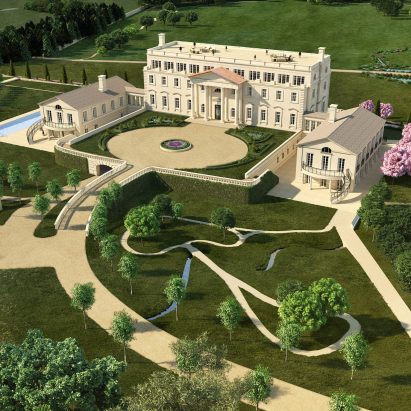
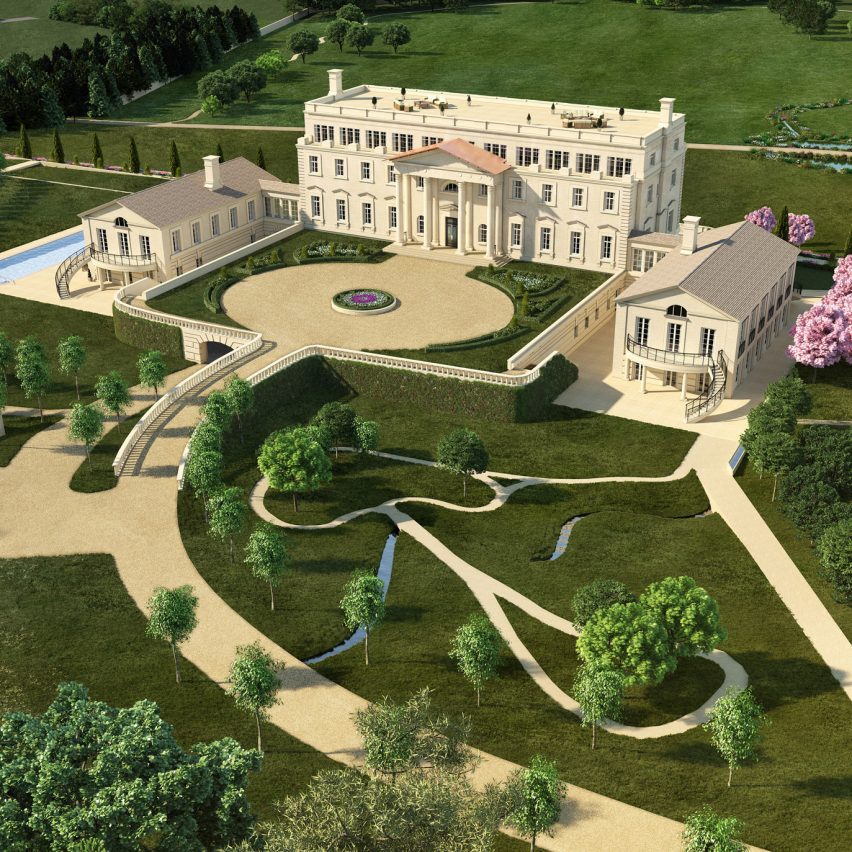
Architect Robert Adam has designed an 11-bedroom neoclassical house for an estate in the Cotswolds near the village of Chipping Norton, UK.
Named St John's House, the 6,692-square-metre home has been drafted for a 60-acre site that is currently being sold by Sotheby's International Realty.
If realised, the house designed by Adam, who was recently a director of British studio Adam Architecture, would become one of the largest new country homes in the UK.
"This would make it not only the largest new home to be built in the UK for over a hundred years, but also the only one built from the ground up," explained Guy Bradshaw, managing director of Sotheby's International Realty.
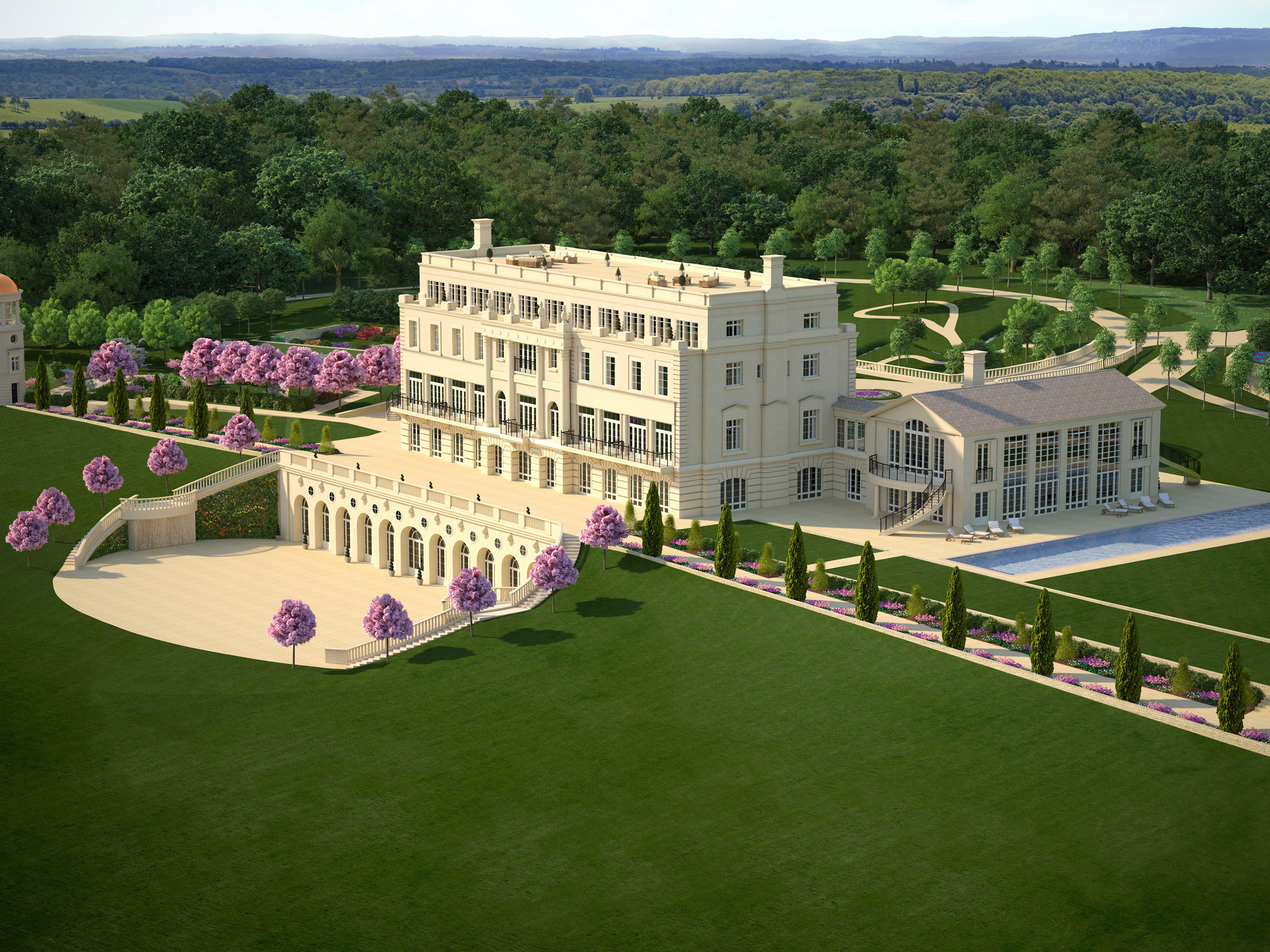 Robert Adam has designed a neoclassical country house in Oxfordshire
Robert Adam has designed a neoclassical country house in Oxfordshire
The home in the Cotswolds Area of Outstanding Natural Beauty was designed by Adam as a modern take on a traditional English country house.
"It is a classical country house, but one that moves the classical tradition forward," Adam told Dezeen.
"The house adds to the country house tradition. Traditions are not static, they move on to adapt to present needs while keeping a clear connection with the predecessors."
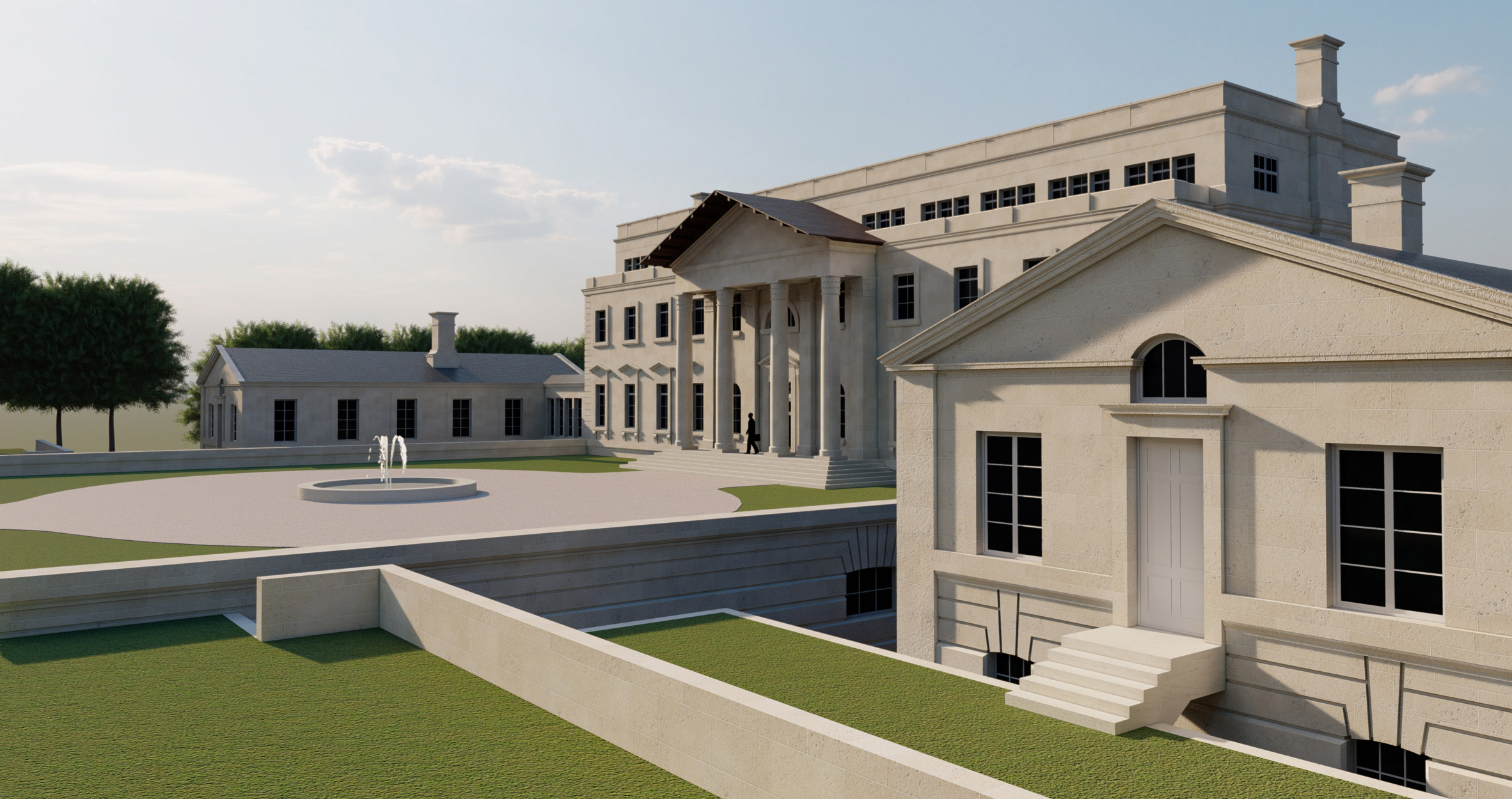 Its main block would be flanked by two wings
Its main block would be flanked by two wings
The home will have a central block with a classical portico in its centre, flanked by two wings extending forward.
Its three-storey main block stands above three semi-subterranean levels that would contain a gym, swimming pool and bowling alley, alongside a garage for 50 cars that is described as a car museum. A ballroom, which opens onto a terrace, would be placed on the lowest level.
The main block would contain a living room and dining room on the ground floor, nine ensuite bedrooms on the level above and two principal suites on the top storey.
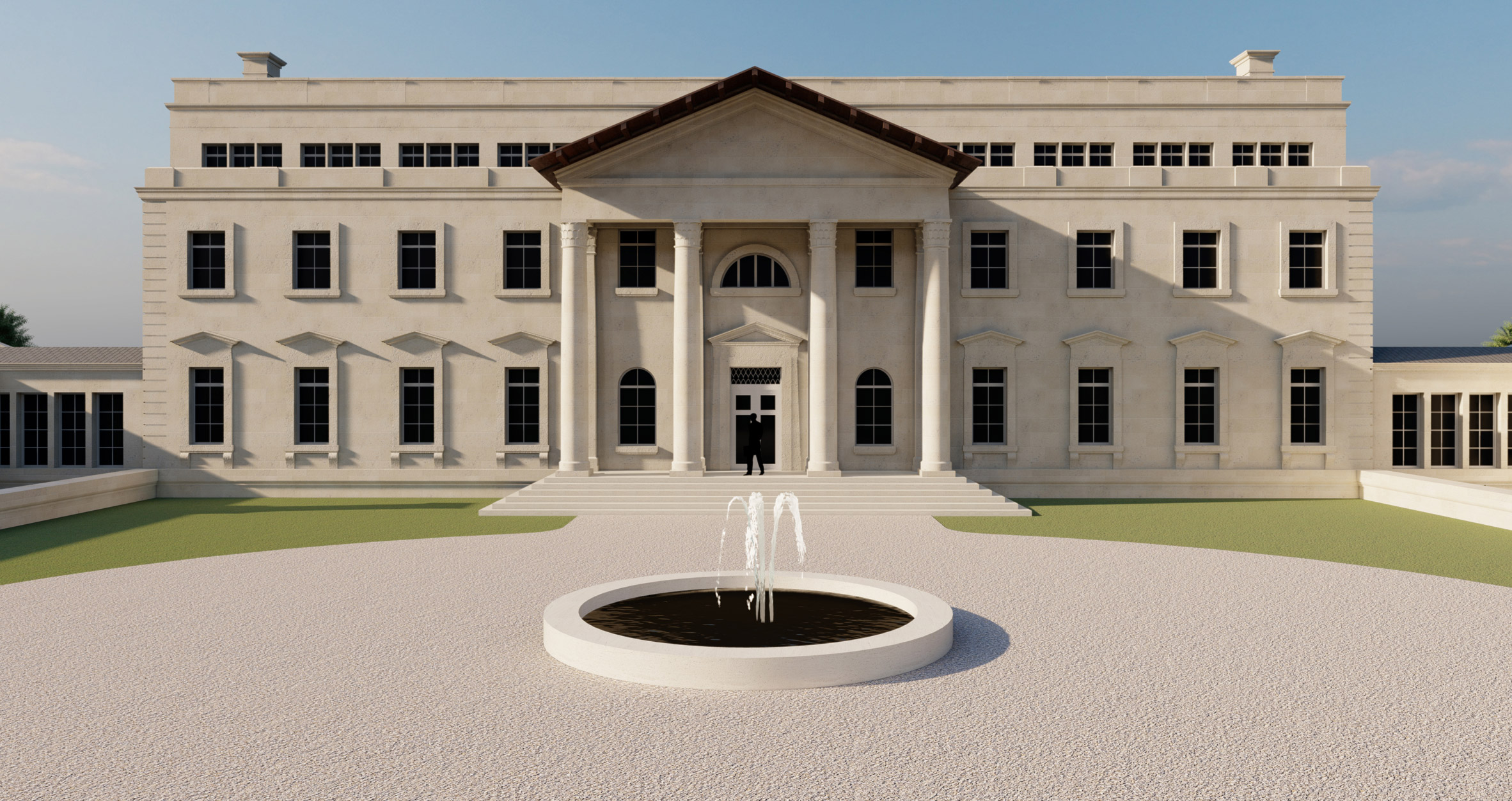 It would have a classical portico
It would have a classical portico
While the house has many typical classical elements, it was not informed by any particular English country home and was designed to contain a number of modern details.
"Other than the fact that all country houses have certain key features – significant entrance, garden facade with outlook, carefully composed approach, main house and ancillary buildings, there is no specific country house from which this design is derived," Adam explained.
[ 
](https://www.dezeen.com/2019/03/22/niall-mclaughlin-architects-hampshire-house-england/)
"It is both classical and modern, this is really the point, these are not incompatible," Adam continued.
"It is part of the tradition but, sometimes in quite subtle ways, moves it on a notch. You don't need to be odd to be modern."
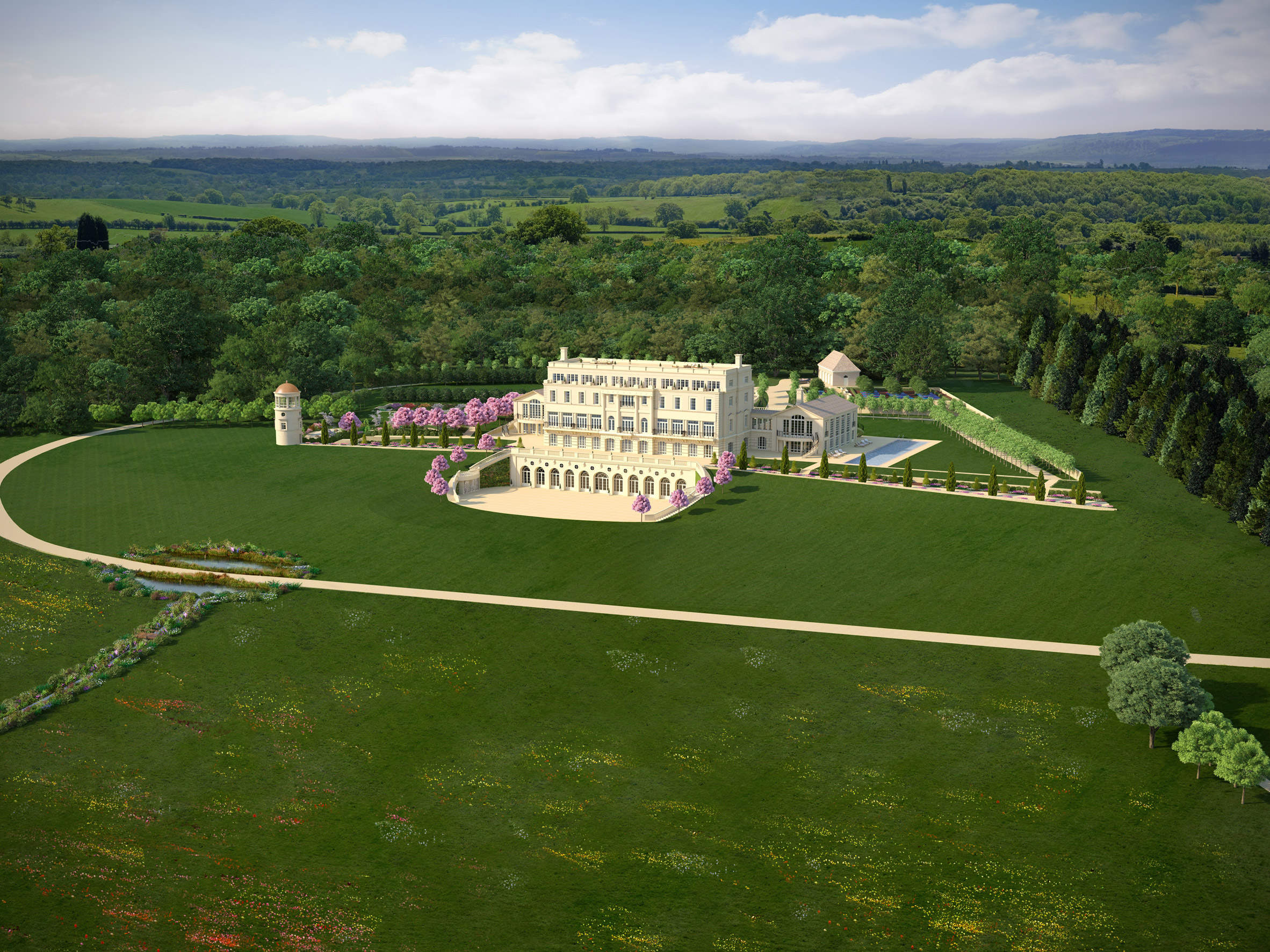 It would be built on a large estate in the Cotswolds
It would be built on a large estate in the Cotswolds
According to Sotheby's International Realty, the planning permission for the home is the result of a "24-year journey". A previous modernist scheme designed for the site by architect Adrian James was granted planning permission in 2004 but not built.
Other recent British country houses featured on Dezeen include a stone residence in a river valley in Hampshire by Niall McLaughlin Architects and a secluded dwelling in Kent that is topped by chimney-like roofs.
The post Robert Adam designs neoclassical country house as "UK's largest new home for over a hundred years" appeared first on Dezeen.
#all #architecture #residential #uk #england #houses #britishhouses #cotswolds
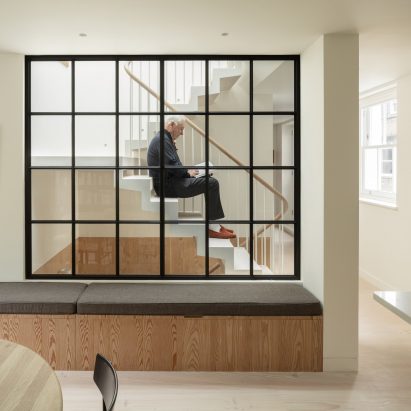
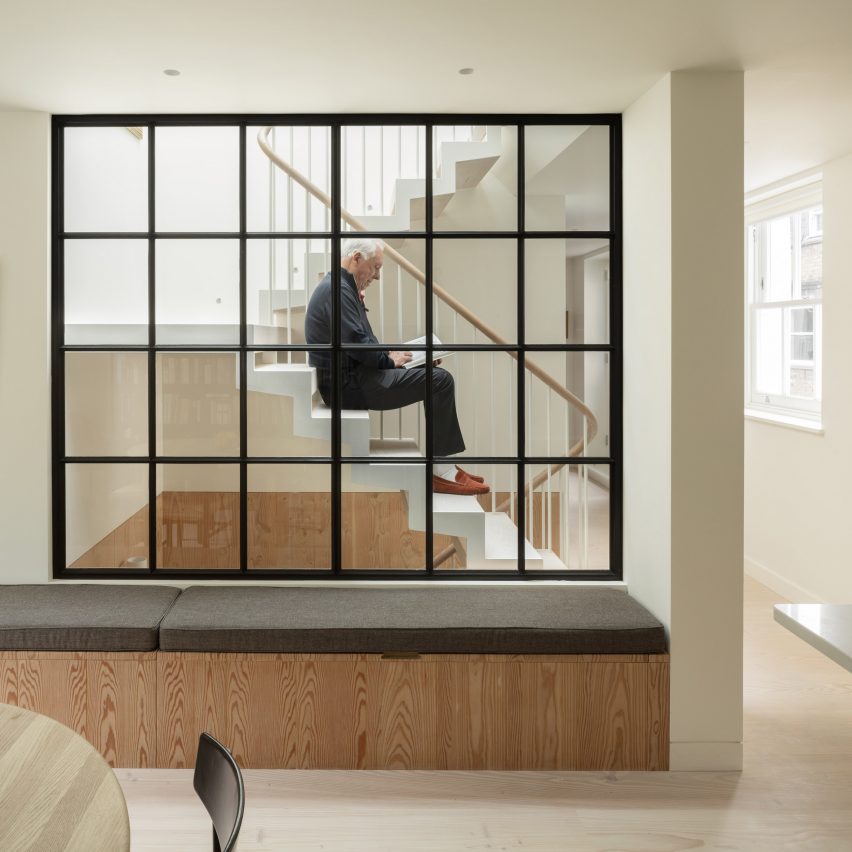
Architect Neil Dusheiko has converted a showroom in west London into a bright, contemporary residence designed to meet the changing needs of its elderly owners.
Nicknamed Danish Mews House for its minimalist Scandinavian furnishings, the home is tucked away in a quiet mews lane in the Lancaster Gate area.
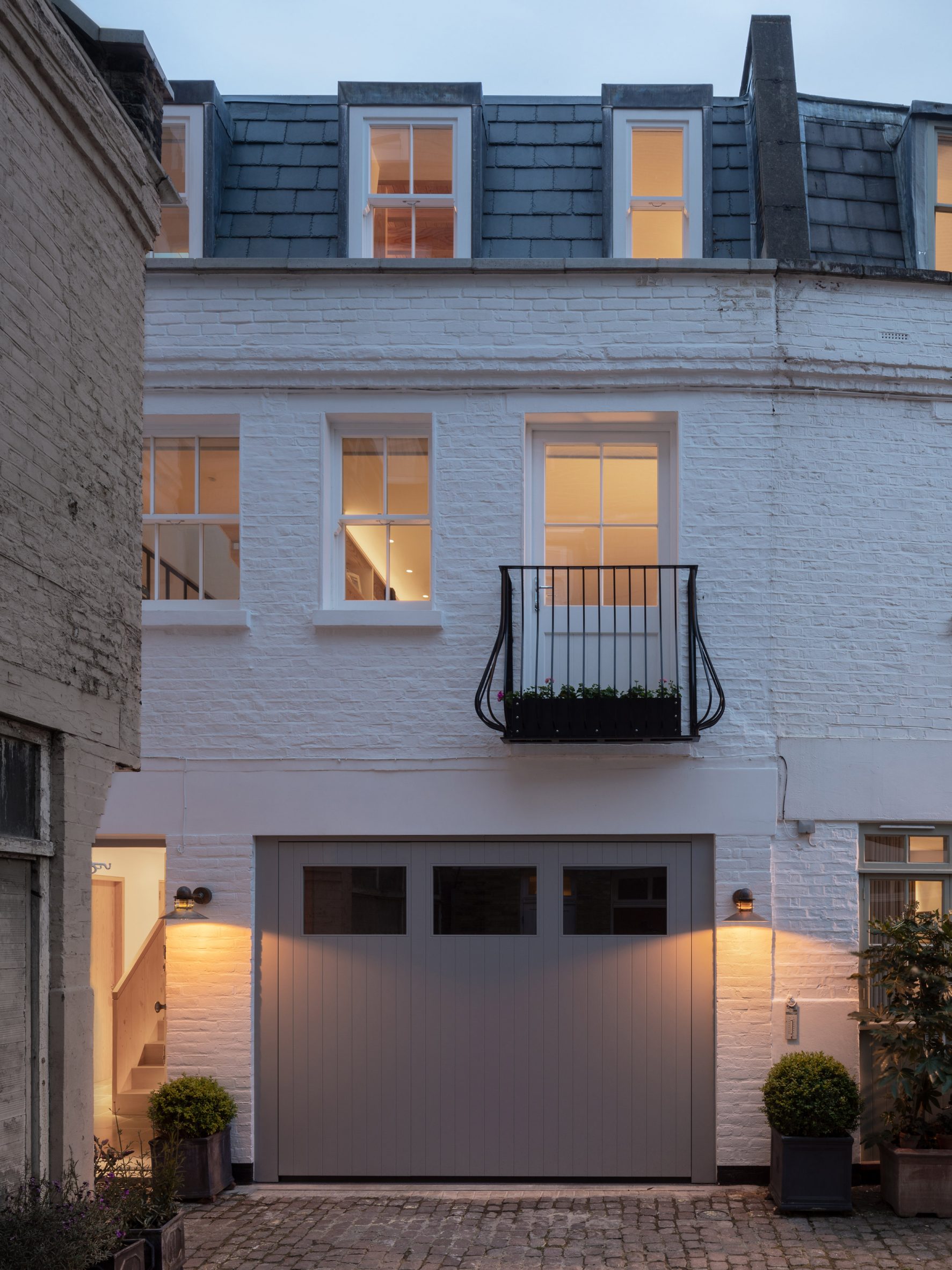 The mews house was once a showroom for the owner's fashion company
The mews house was once a showroom for the owner's fashion company
Although in recent years the current owners repurposed the building as a showroom and warehouse for their clothing company, it was originally built as a Georgian coach house for storing horse-drawn carriages.
Dusheiko's primary concerns when converting the property into a home were bringing in more light, as well as making sure that the interior could support its inhabitants as they grow older.
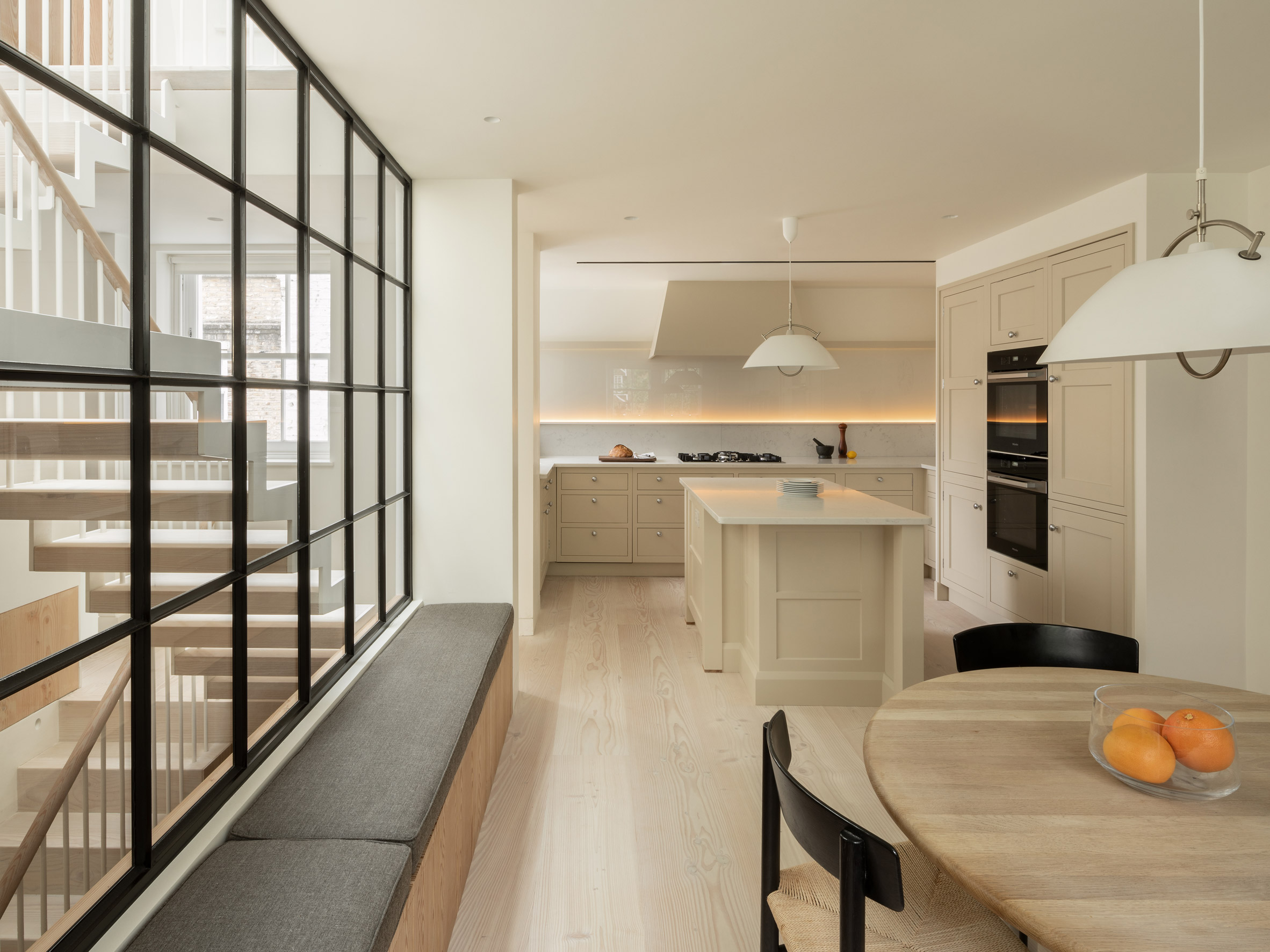 The main kitchen and sitting room are on the first floor
The main kitchen and sitting room are on the first floor
For this purpose, the house was fitted with a guest bedroom, kitchenette and toilet on the ground floor, which could ultimately be used by the inhabitants themselves in case their mobility becomes restricted.
A lift was installed to provide easy access to the upper floors of the house, which can also be reached via a central staircase.
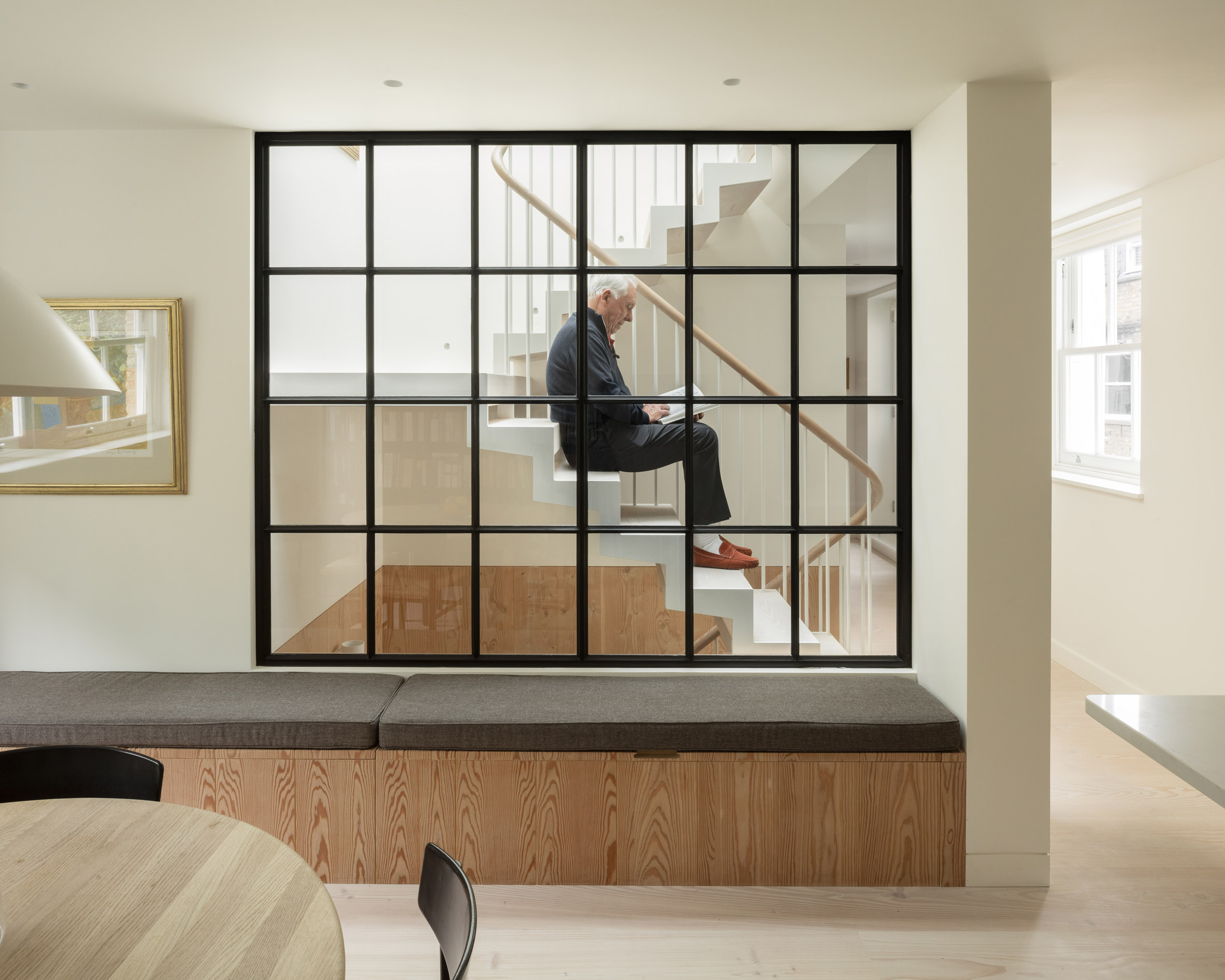 Glazing in the stairwell brings light into the living spaces
Glazing in the stairwell brings light into the living spaces
In the stairwell, a newly installed skylight and a wall of gridded glazing on the first-floor landing allow sunlight to seep into the interior.
Behind the glass partition lies a sitting room and a kitchen with oatmeal-coloured cabinetry as well as a small dining area.
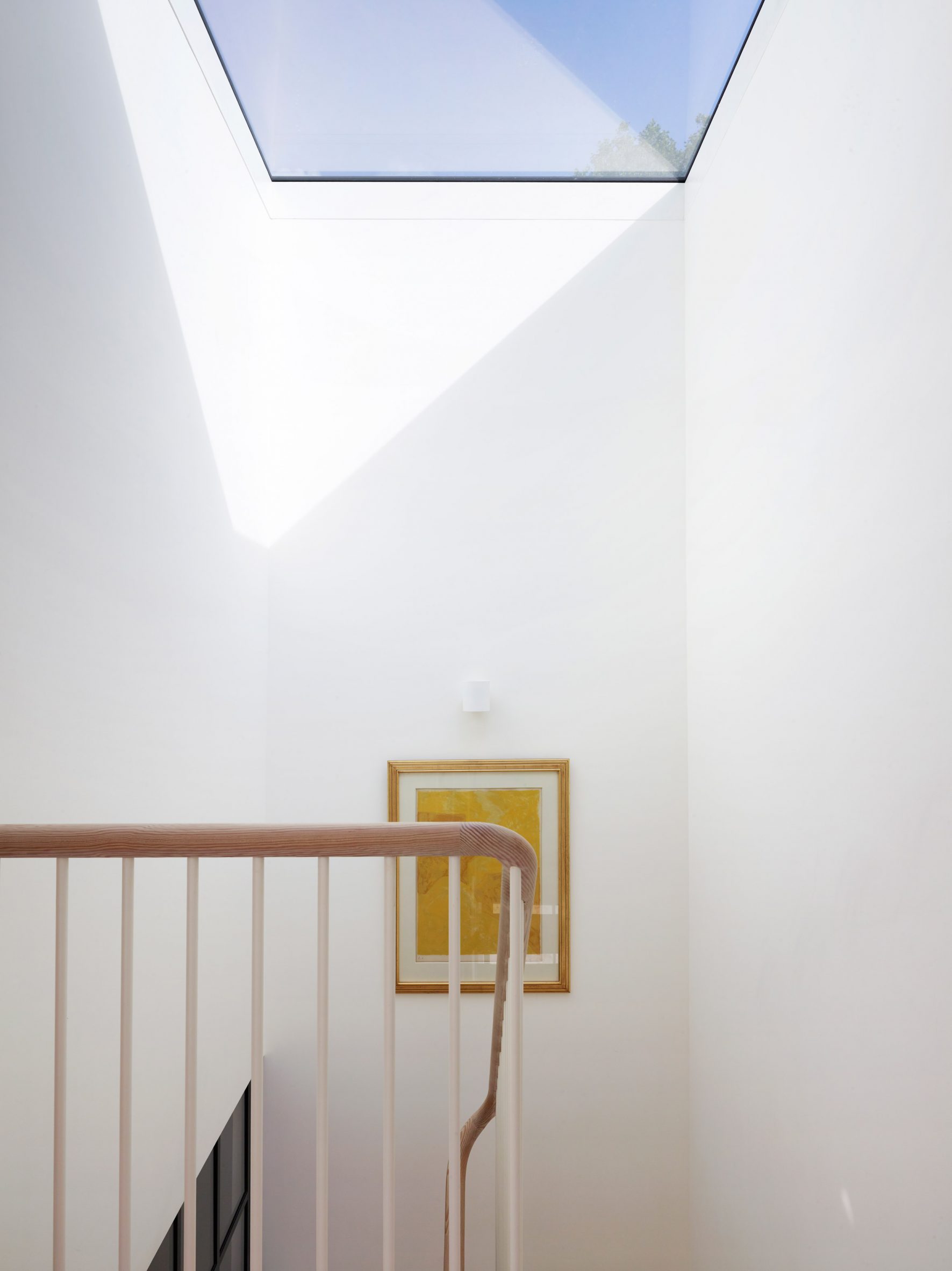 Light leaks in from a skylight at the top of the stairwell. Photo by Rachael Smith
Light leaks in from a skylight at the top of the stairwell. Photo by Rachael Smith
Both here and throughout the rest of the home, several of the furnishings were sourced from well-known Danish design brands including Carl Hansen, Louis Poulsen and Montana.
The second floor is illuminated by six new dormer windows and accommodates another two bedrooms plus their respective en-suite bathrooms.
[ 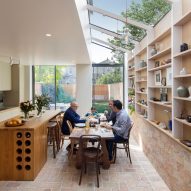
The principal bedroom is largely clad in wood, save for a section on the rear wall that is finished in chintzy floral wallpaper.
Glazed doors with black metal frames run along one side of the room and can be slid open to access a sun terrace lined in Douglas fir battens.
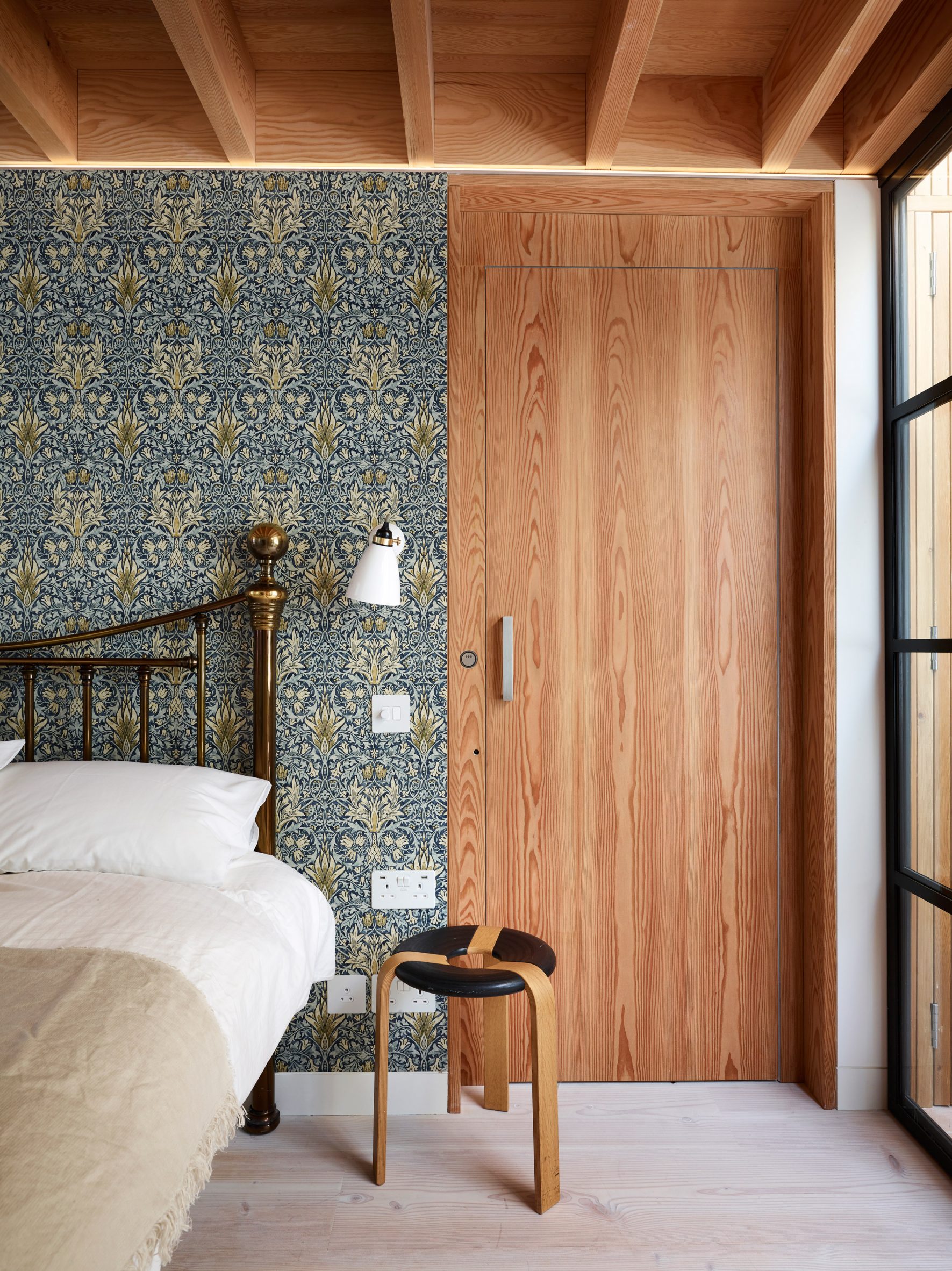 Floral wallpaper features in the principal bedroom. Photo by Rachael Smith
Floral wallpaper features in the principal bedroom. Photo by Rachael Smith
The space is decorated with a couple of folding director's chairs and a built-in white-brick planter.
Danish Mews House is one of several residential projects that Neil Dusheiko has completed in London.
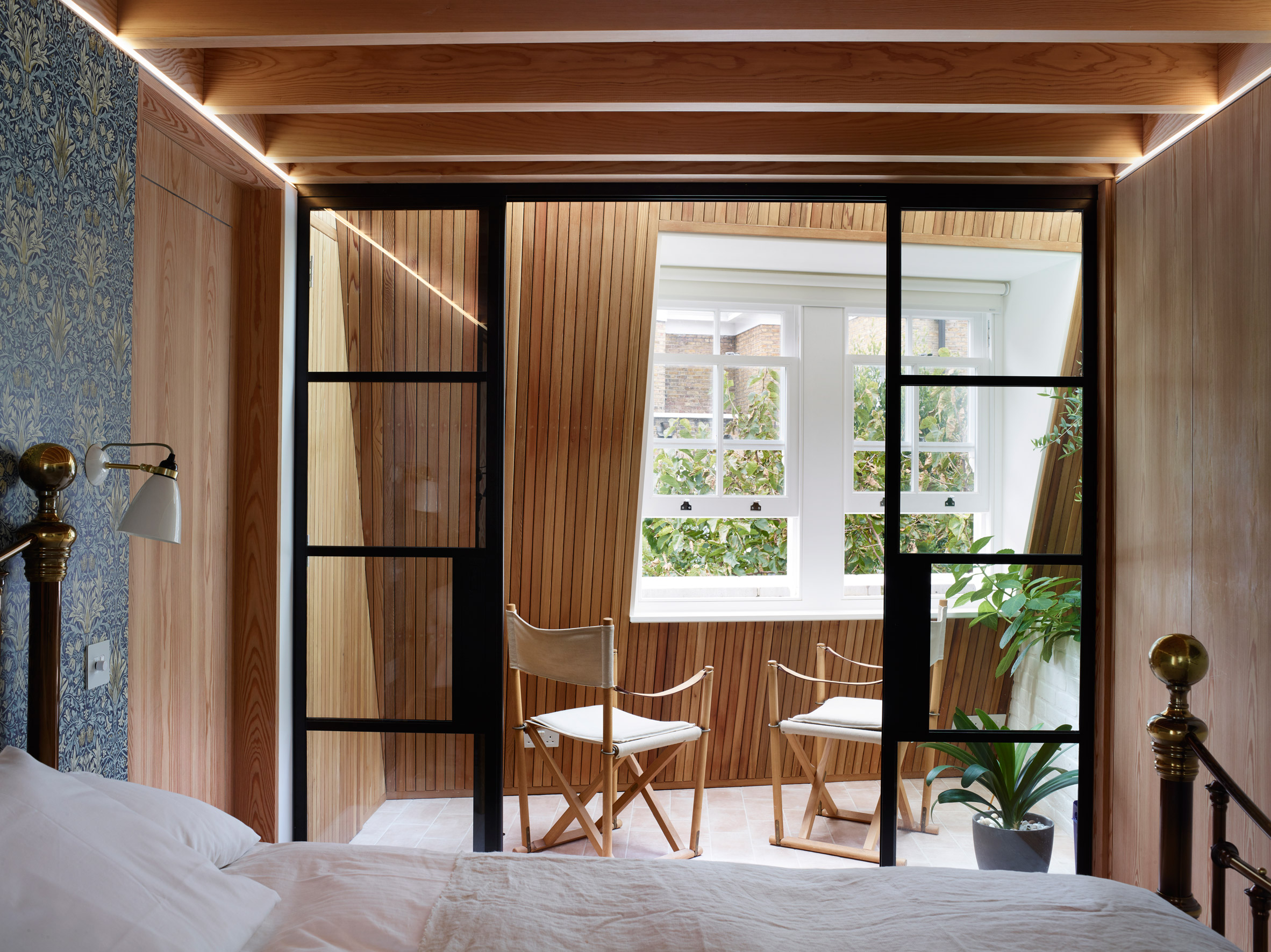 The room also has its own sun terrace. Photo by Rachael Smith
The room also has its own sun terrace. Photo by Rachael Smith
Previously, the architect created a home for his father-in-law in Stoke Newington, in which a striking wall of shelving is used to display ceramics and glassware.
Dusheiko also overhauled a home in Hammersmith, introducing a curved brick extension and a cinema room.
The photography is byStåle Eriksen unless stated otherwise.
Project credits:
Architect: Neil Dusheiko Architects
Structural engineer: Price and Myers
Contractor: ABC Limited
Quantity surveyor: White and Lloyd
The post Neil Dusheiko transforms London fashion showroom into light-filled home appeared first on Dezeen.
#all #interiors #residential #london #uk #england #houses #neildusheiko #designfortheelderly #britishhouses #residentialconversions #londonhouses #adaptivereuse